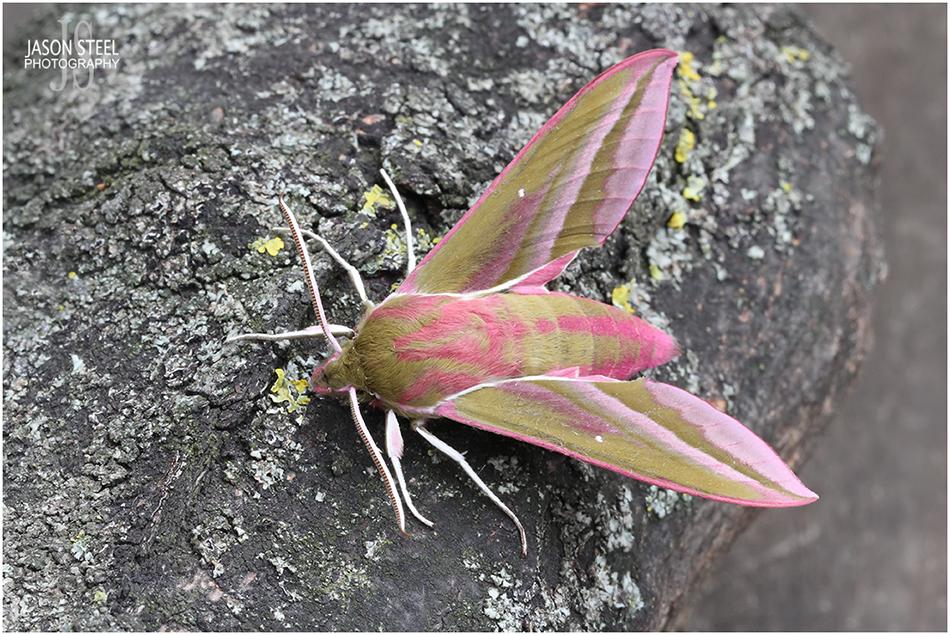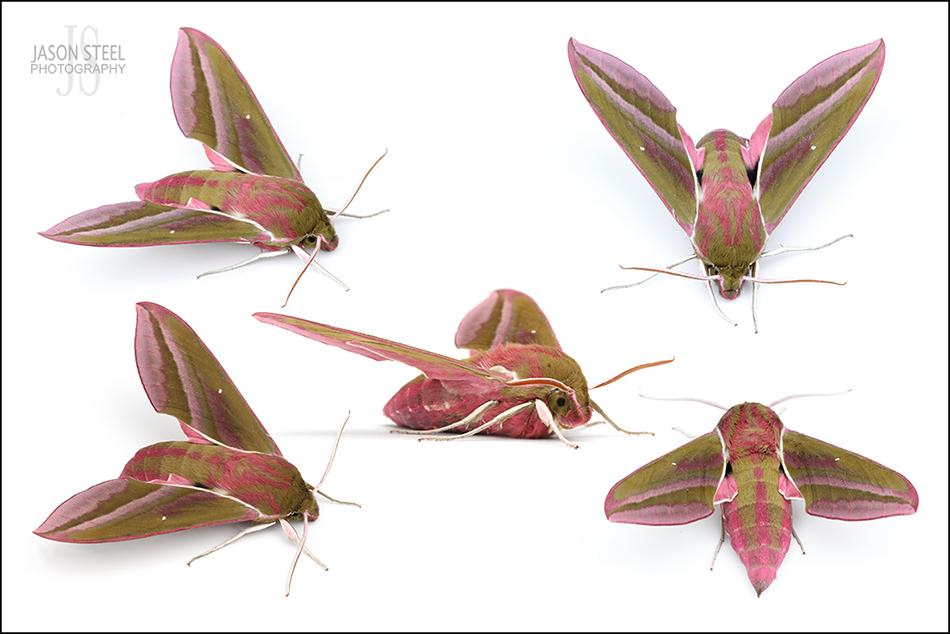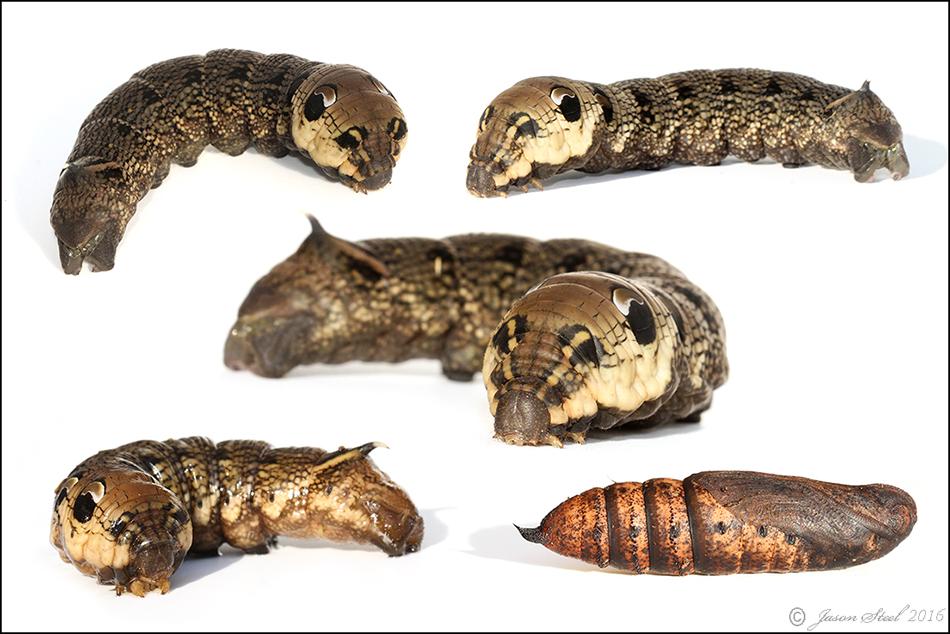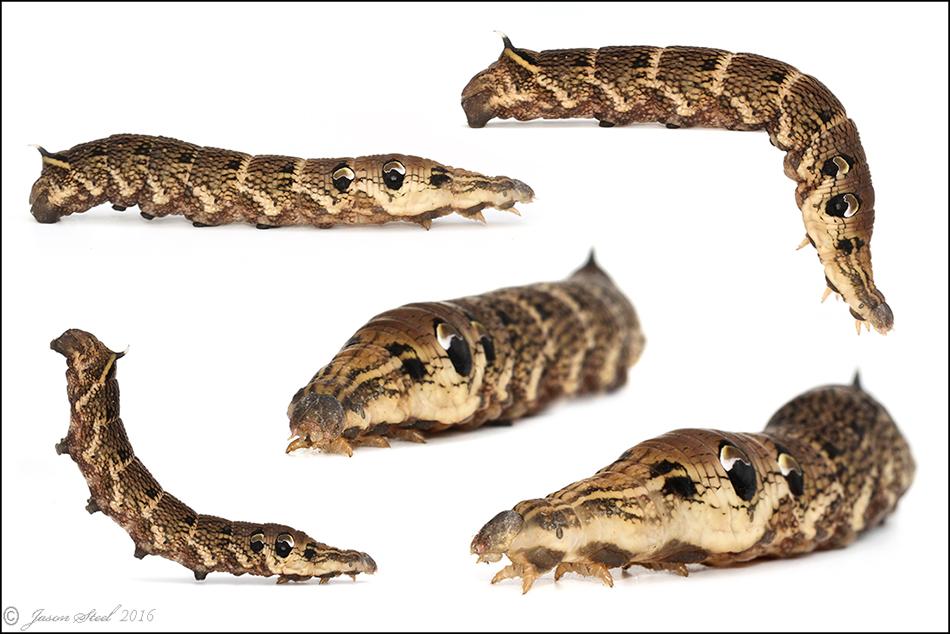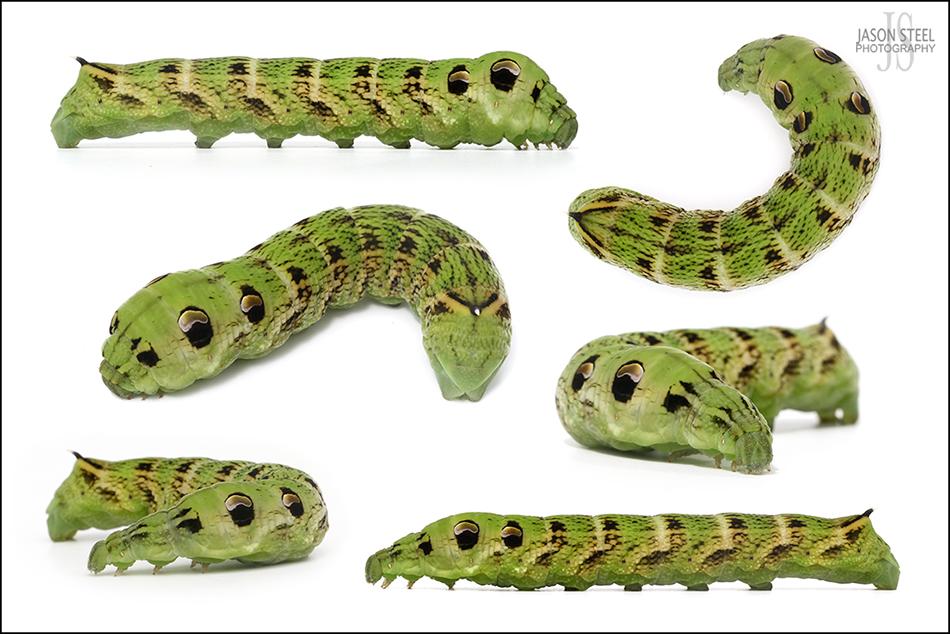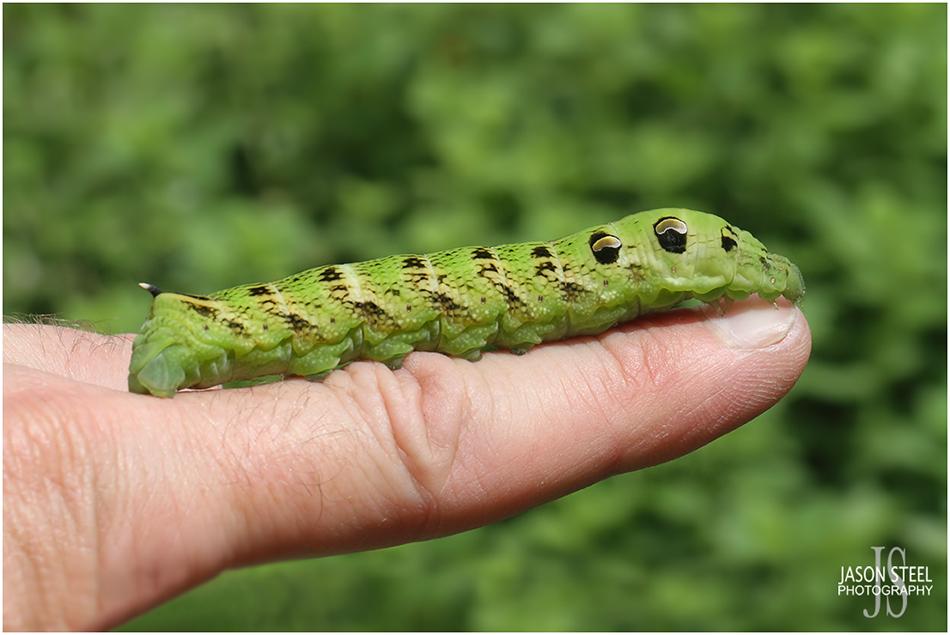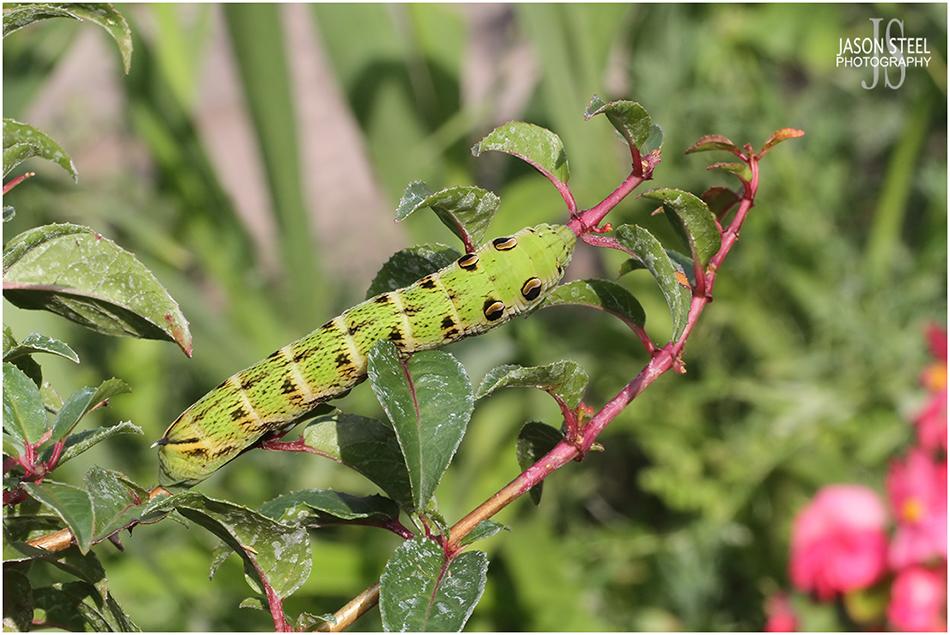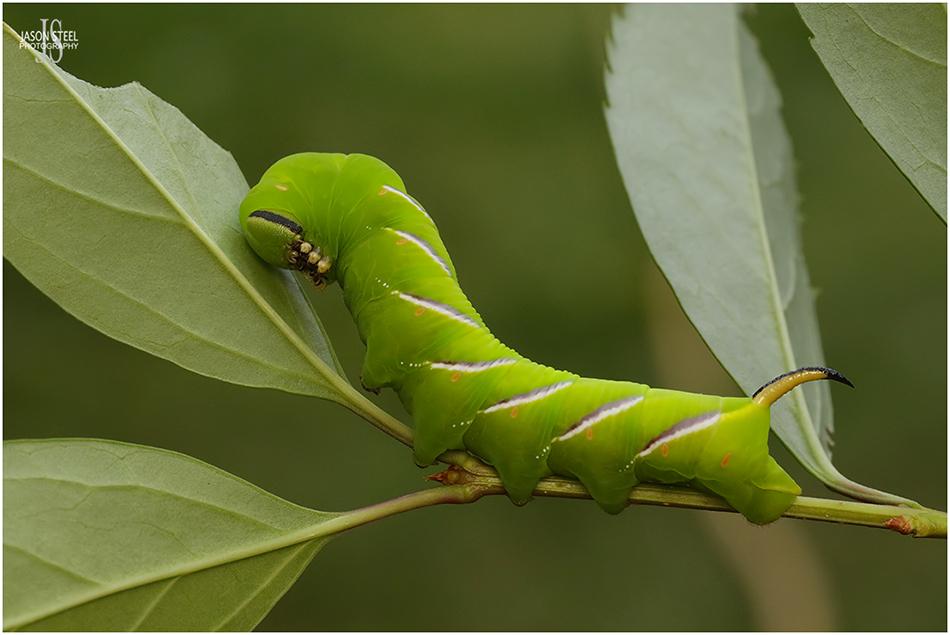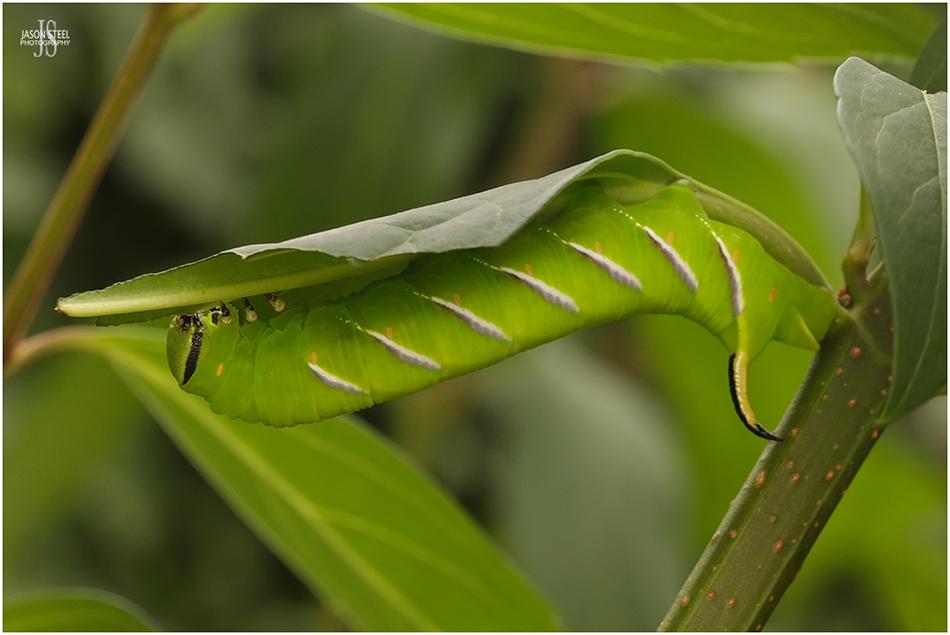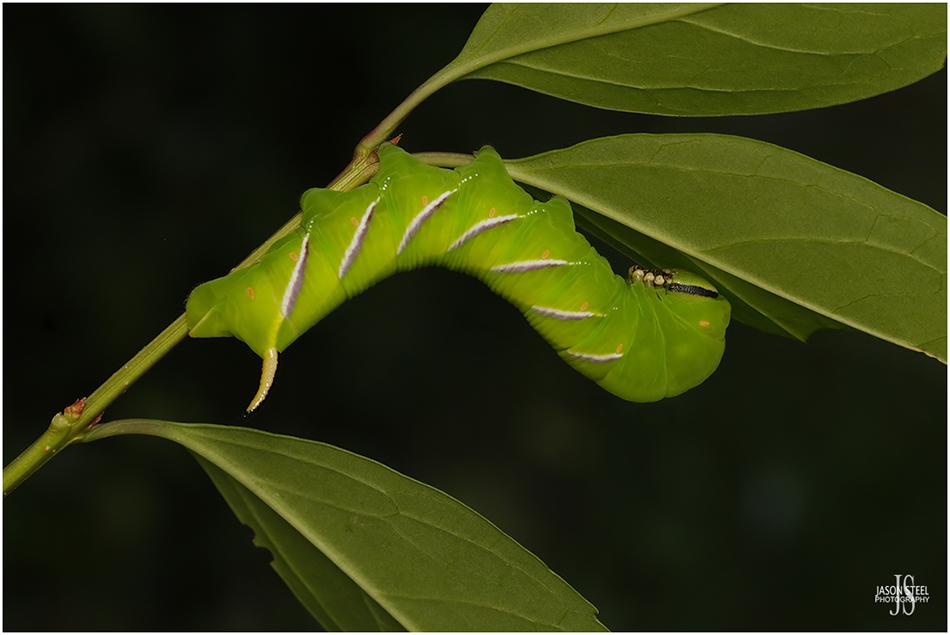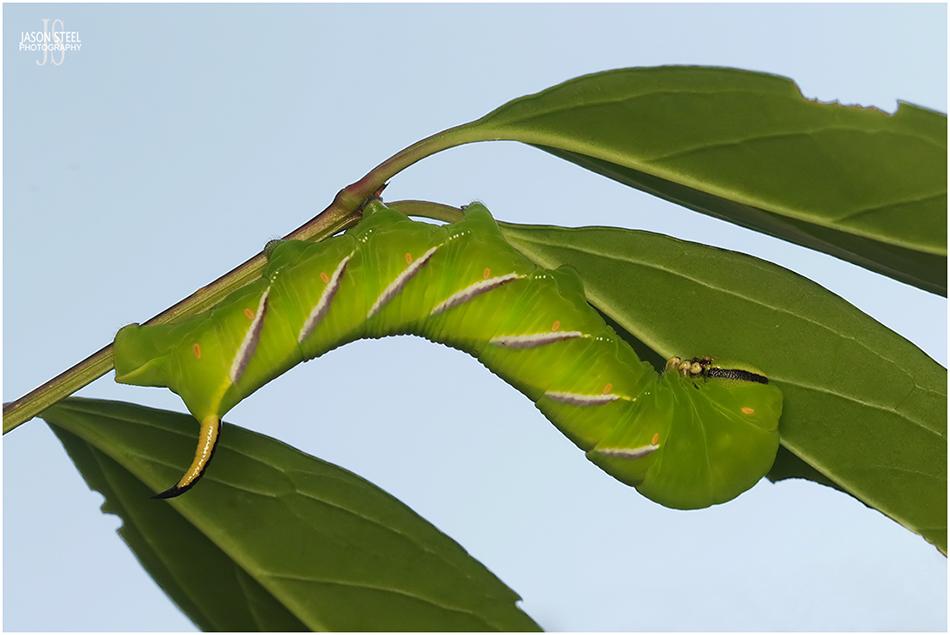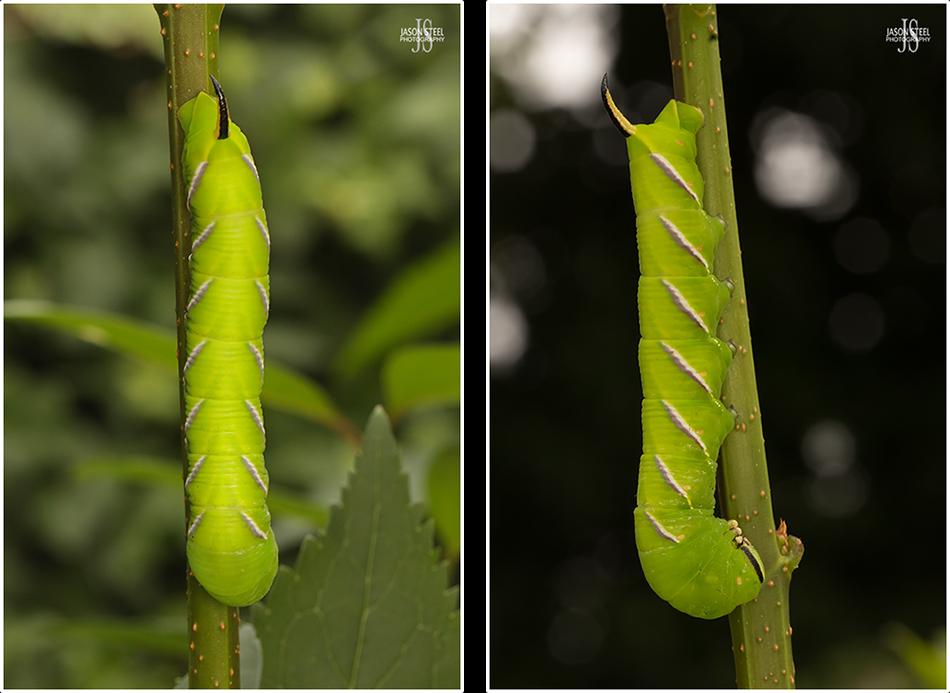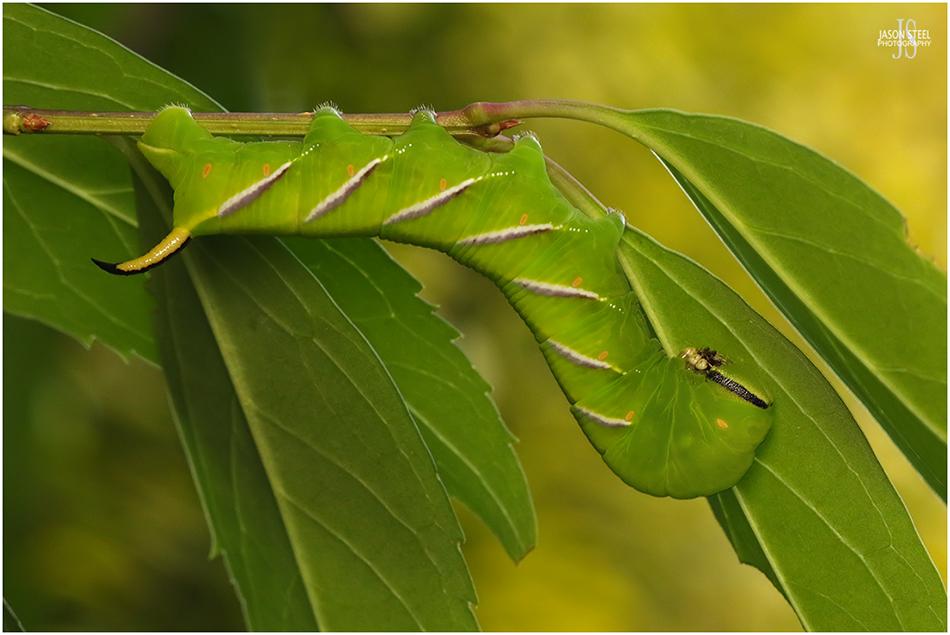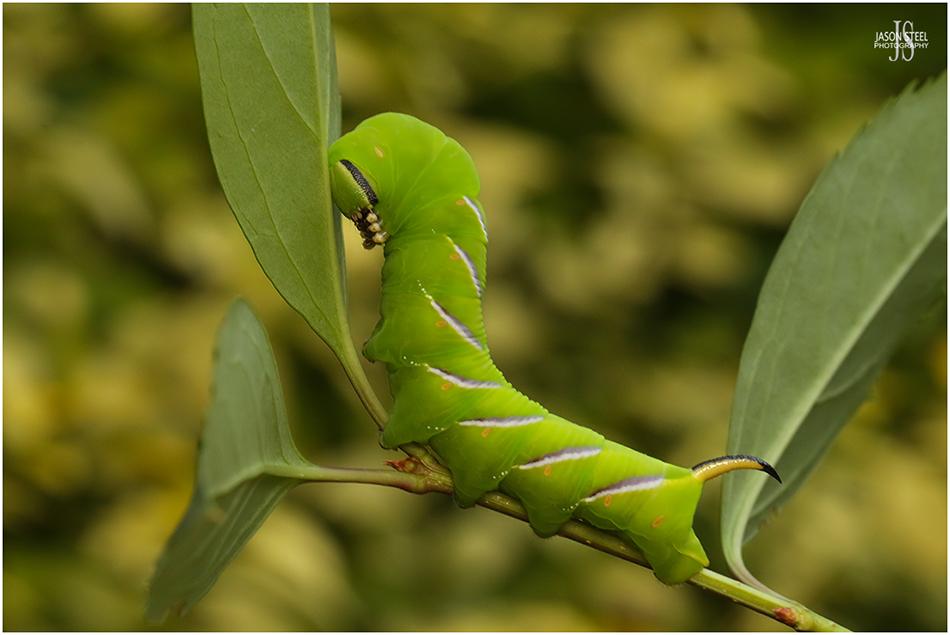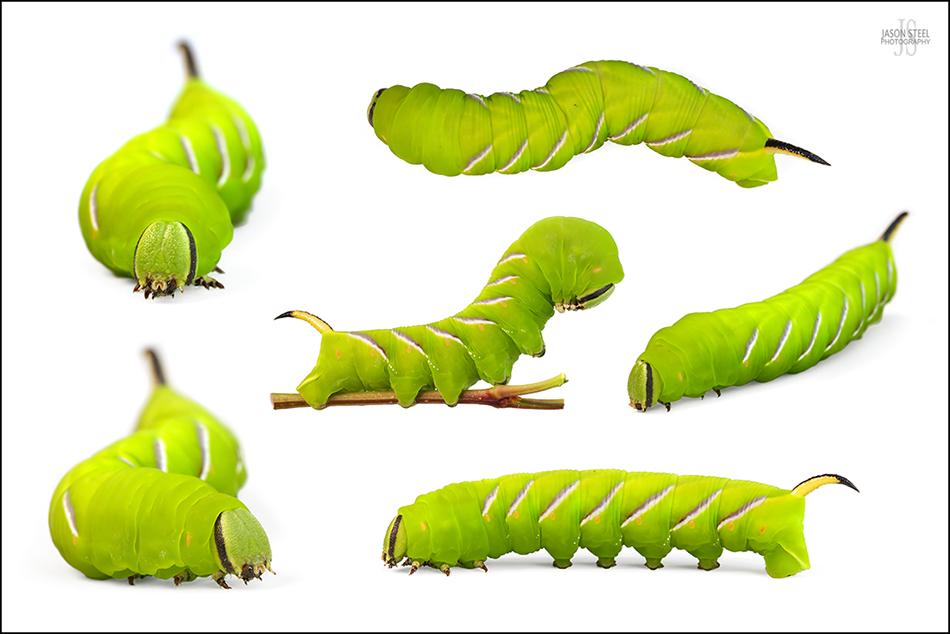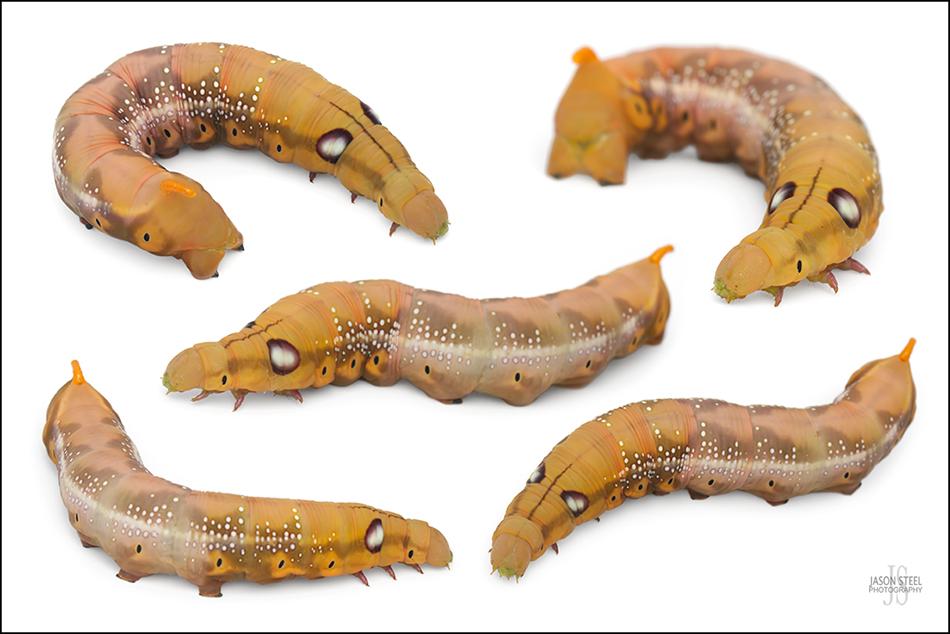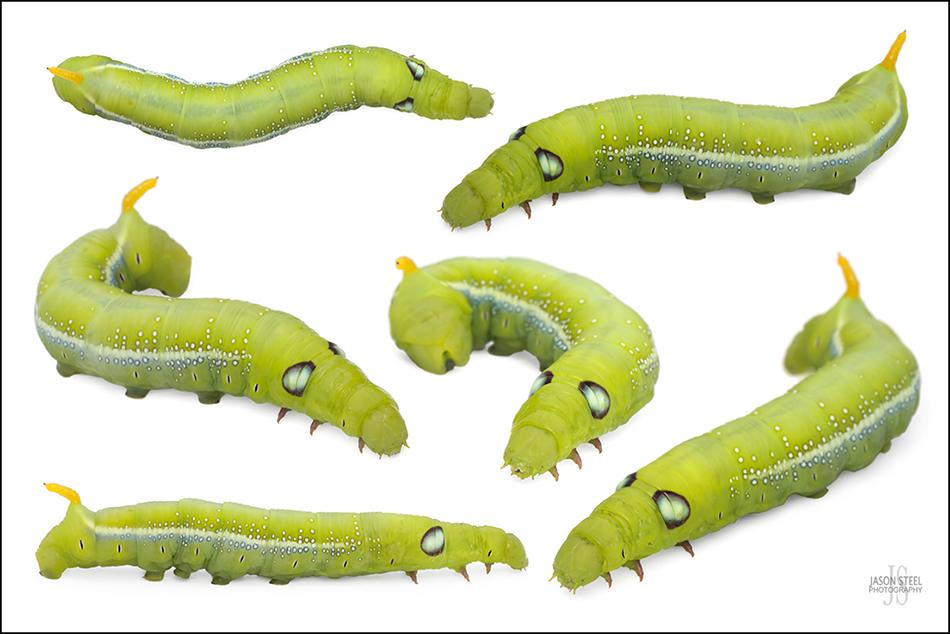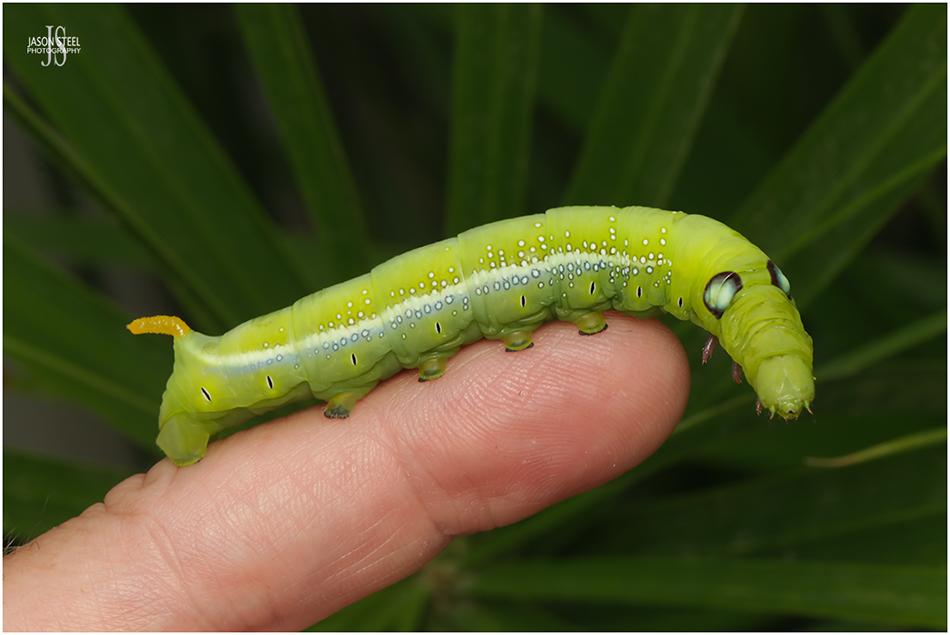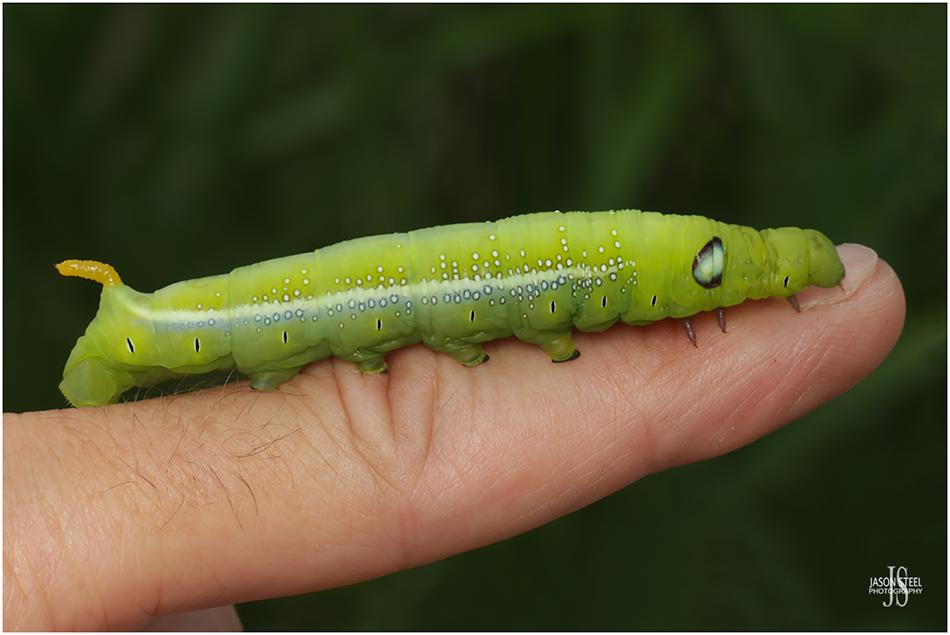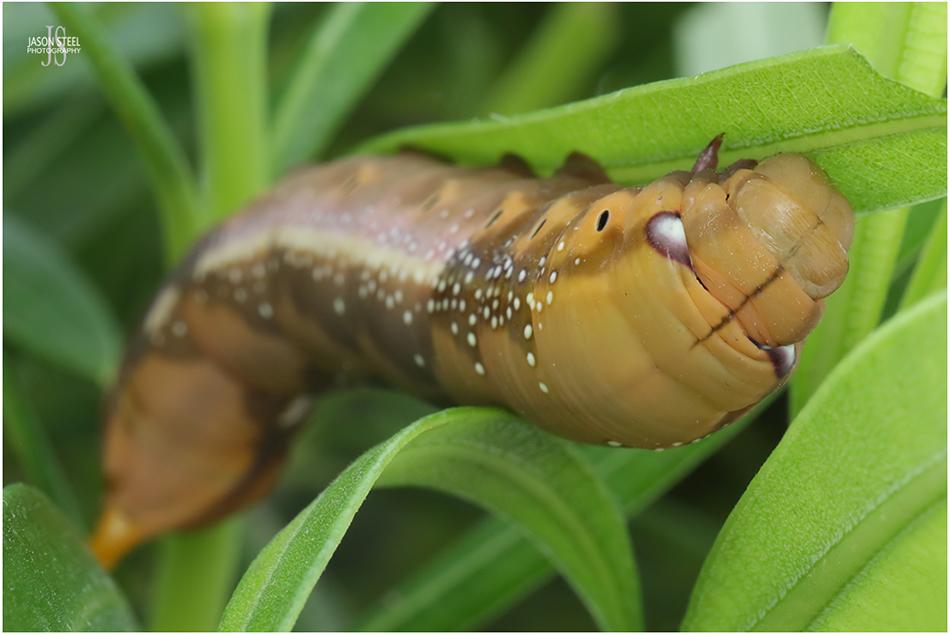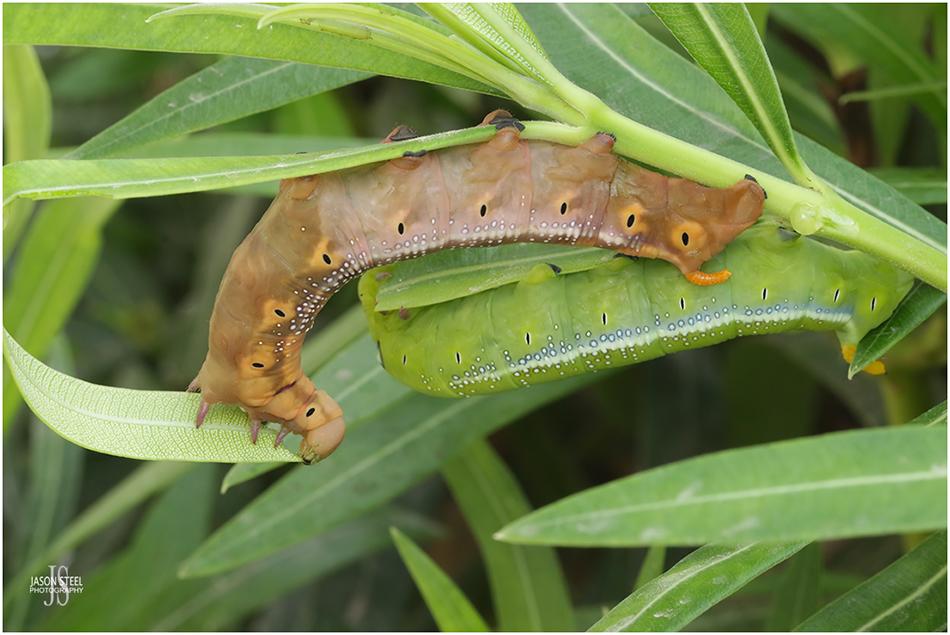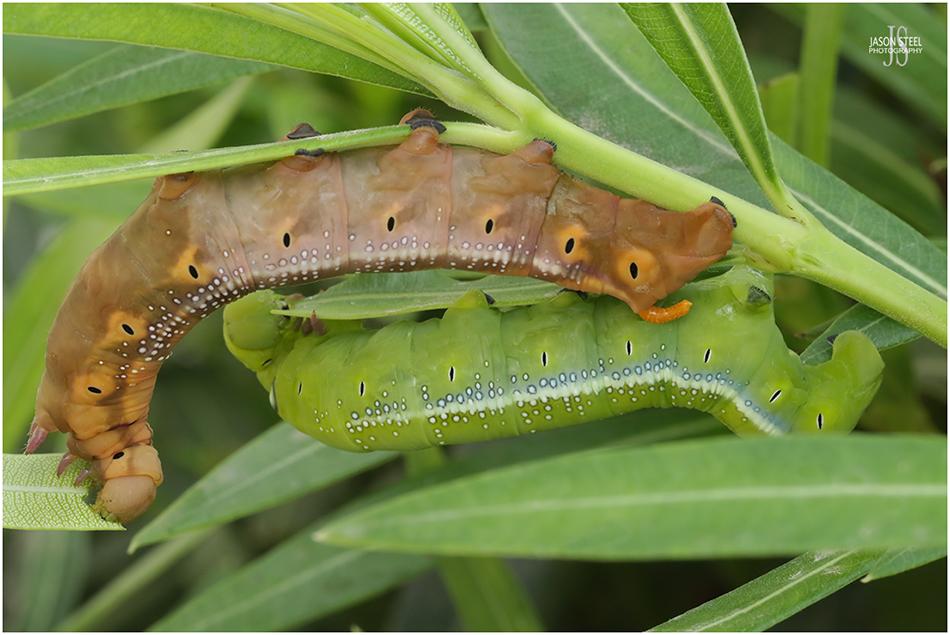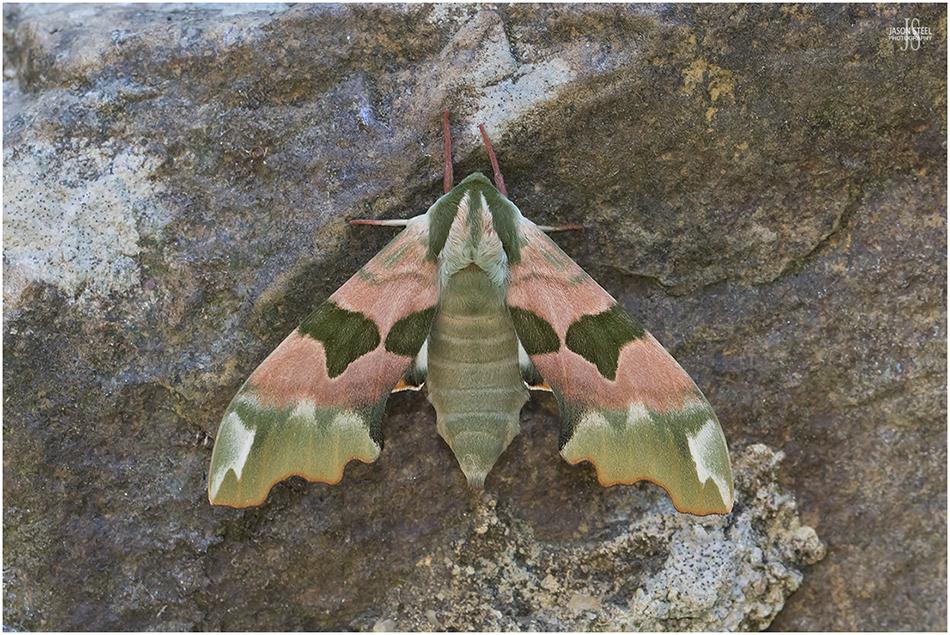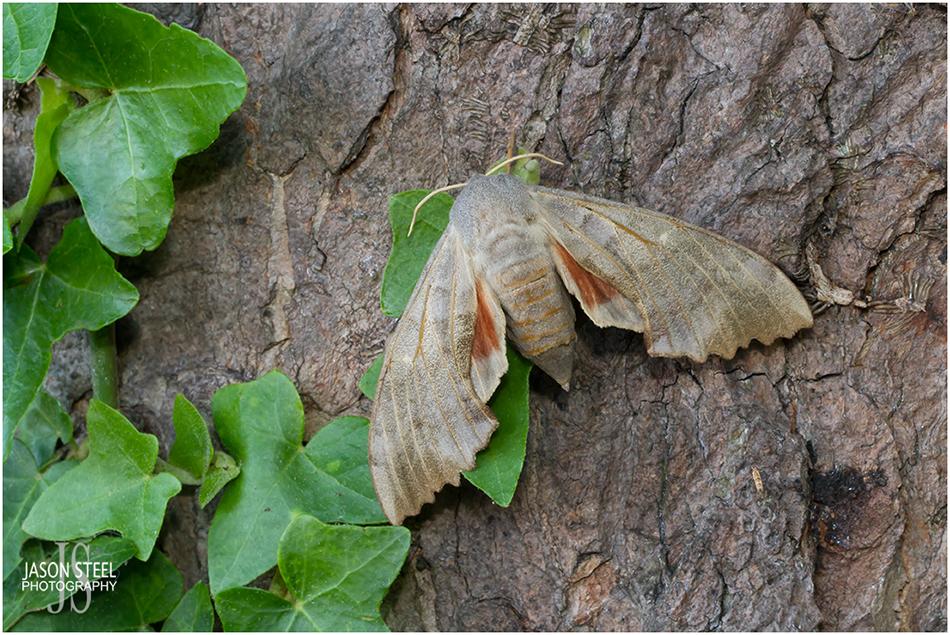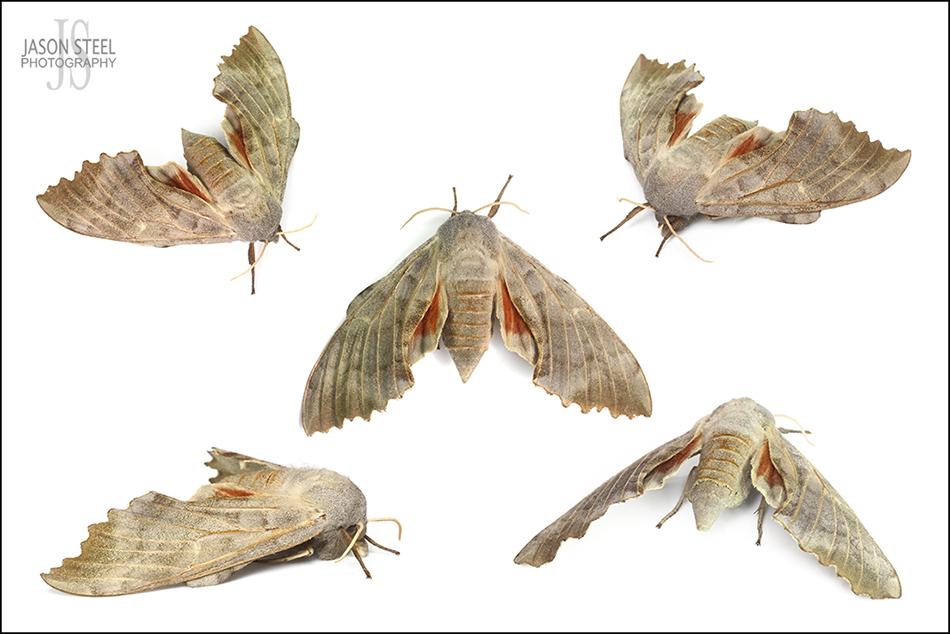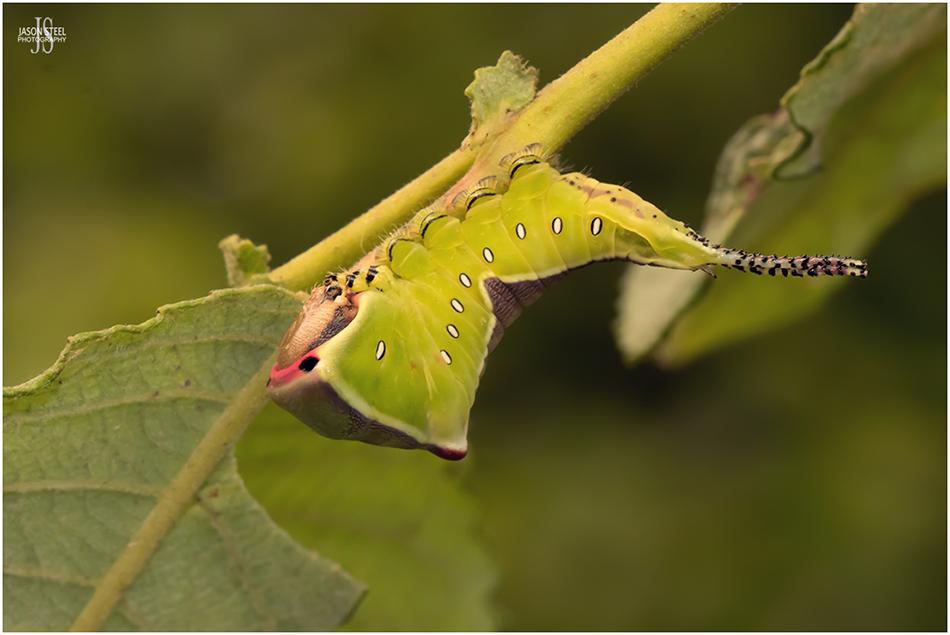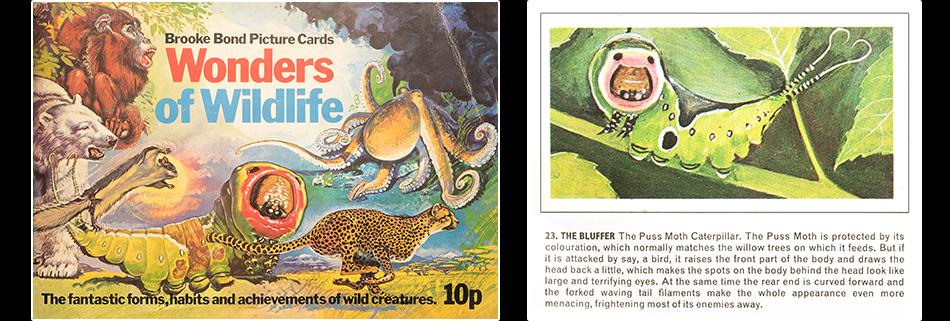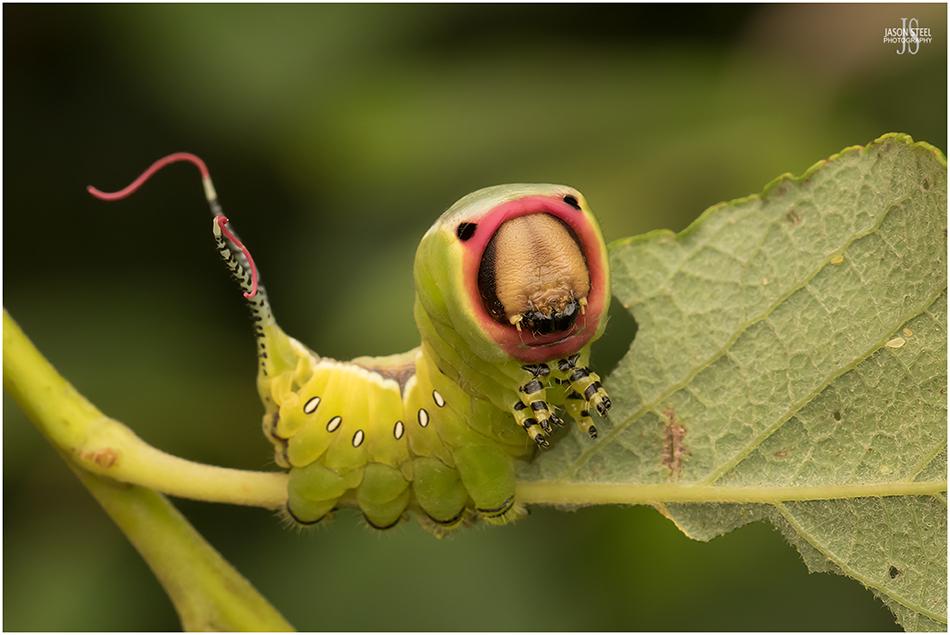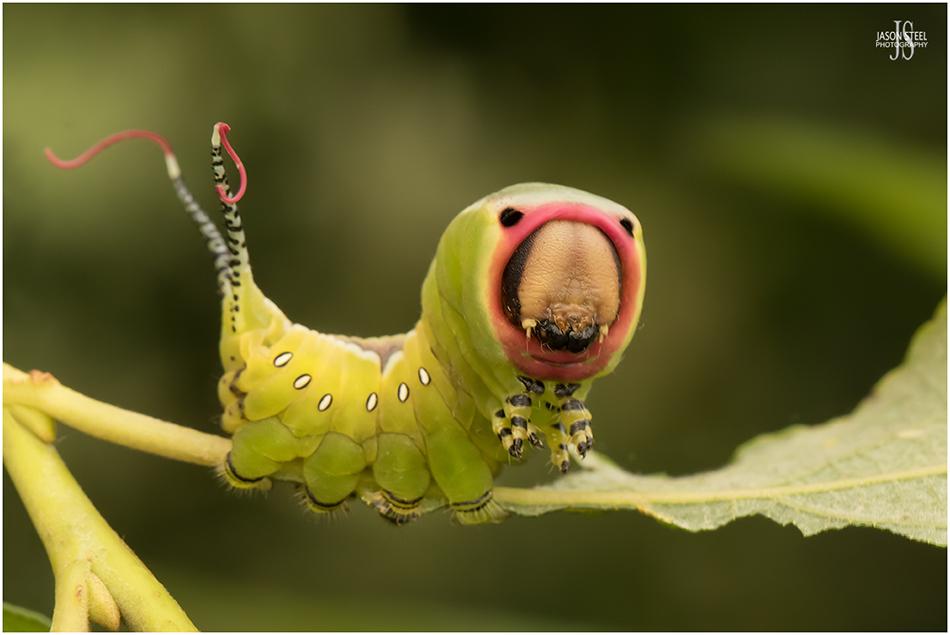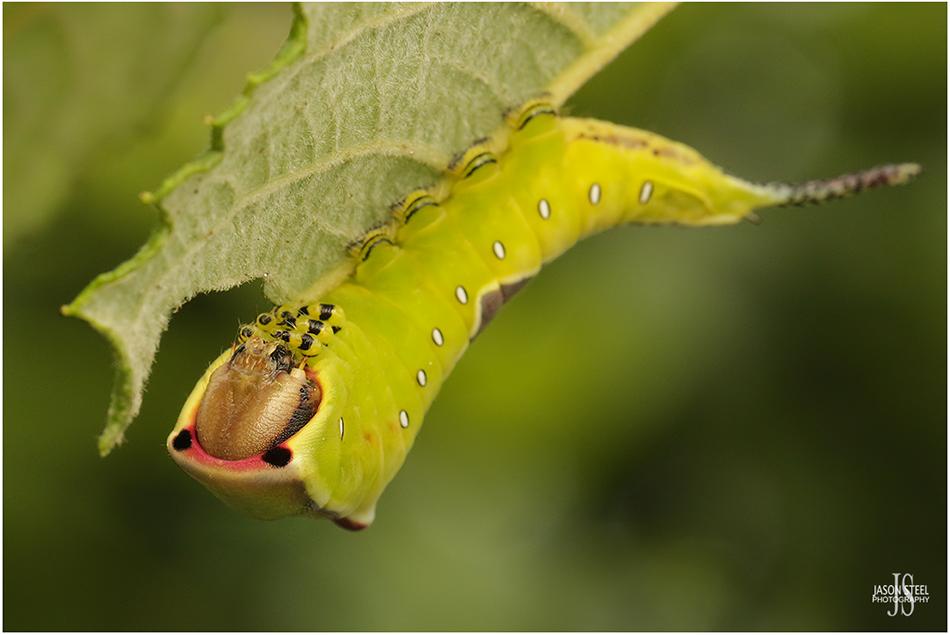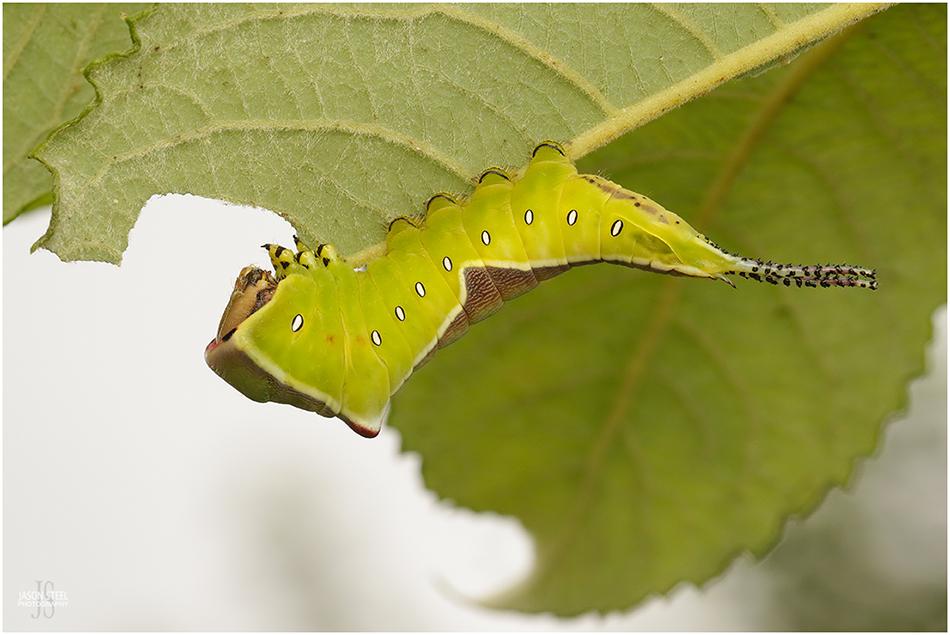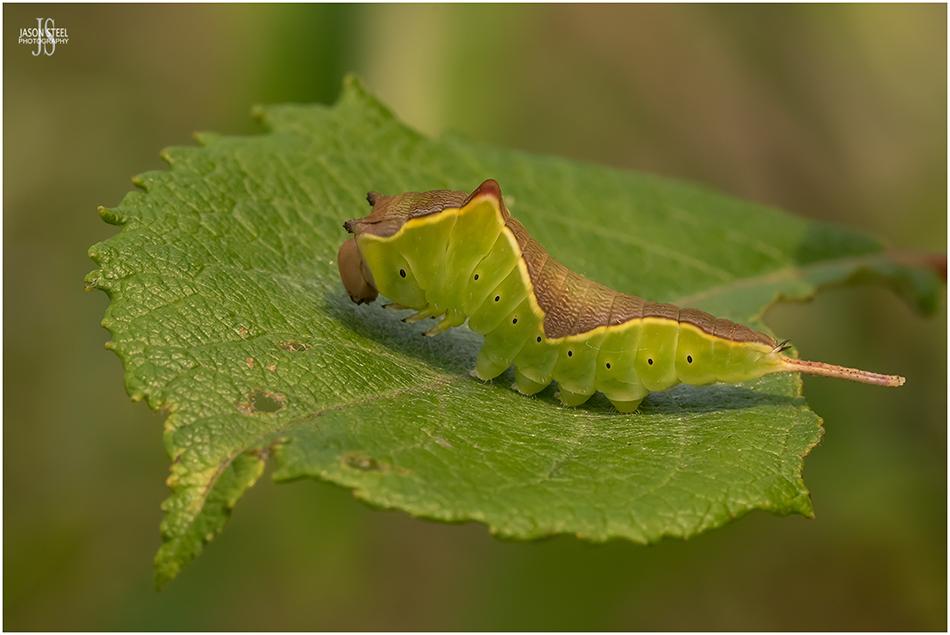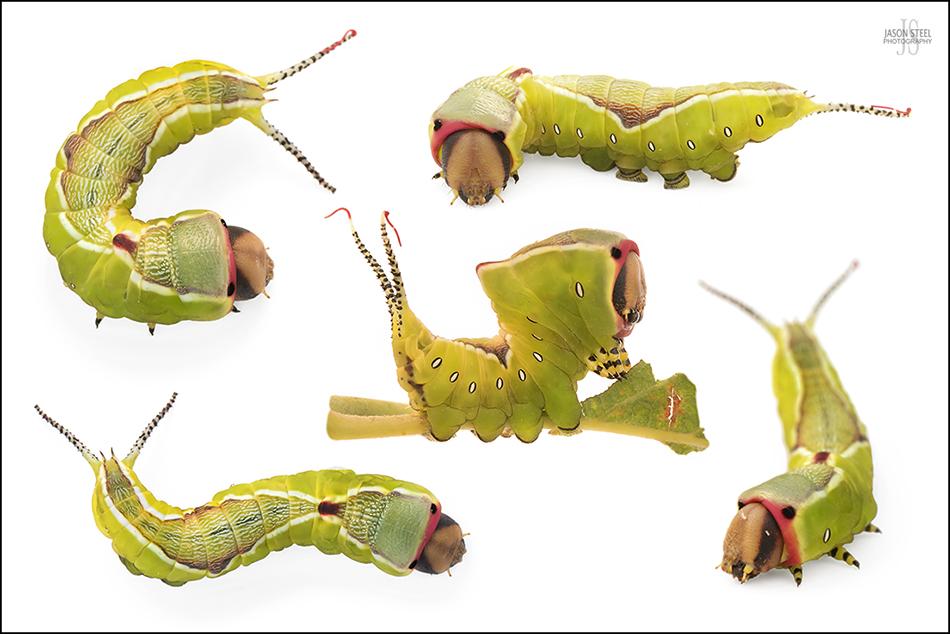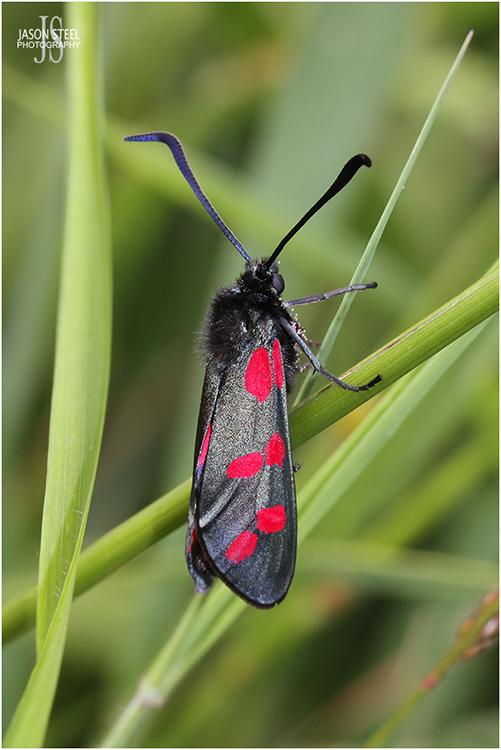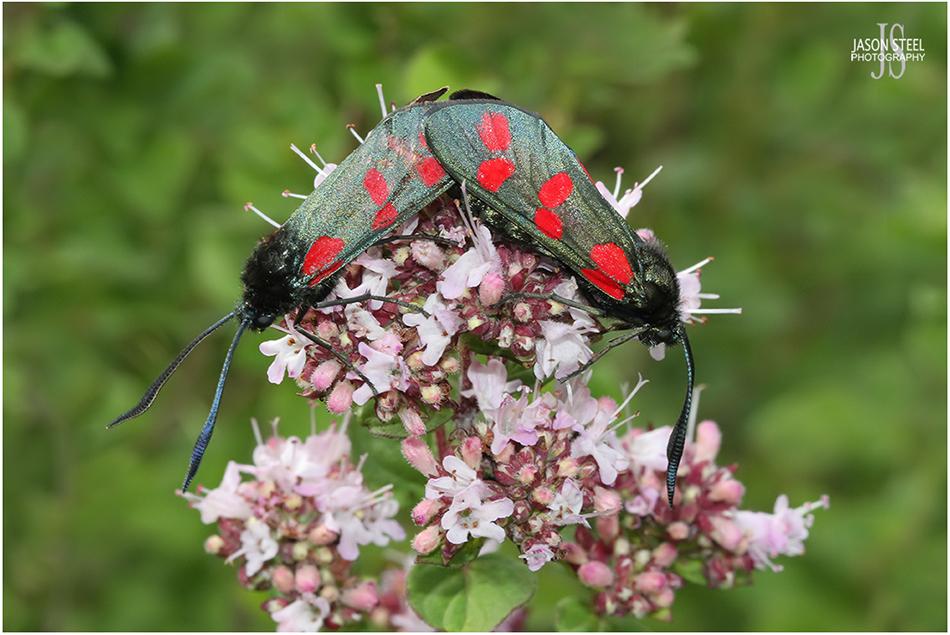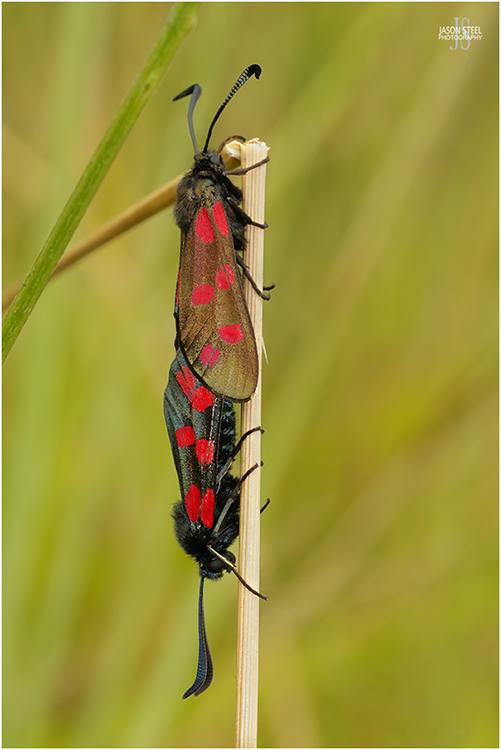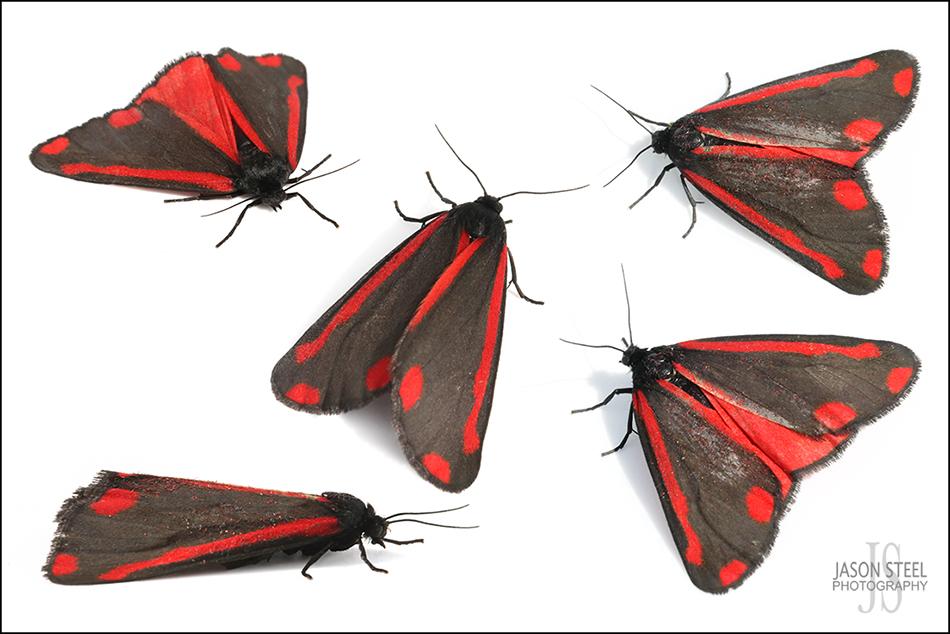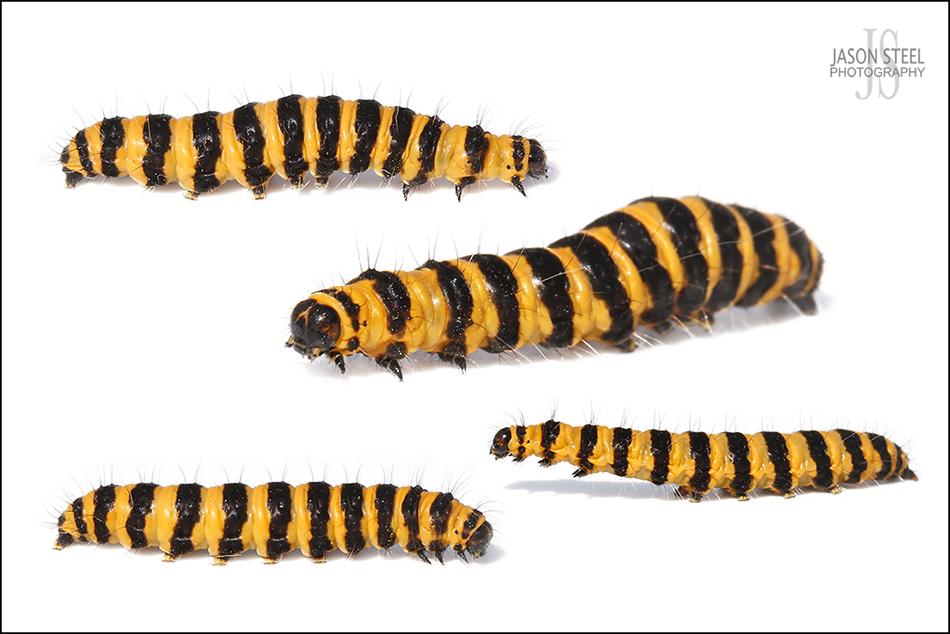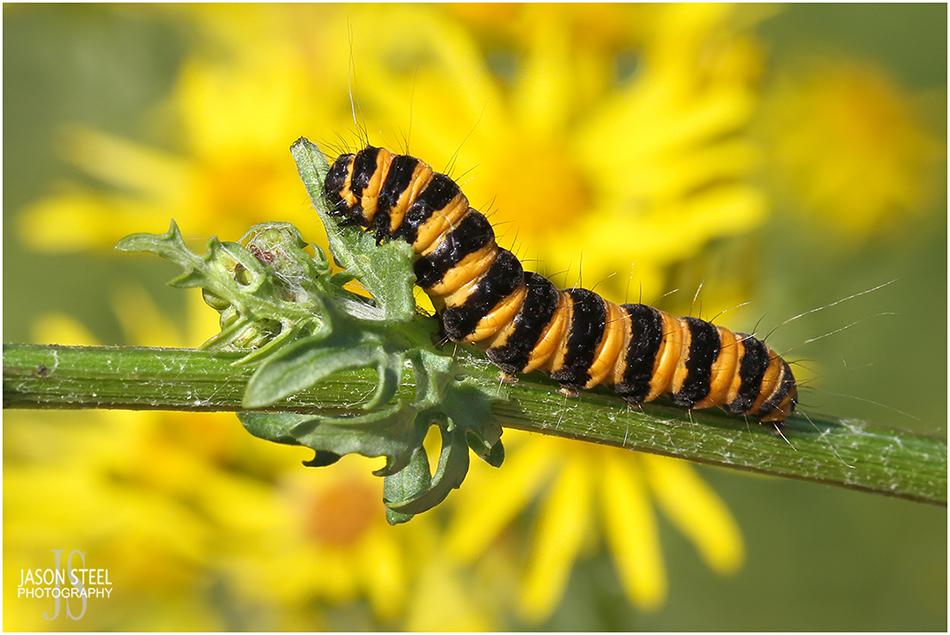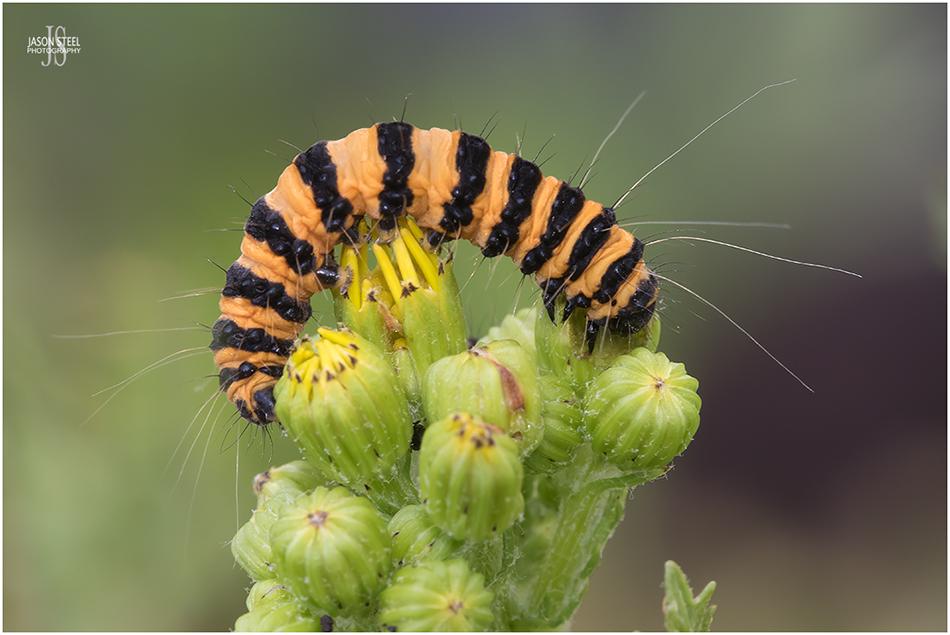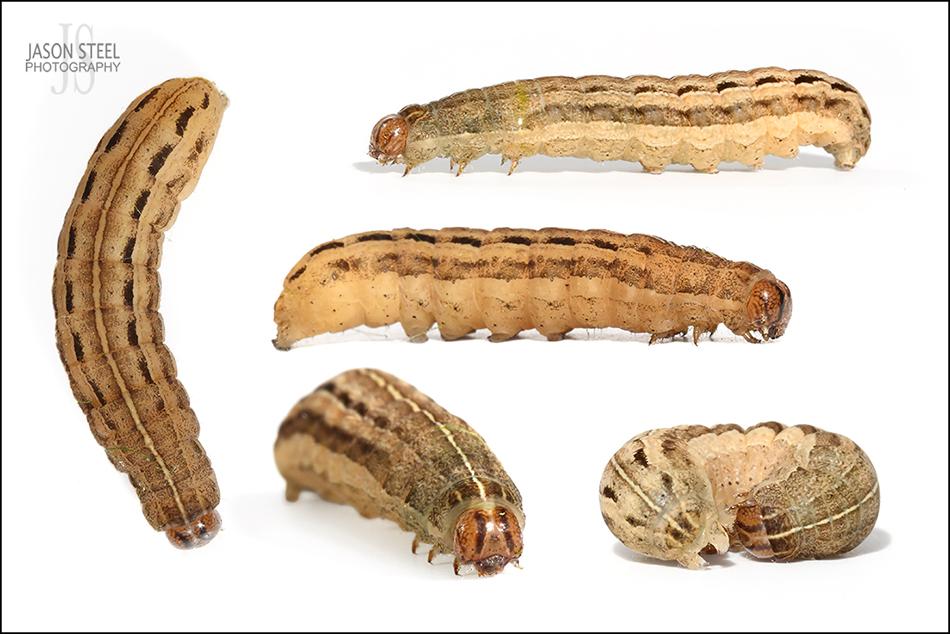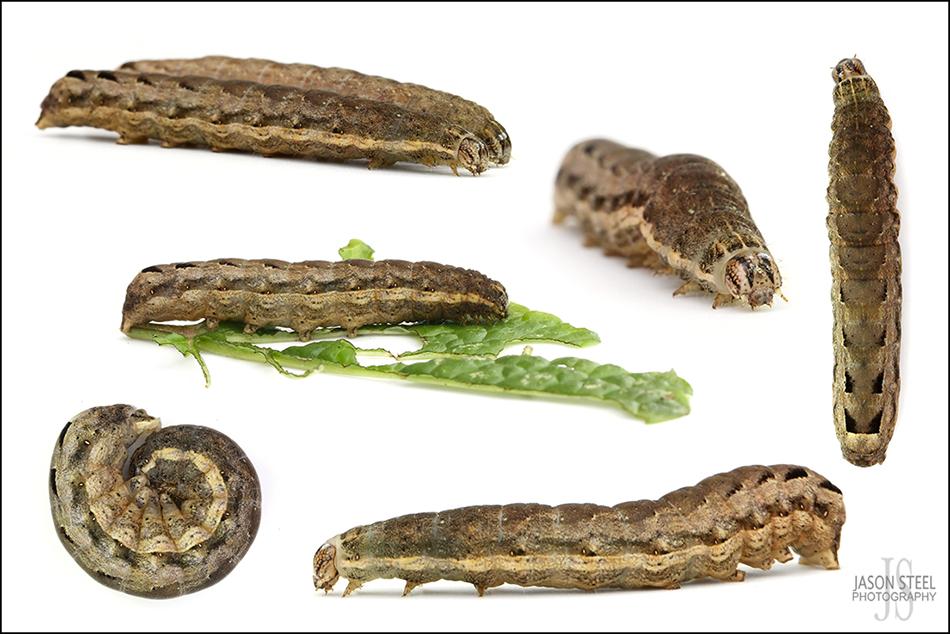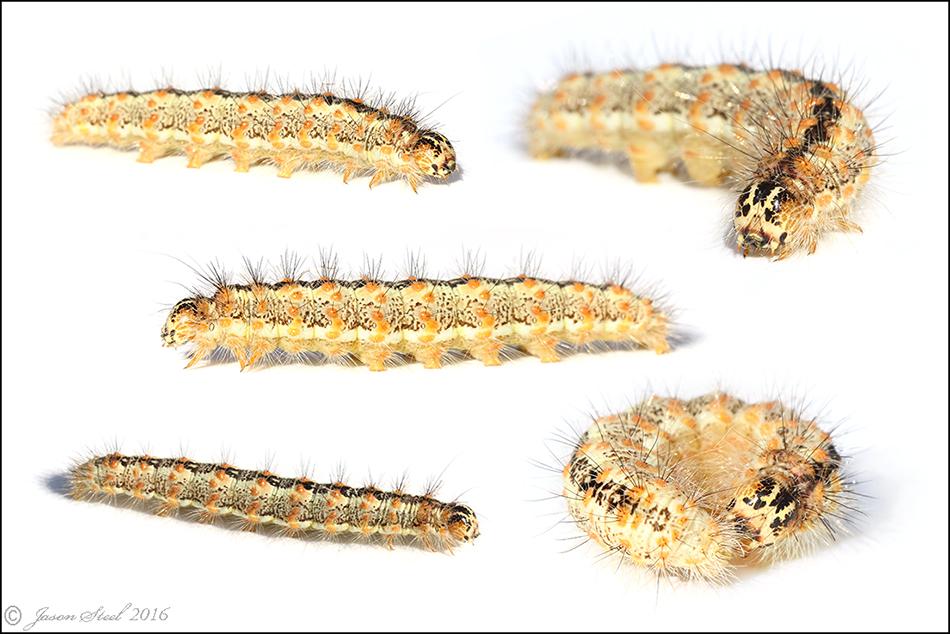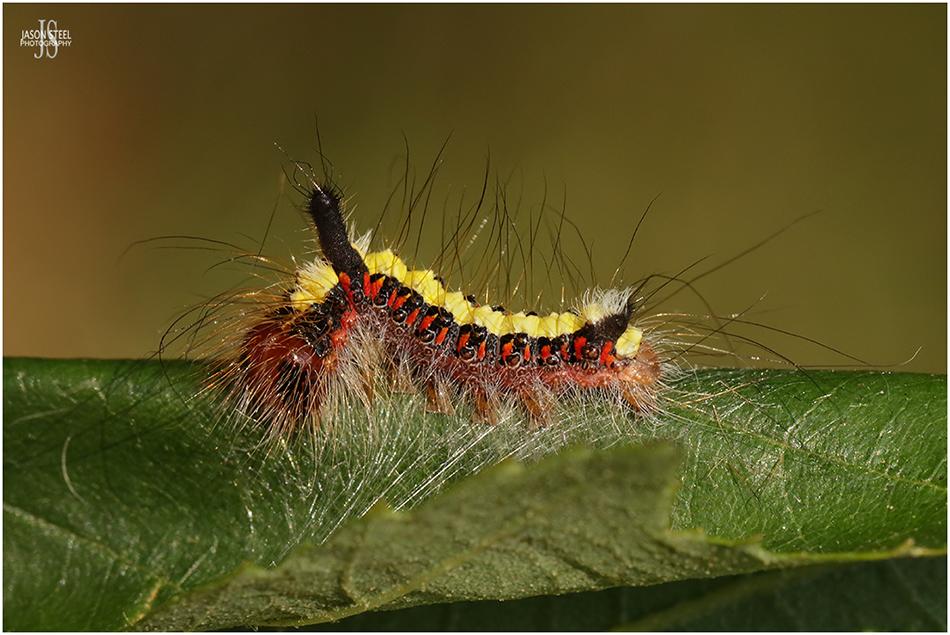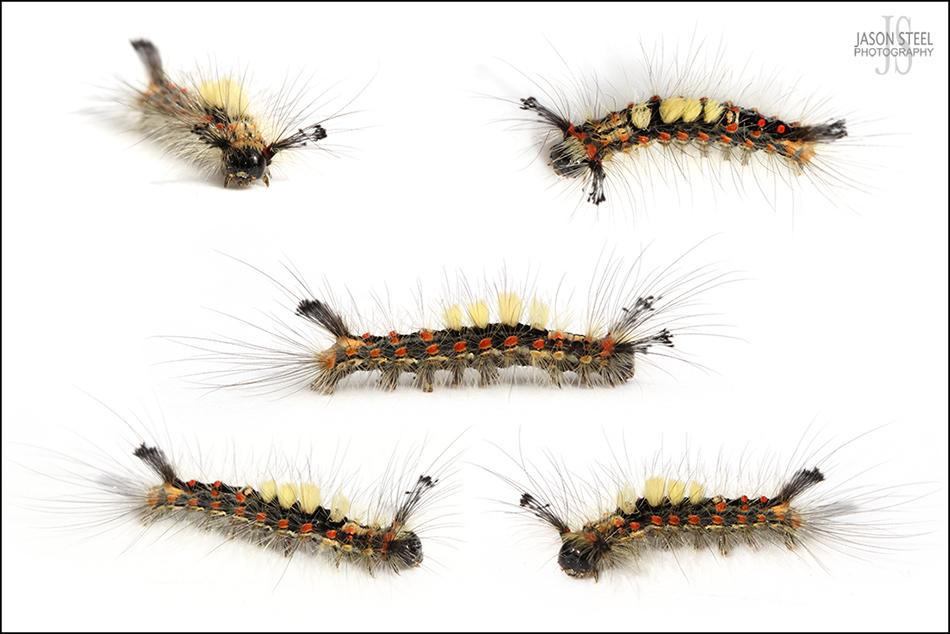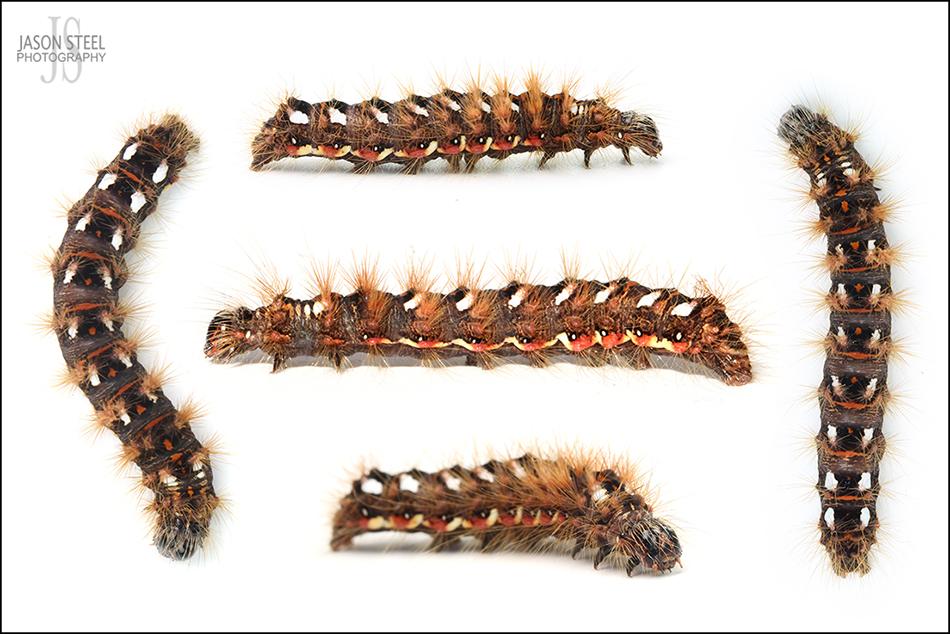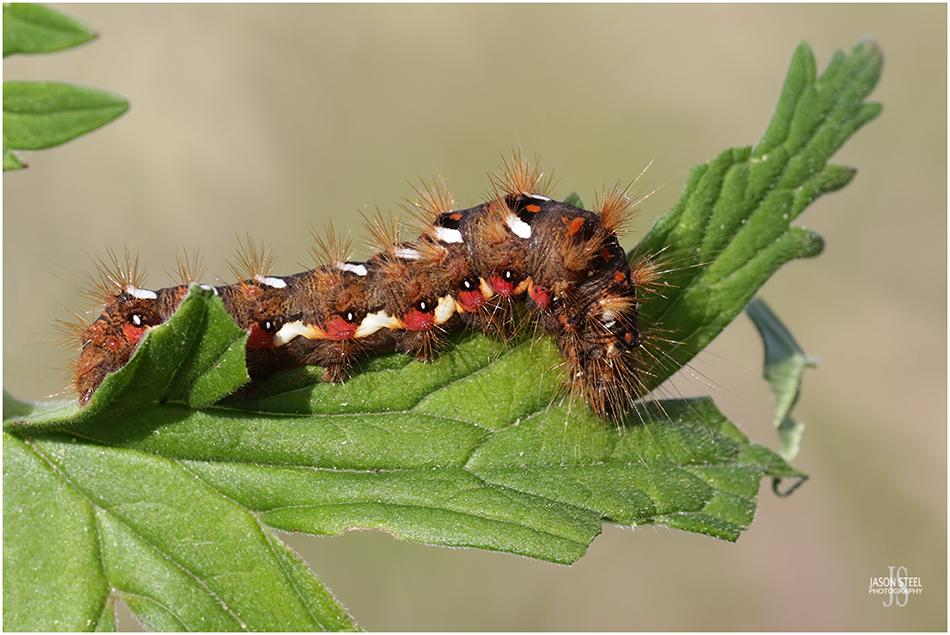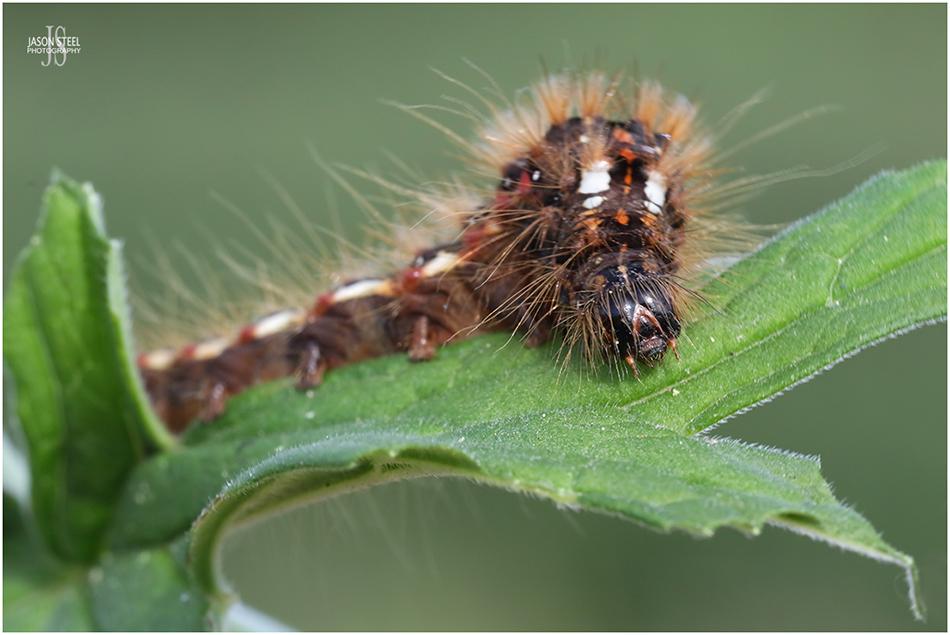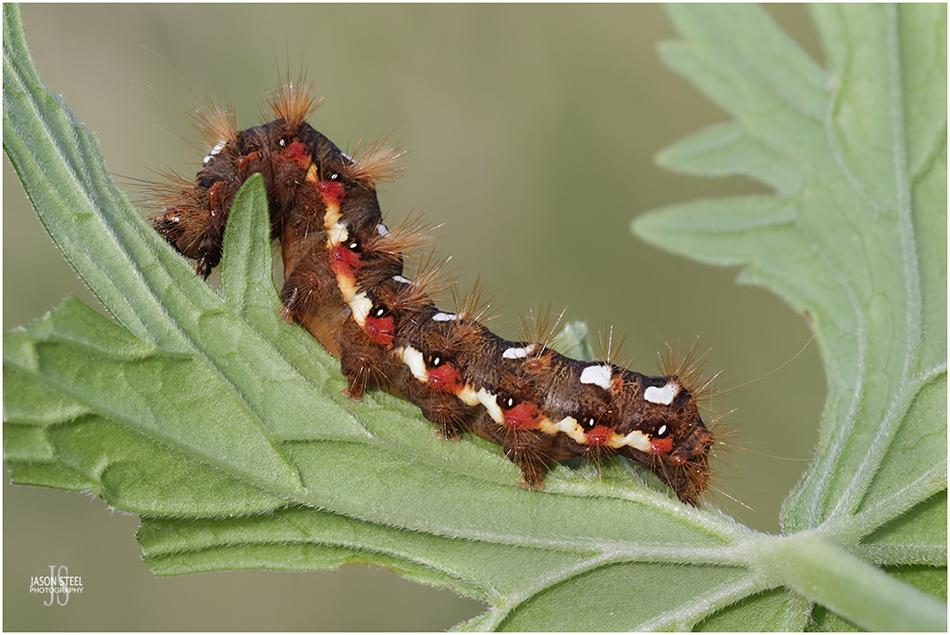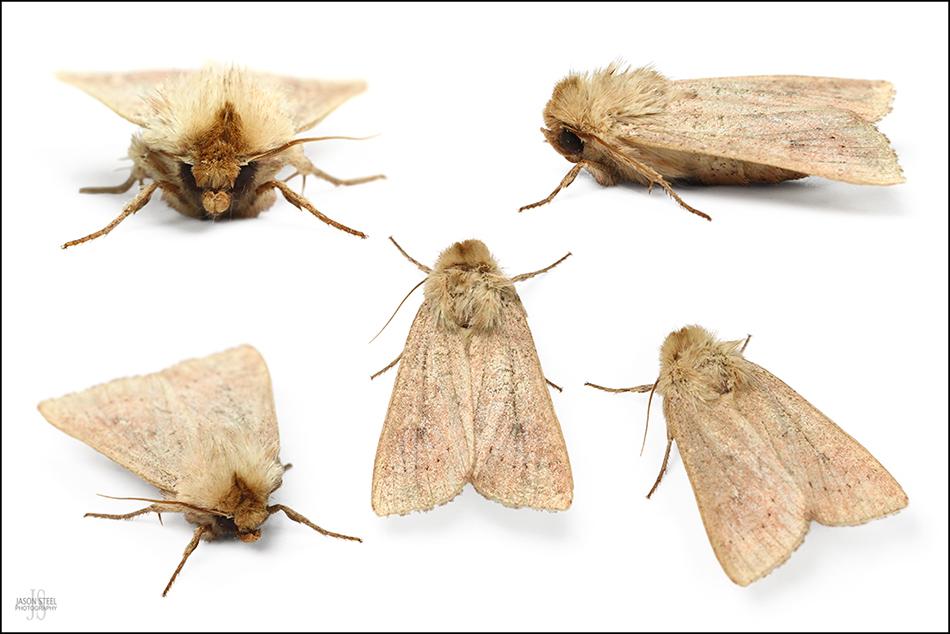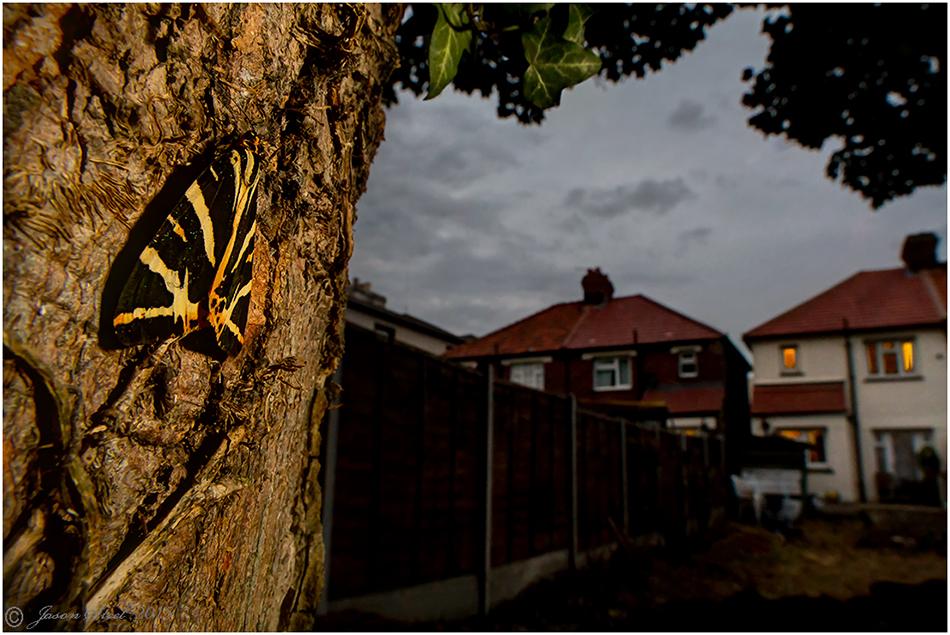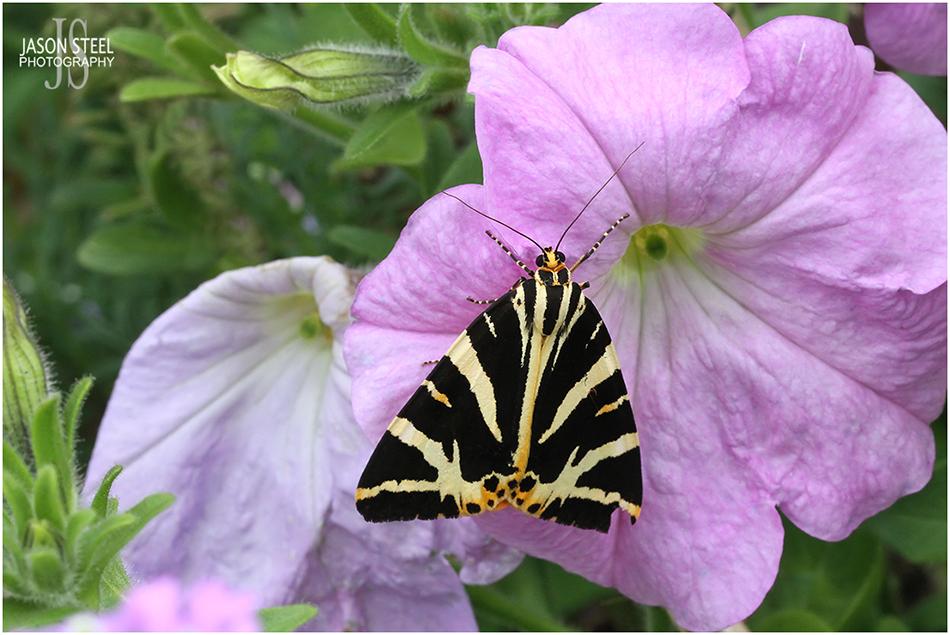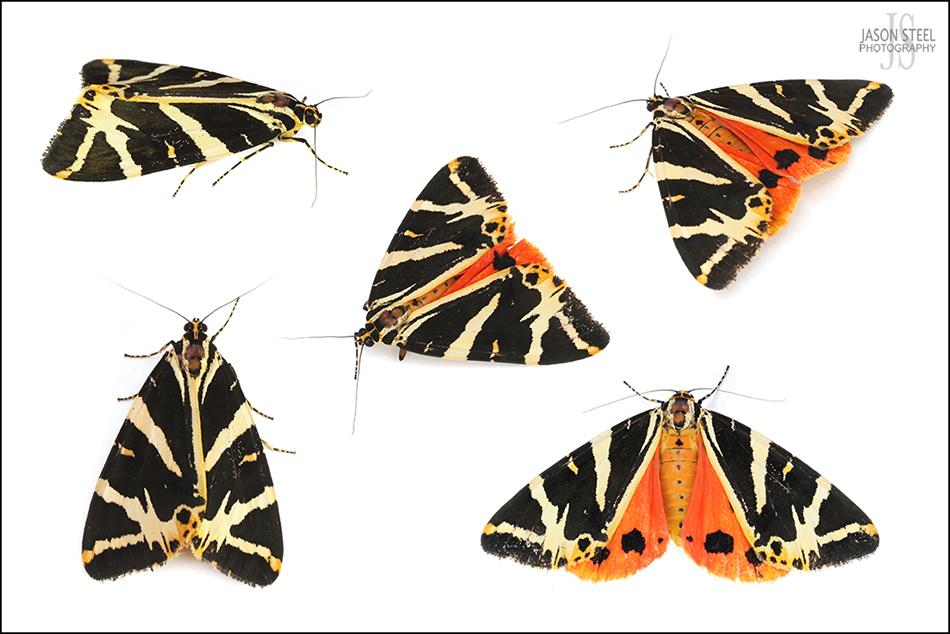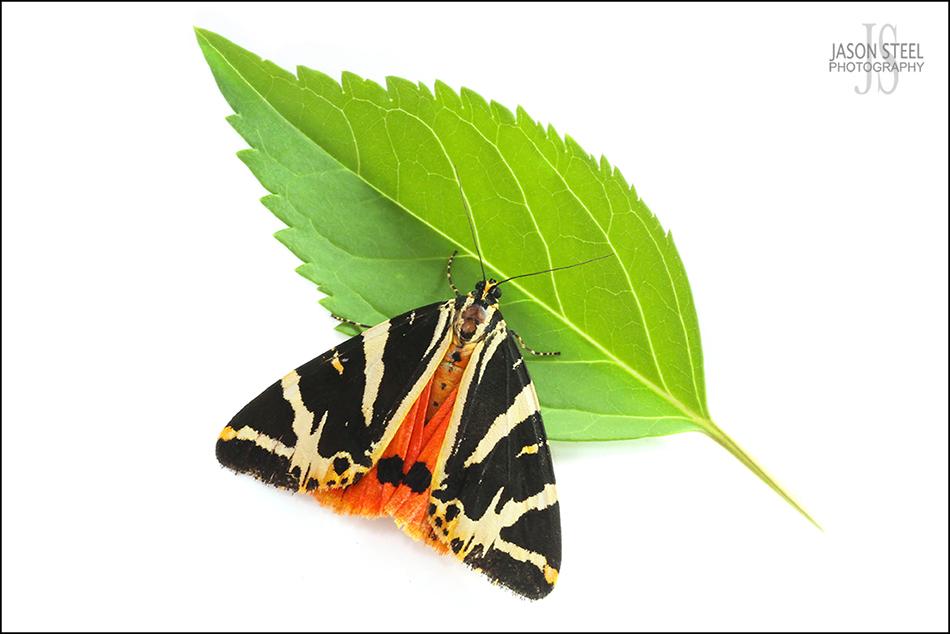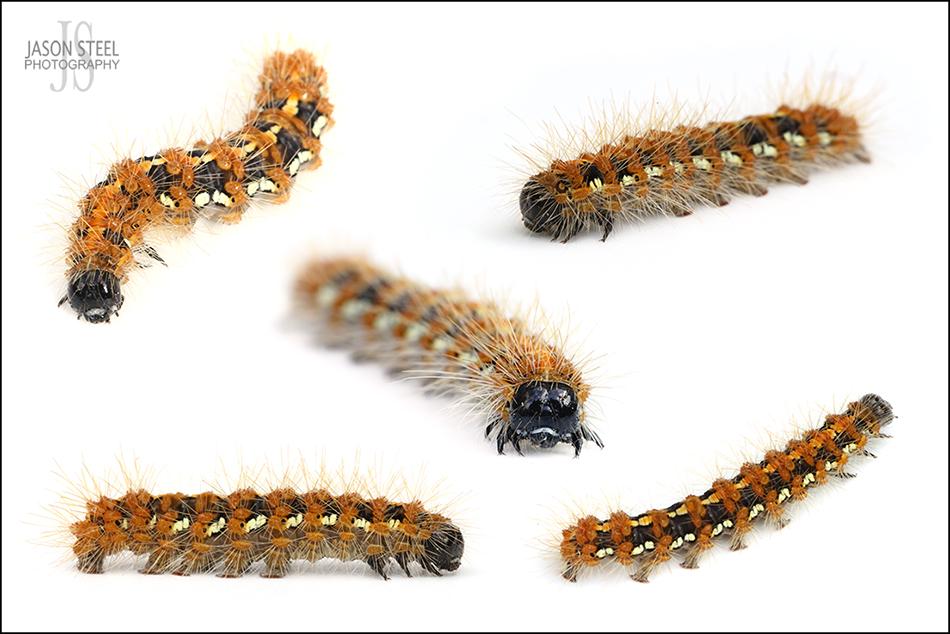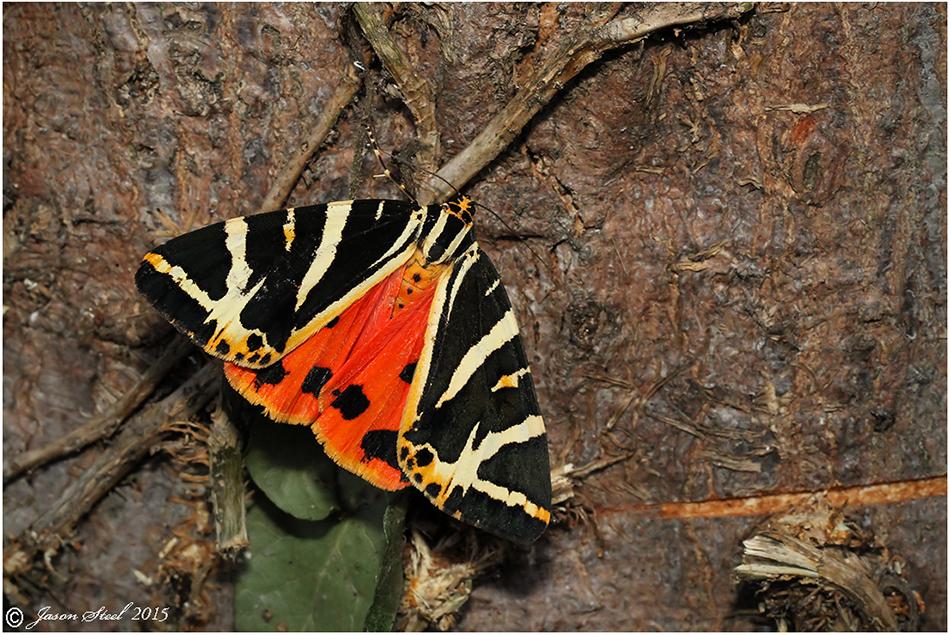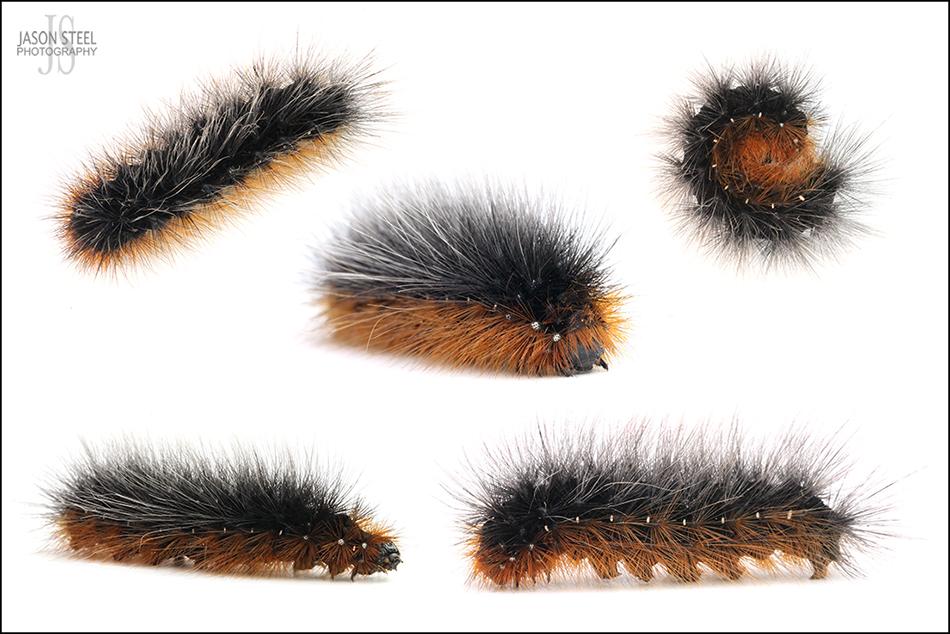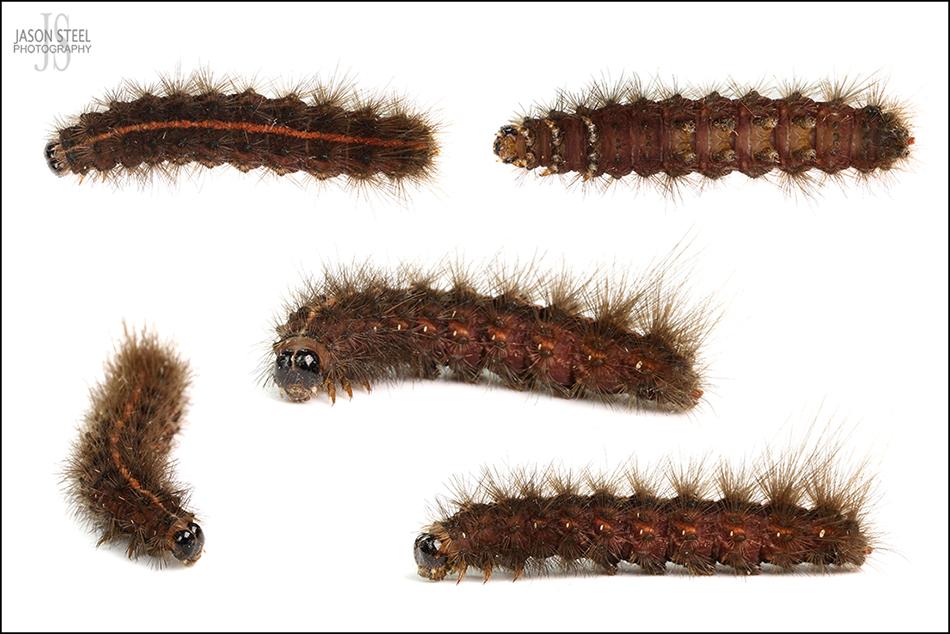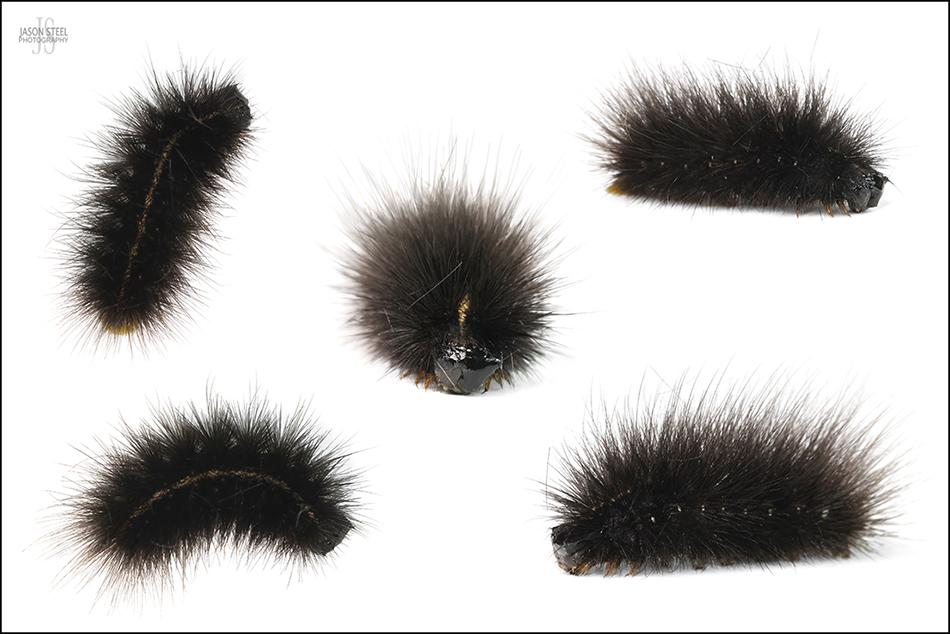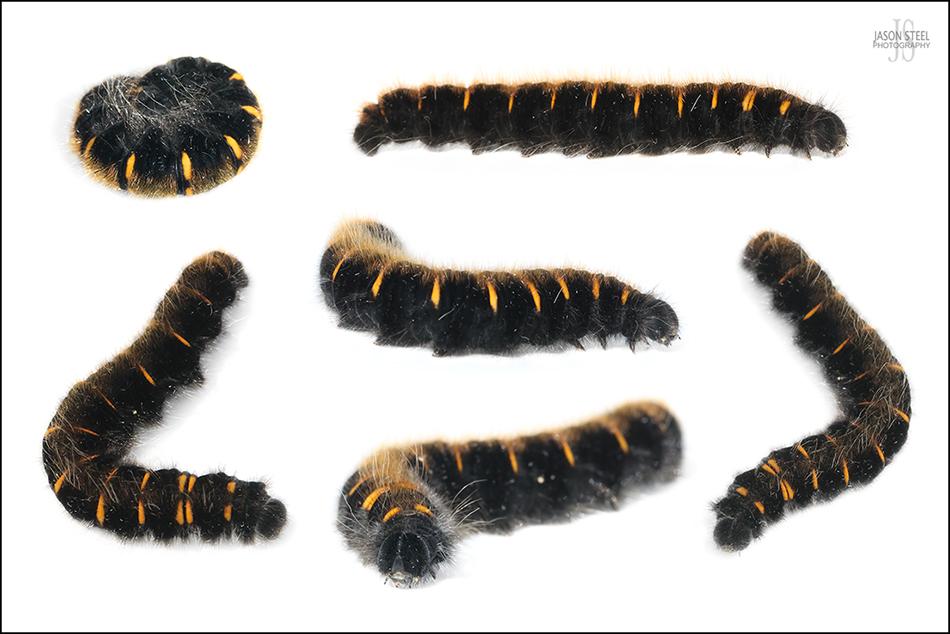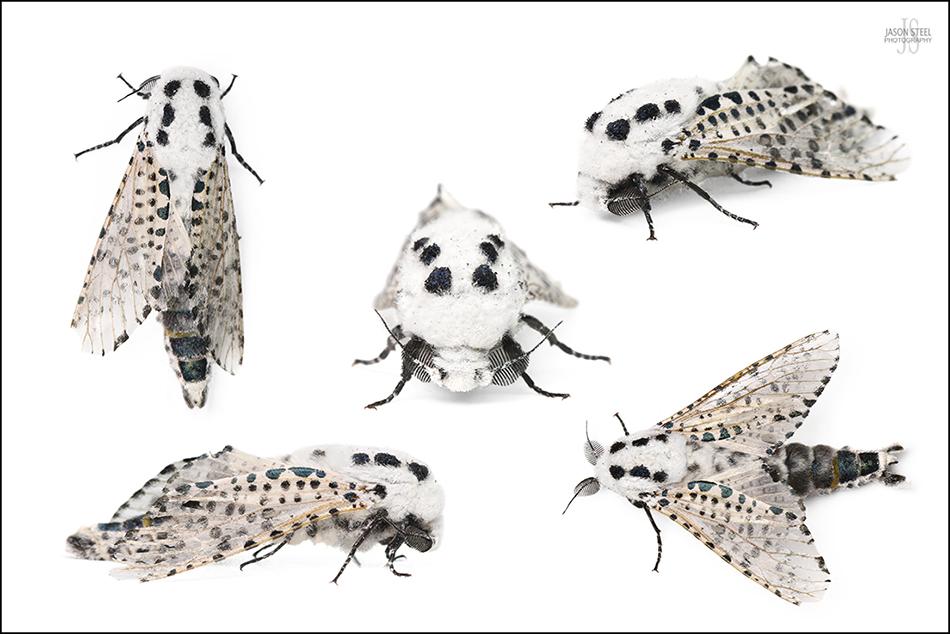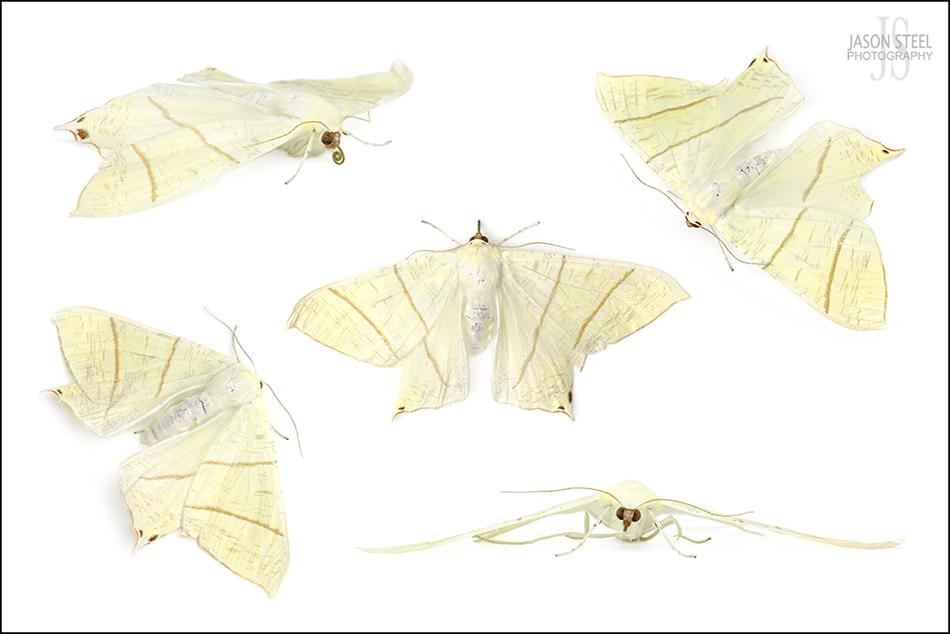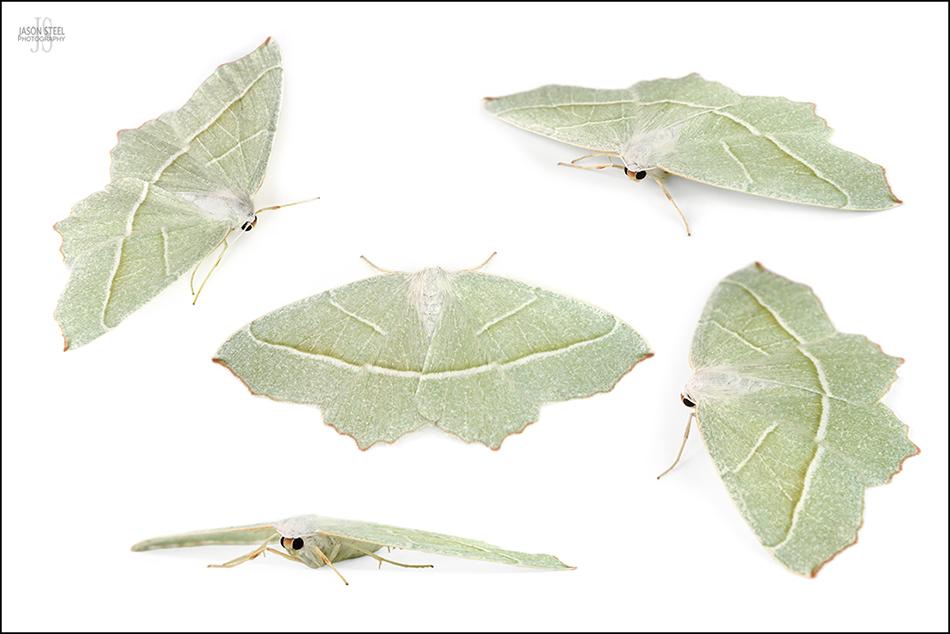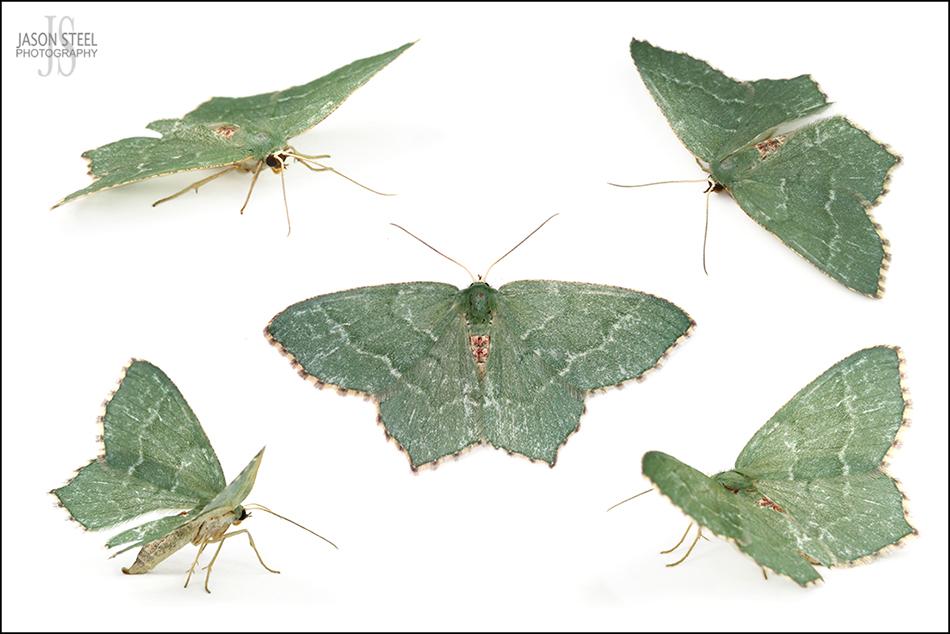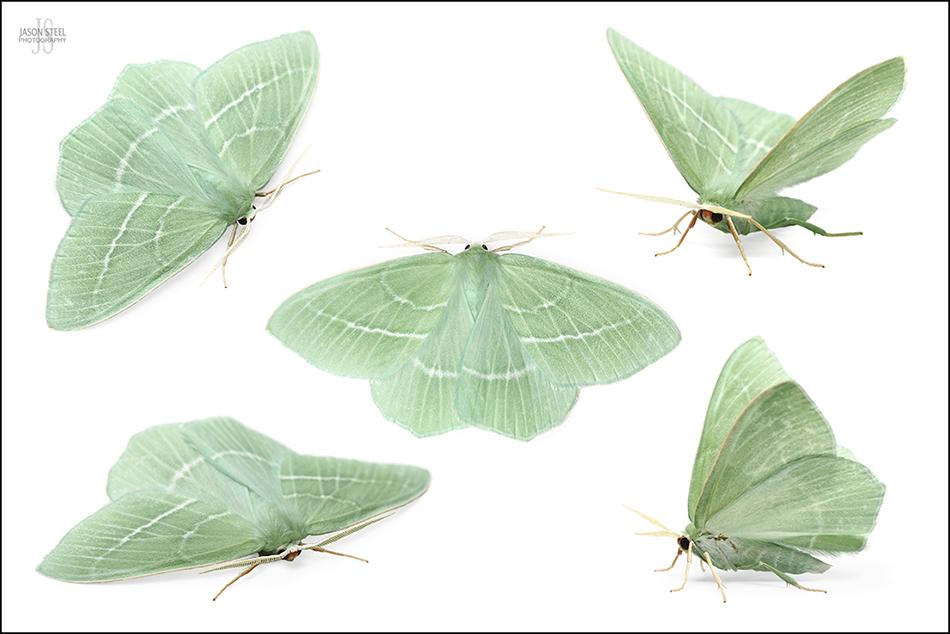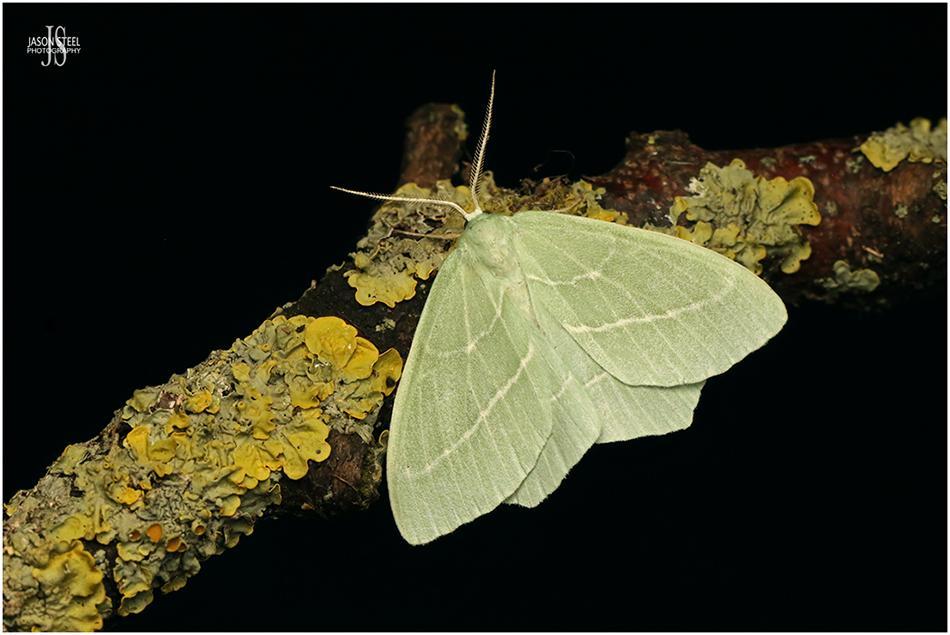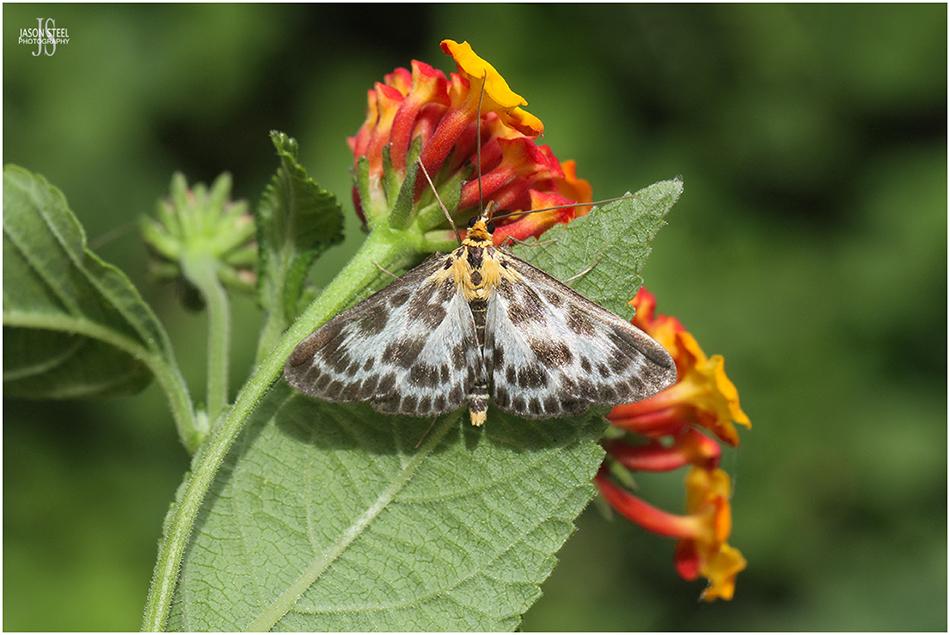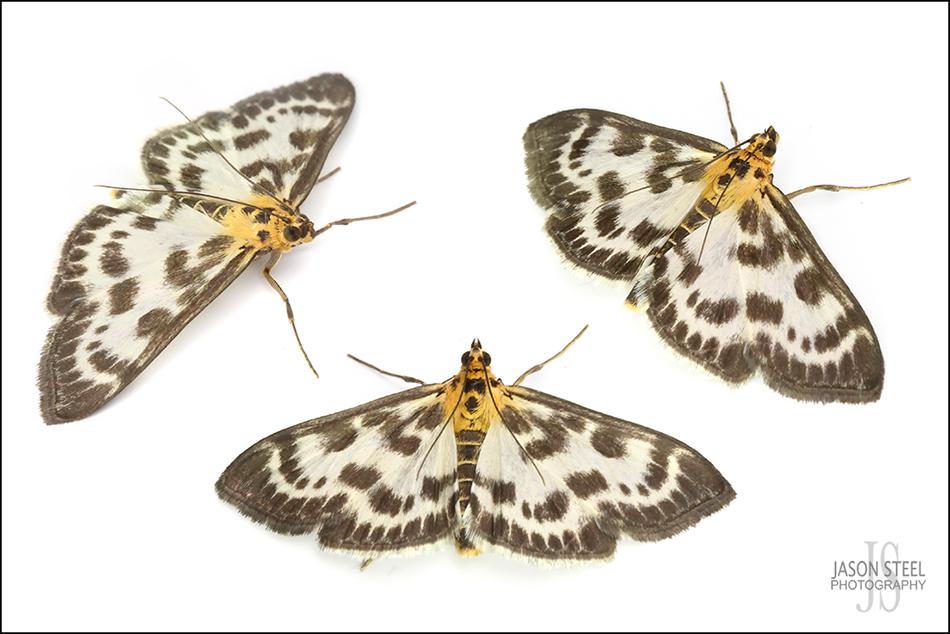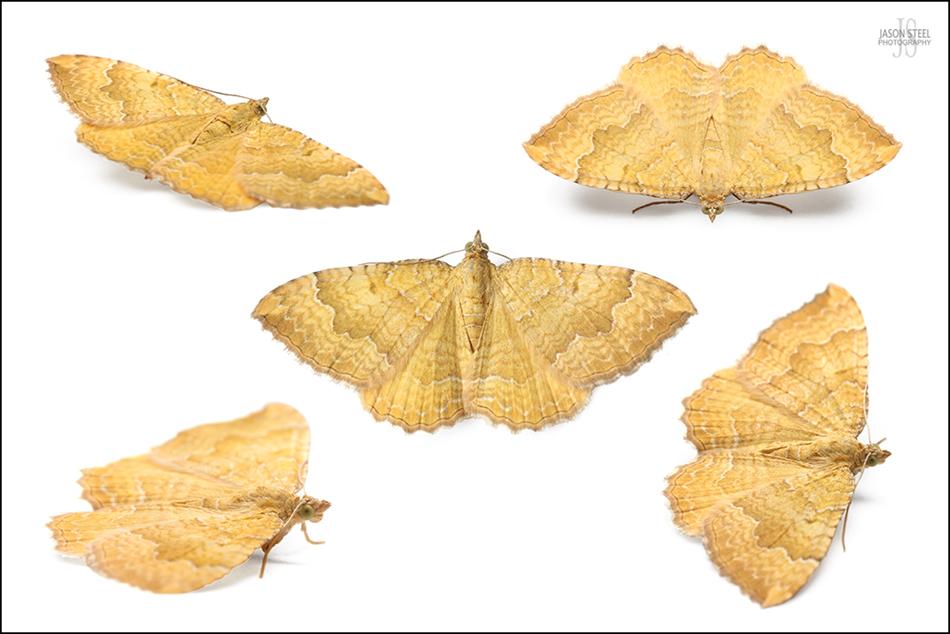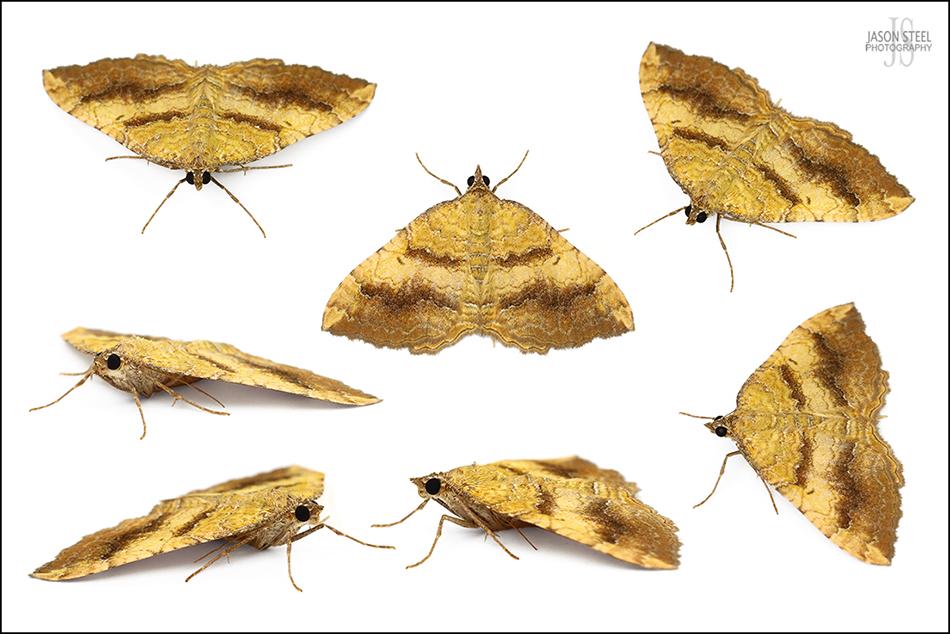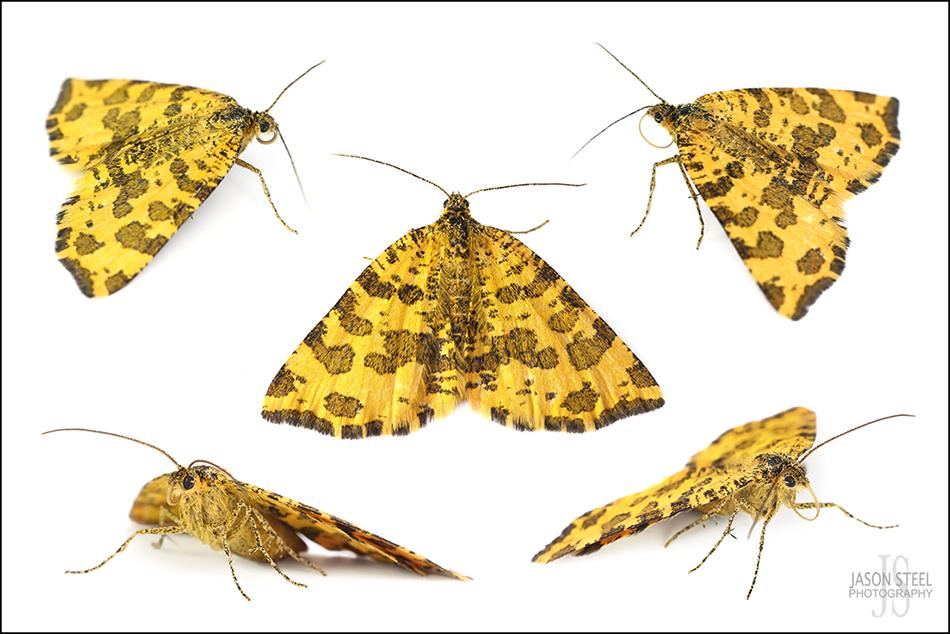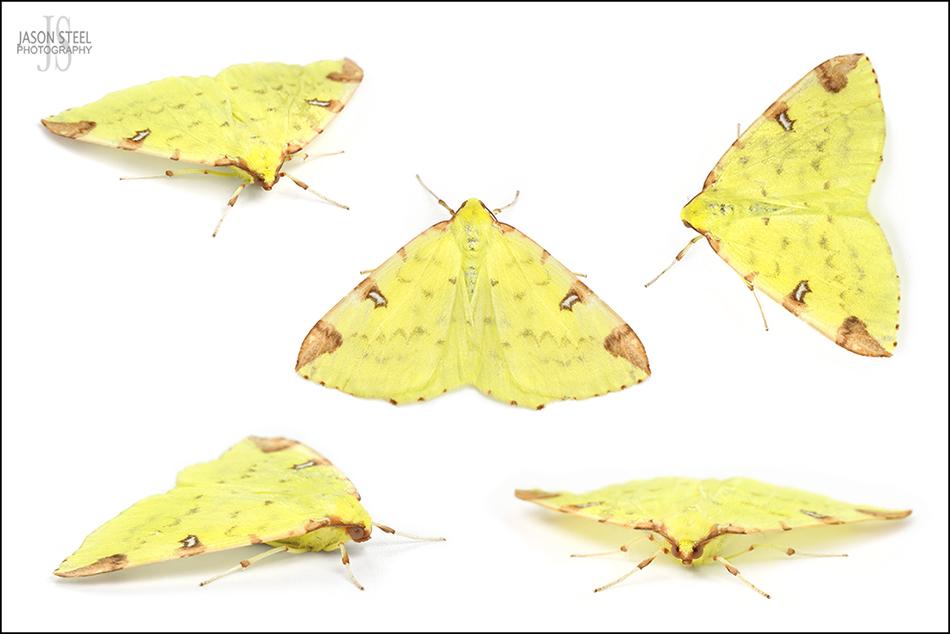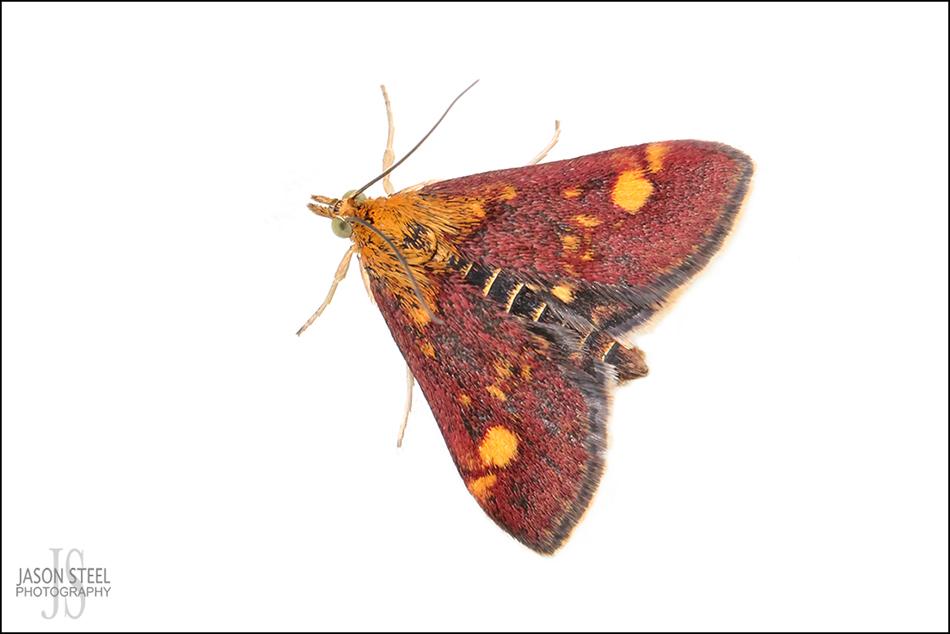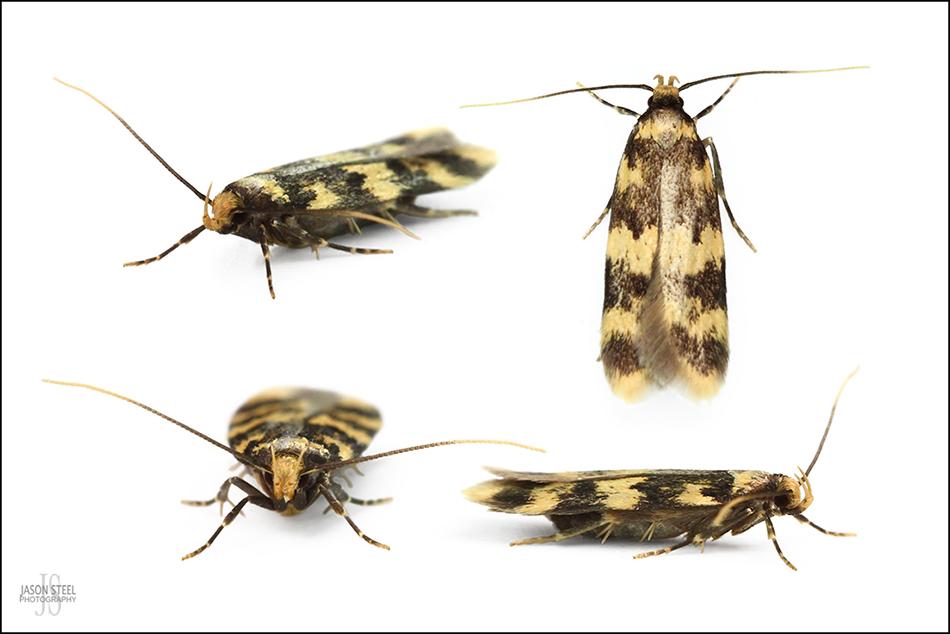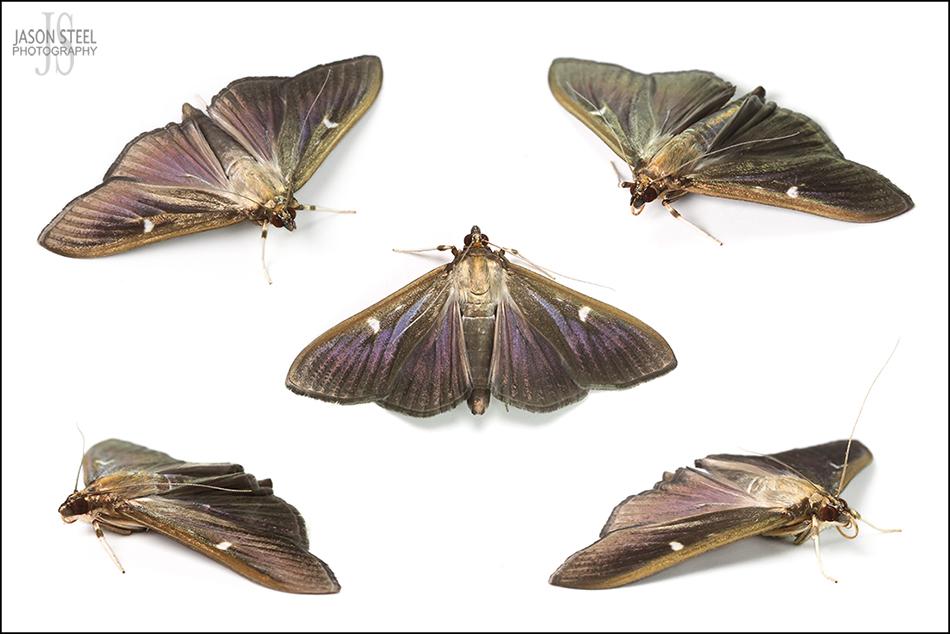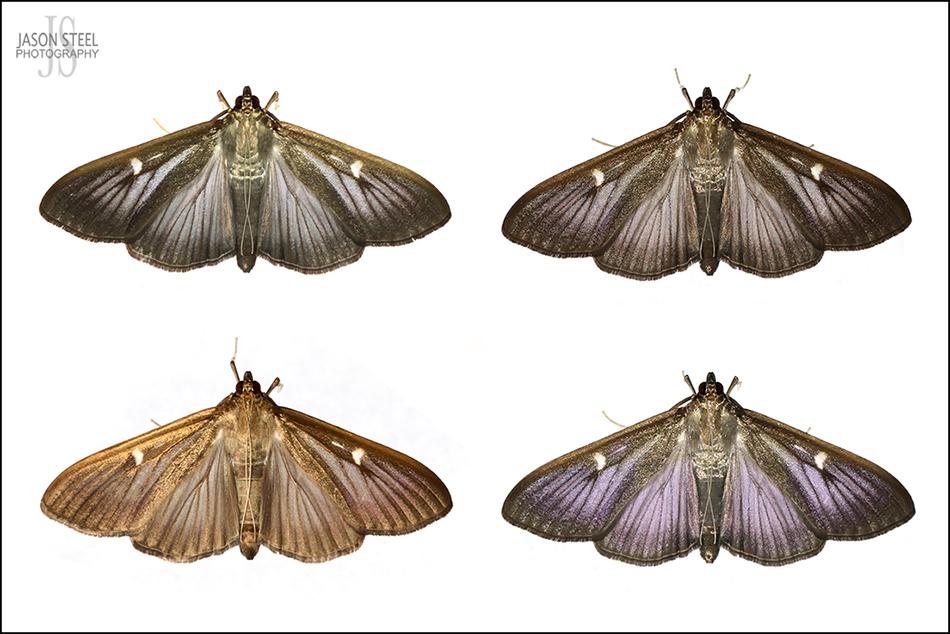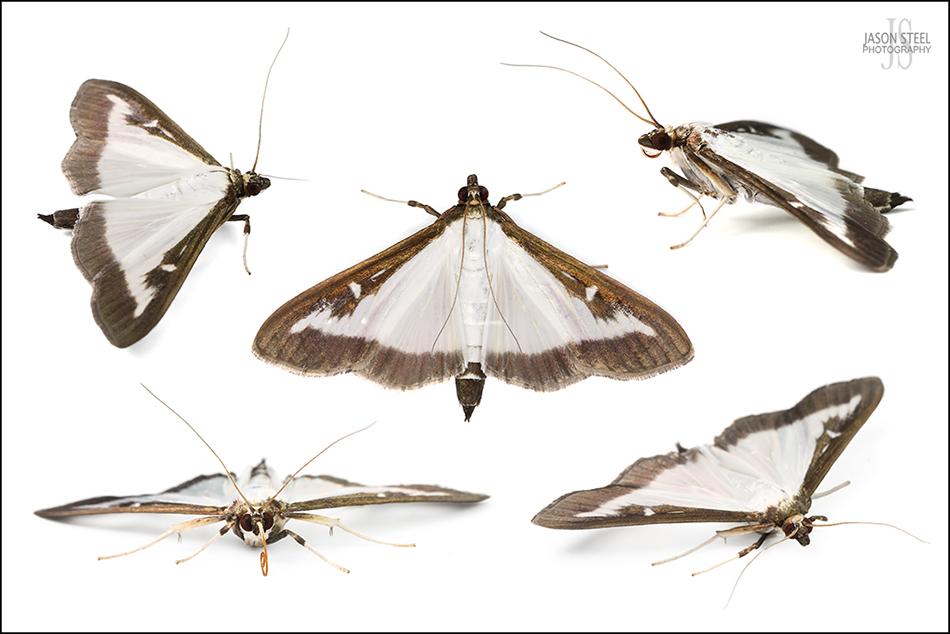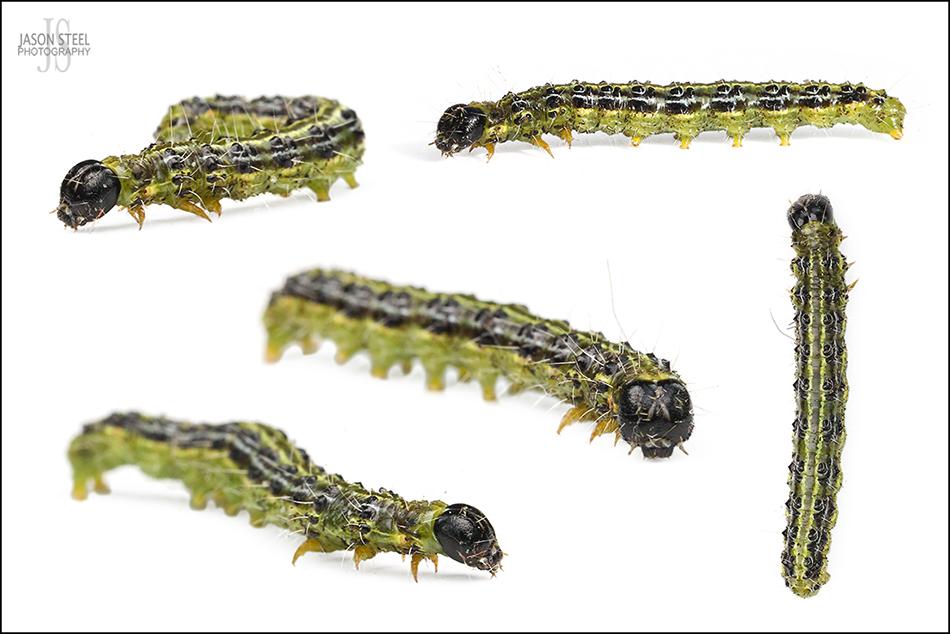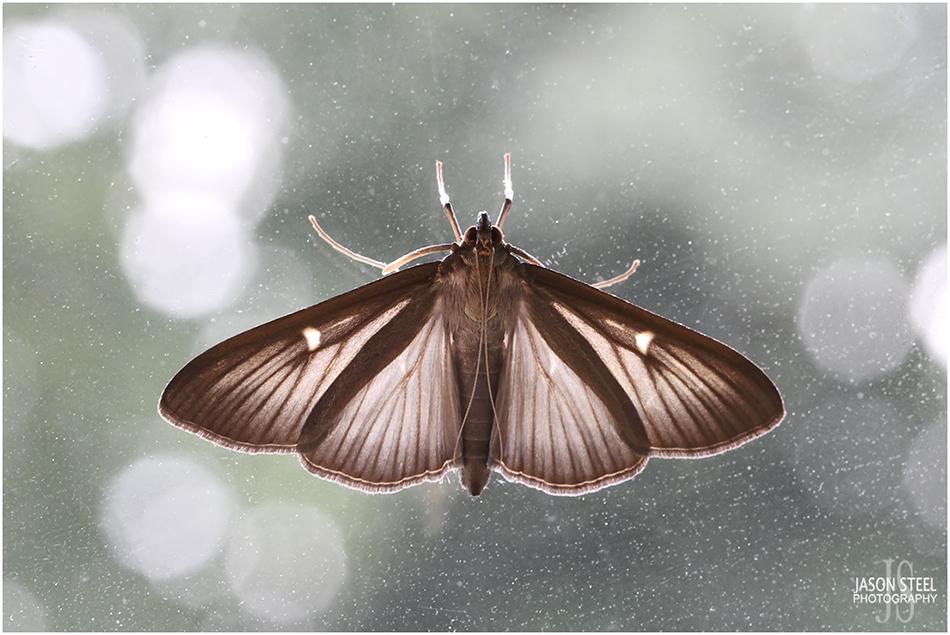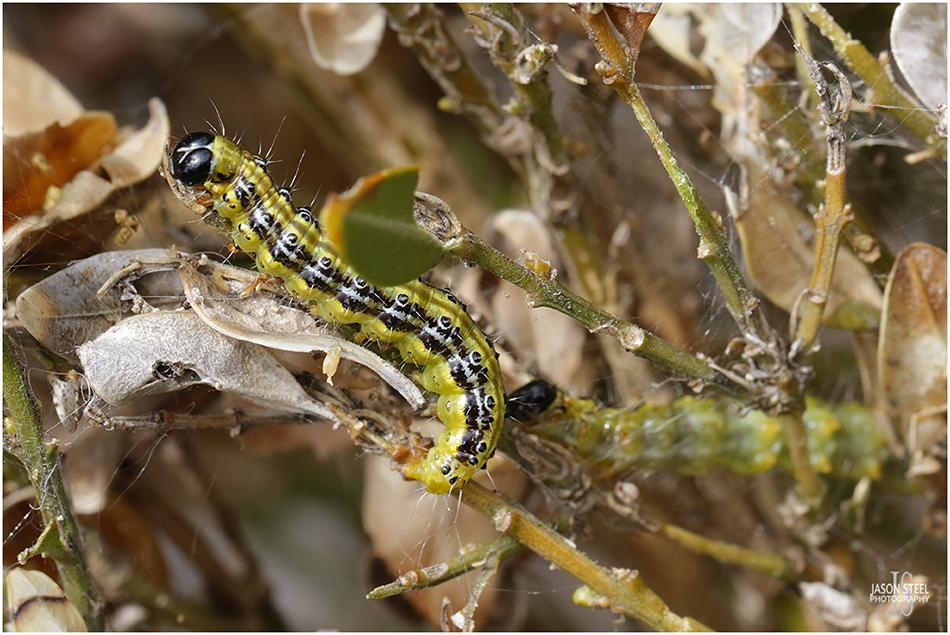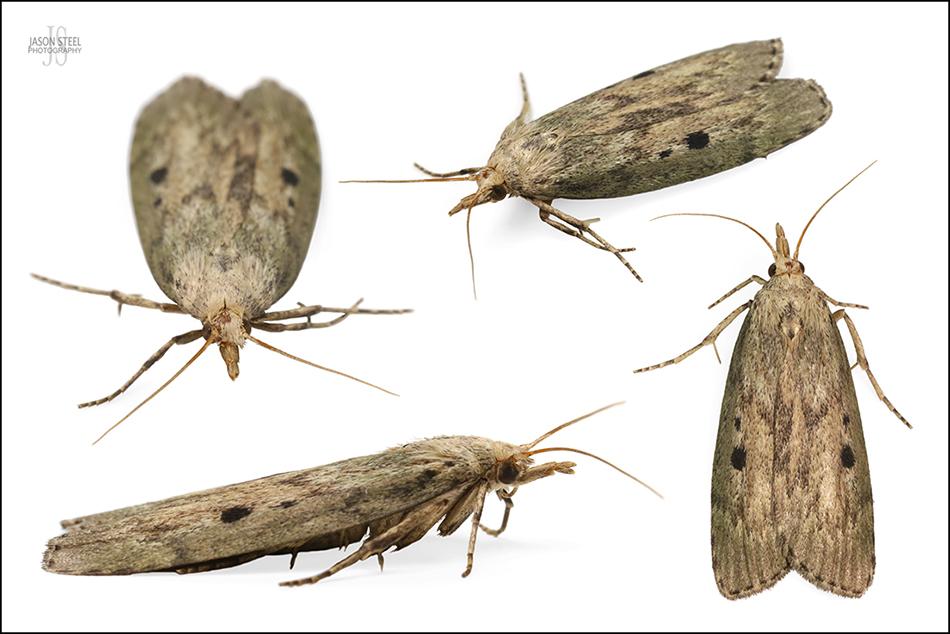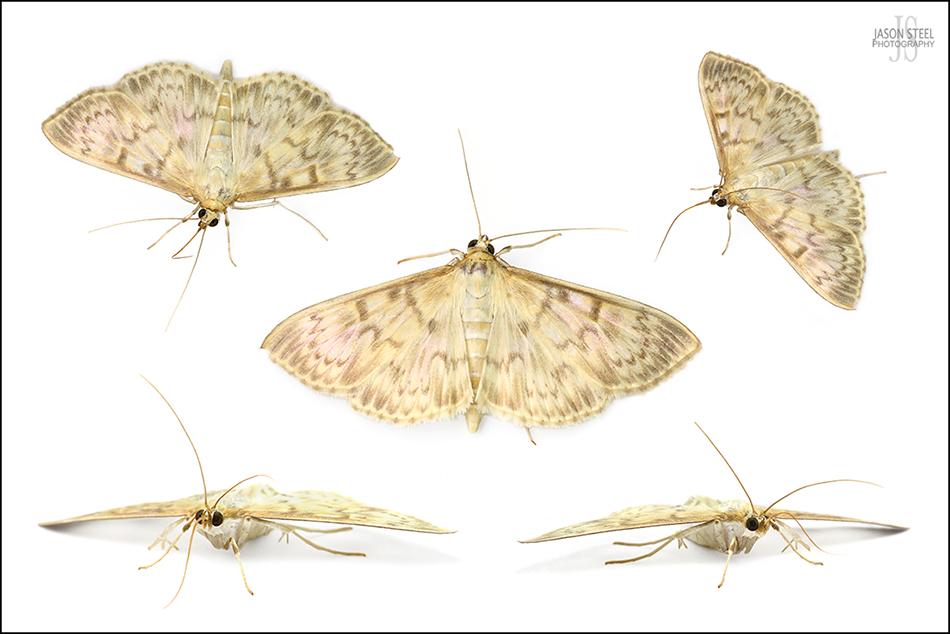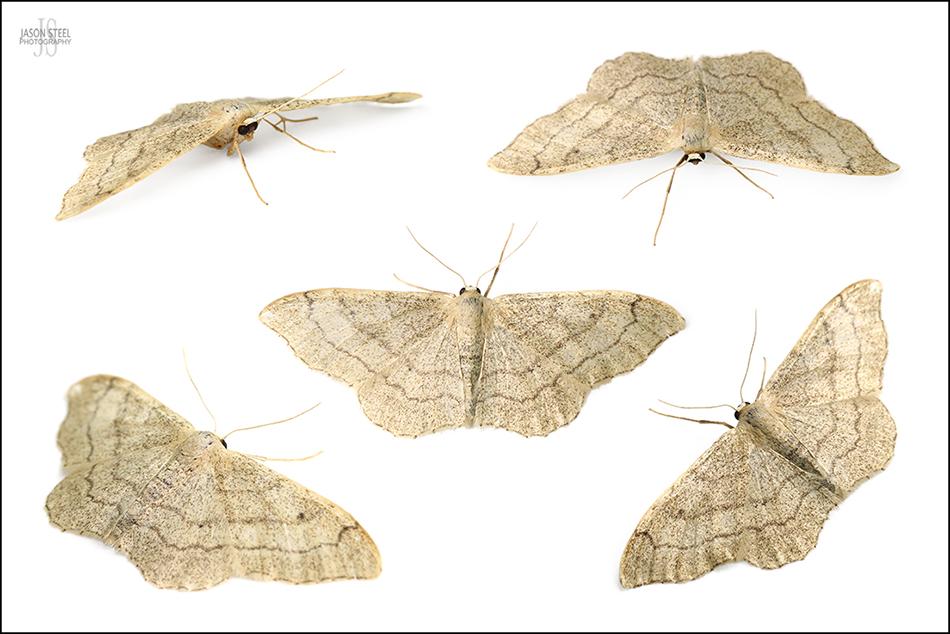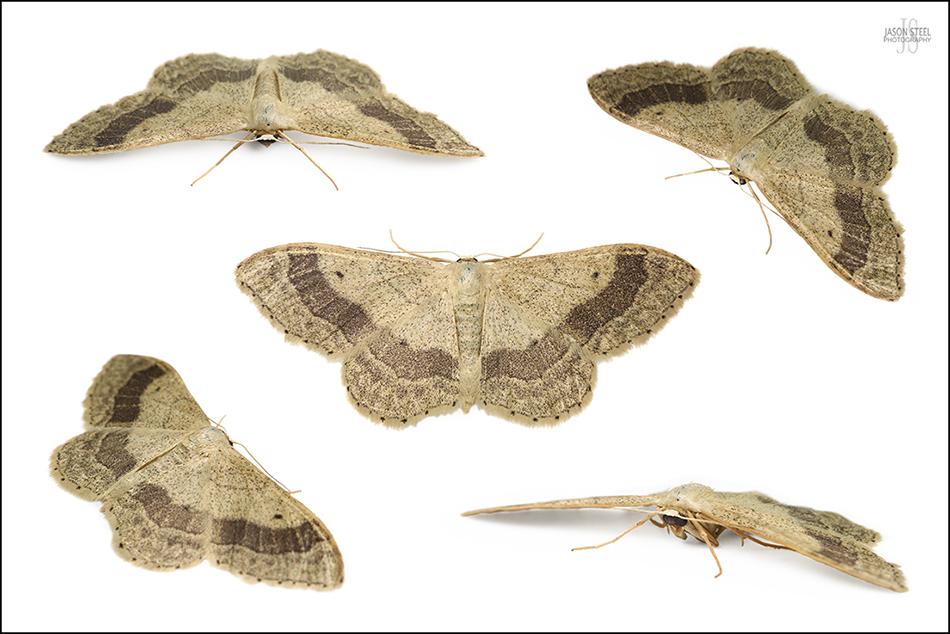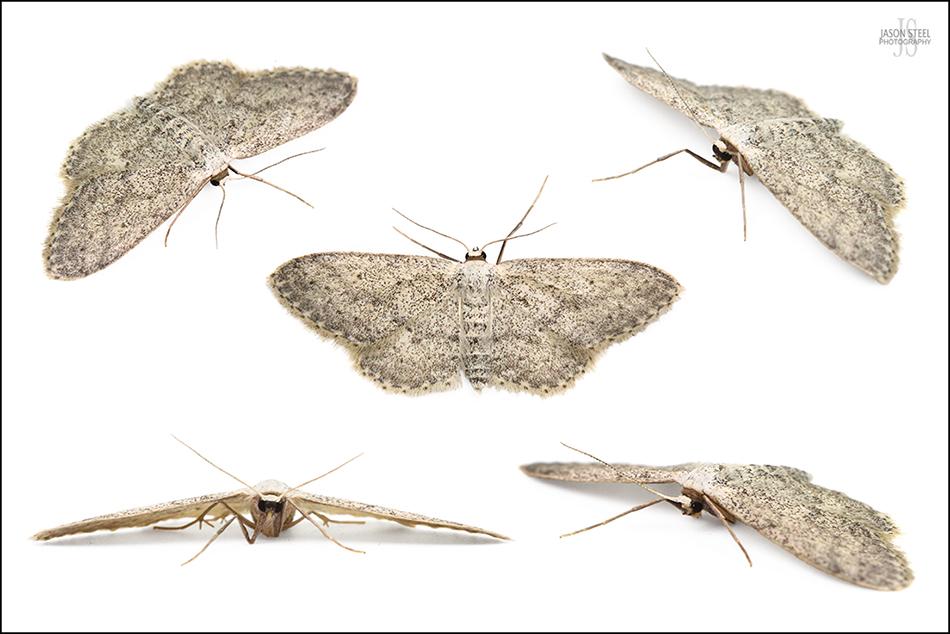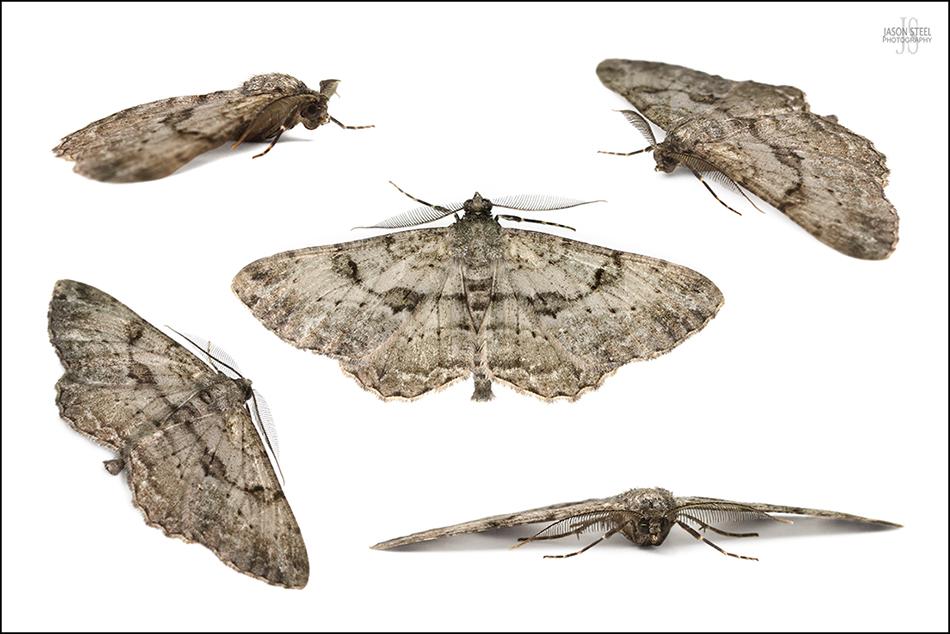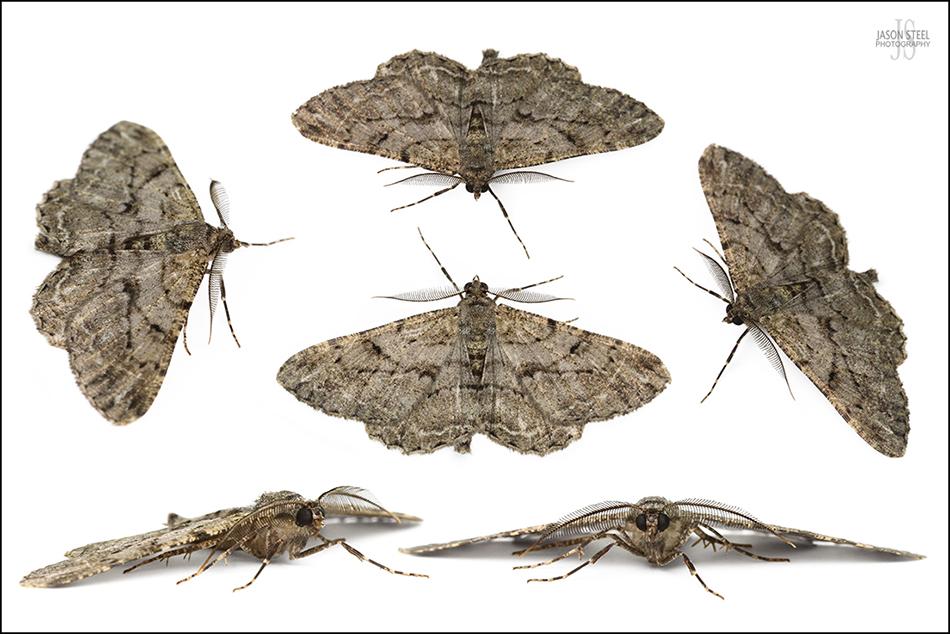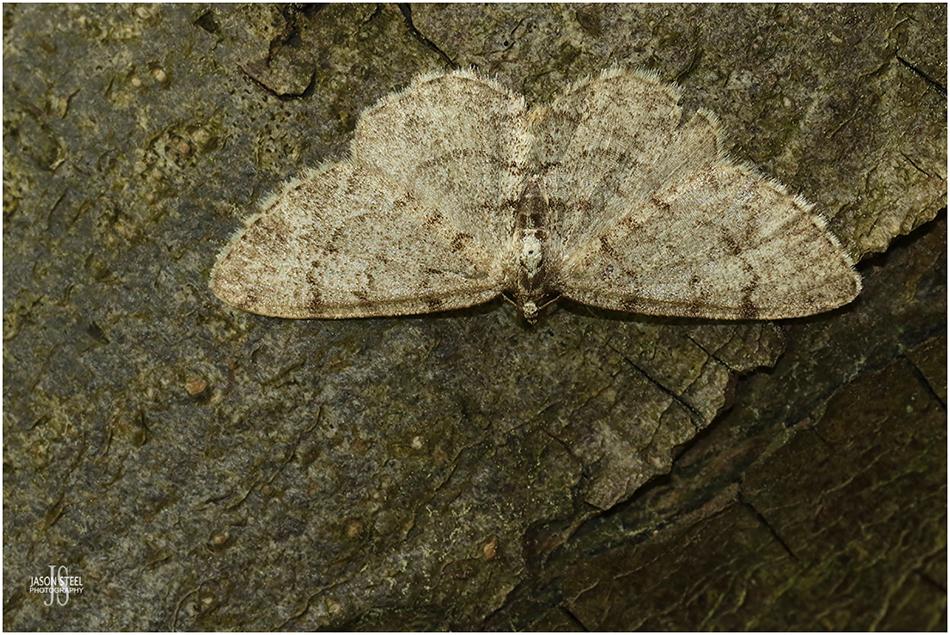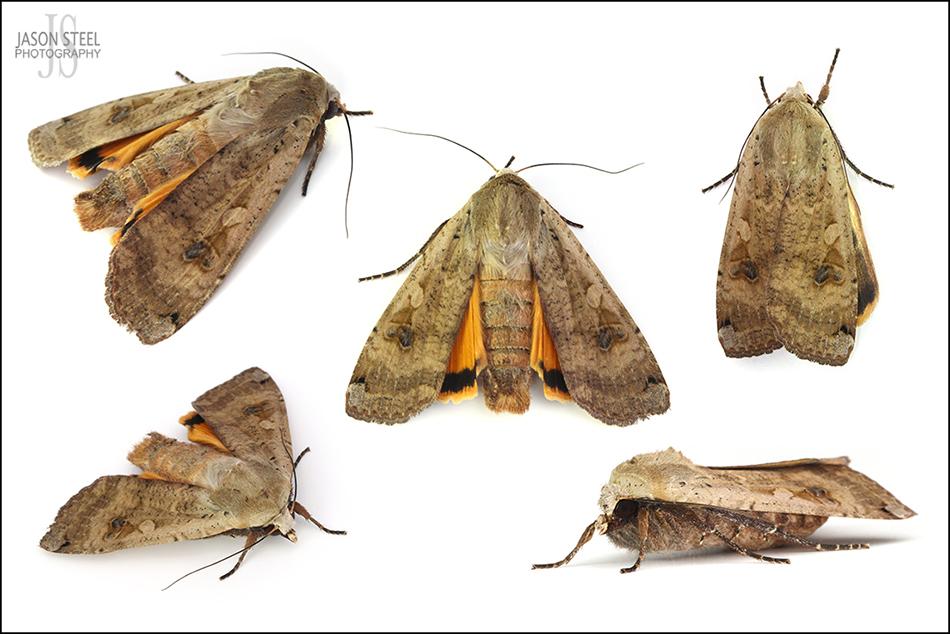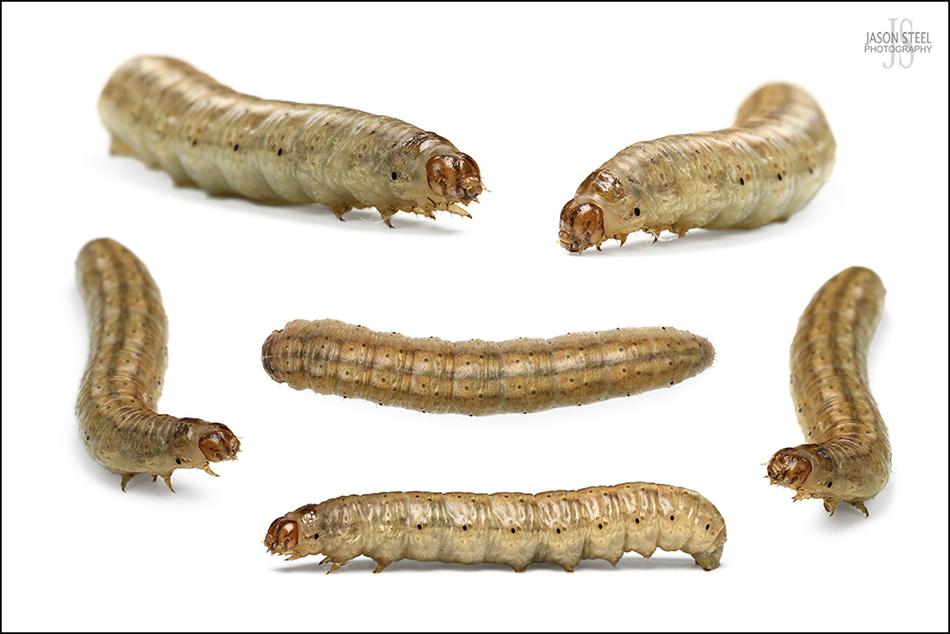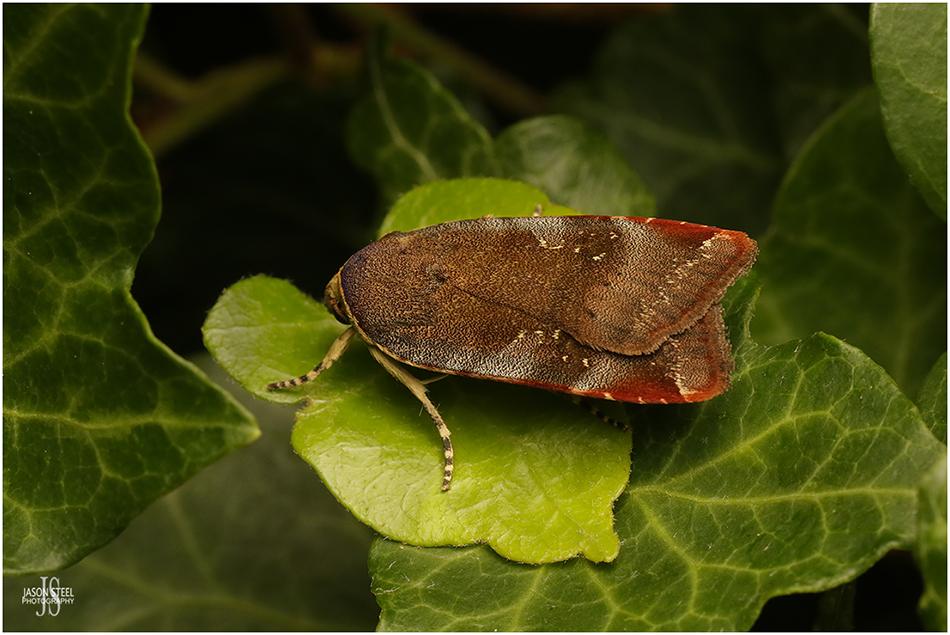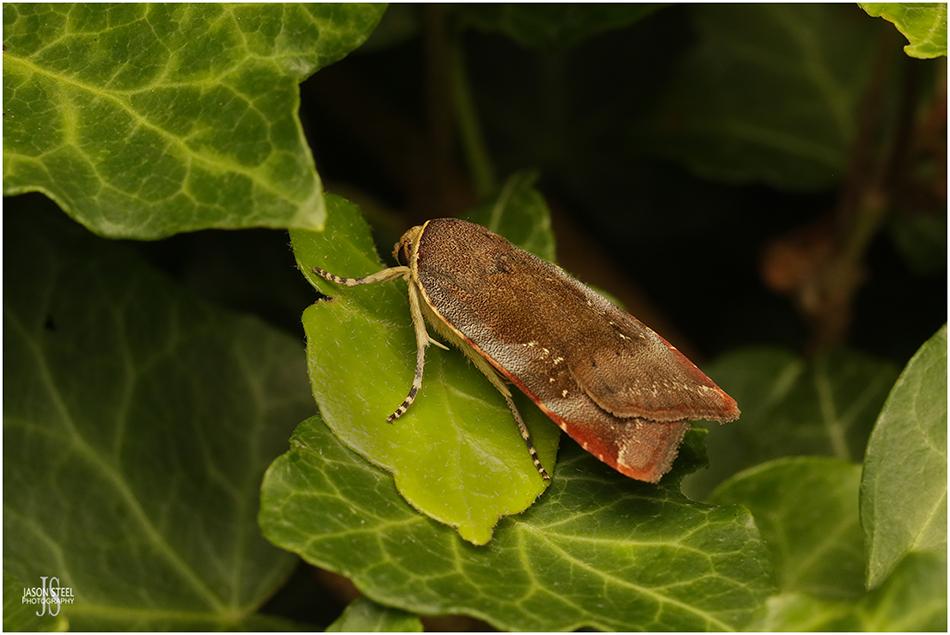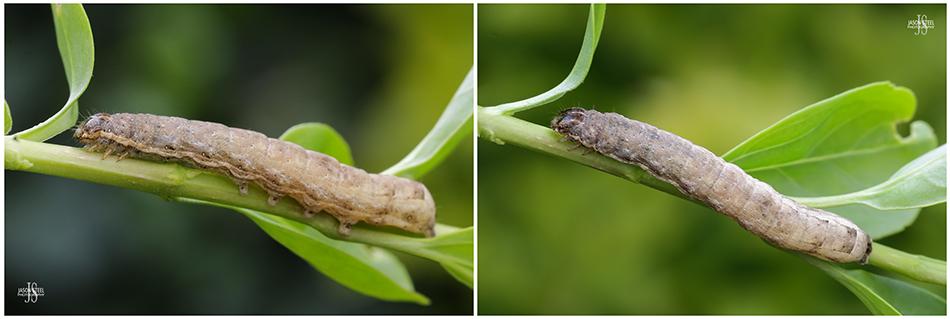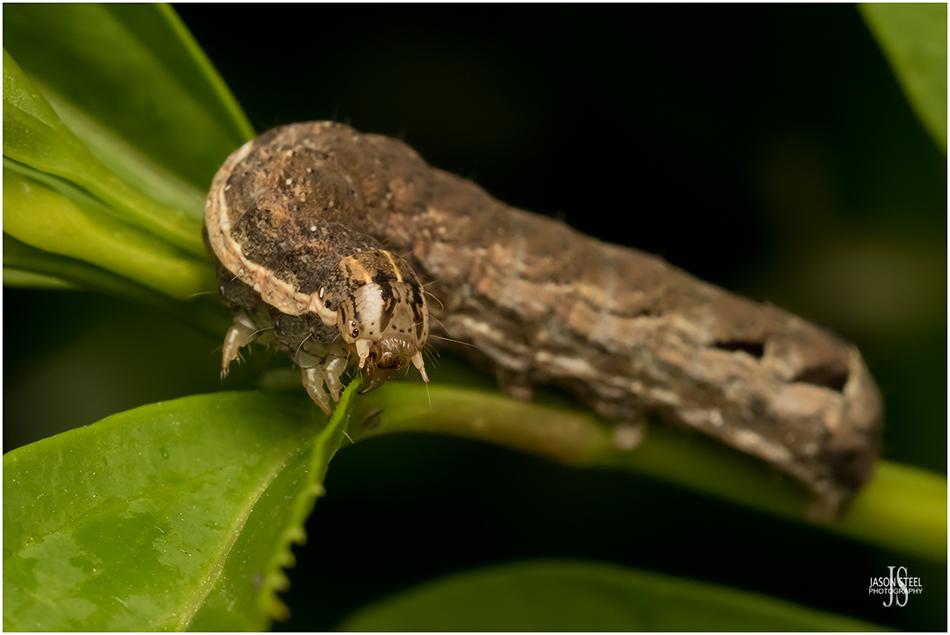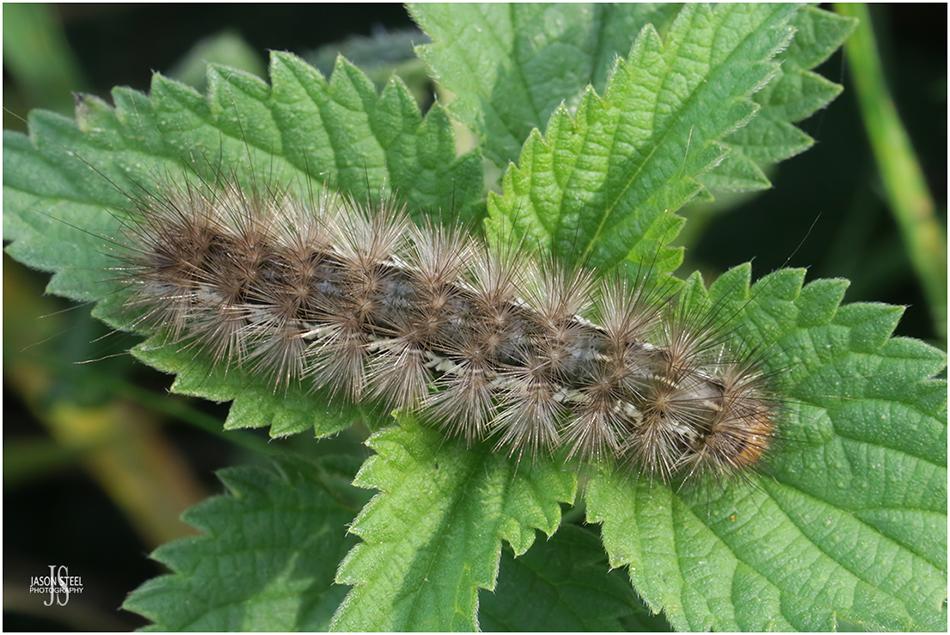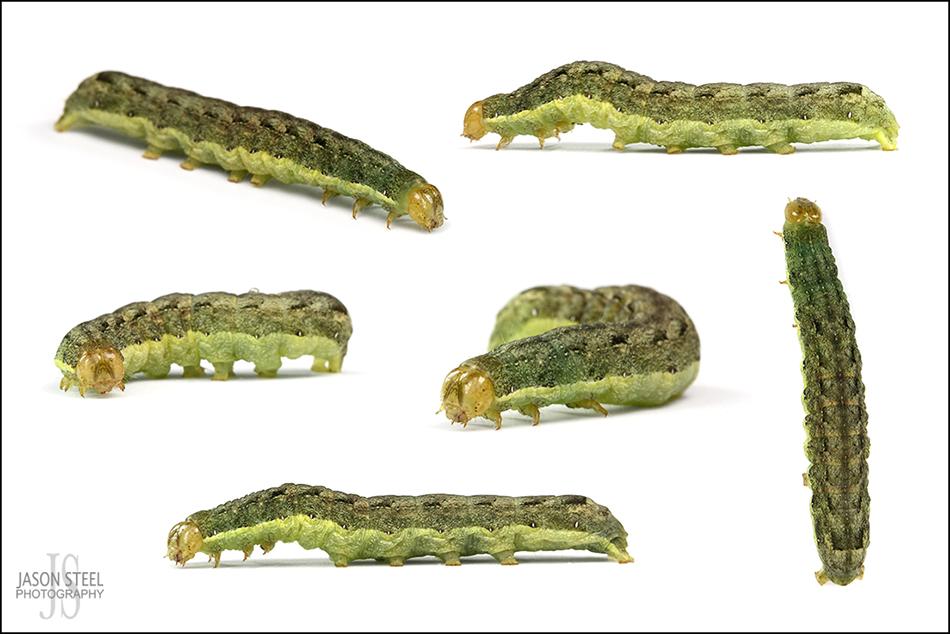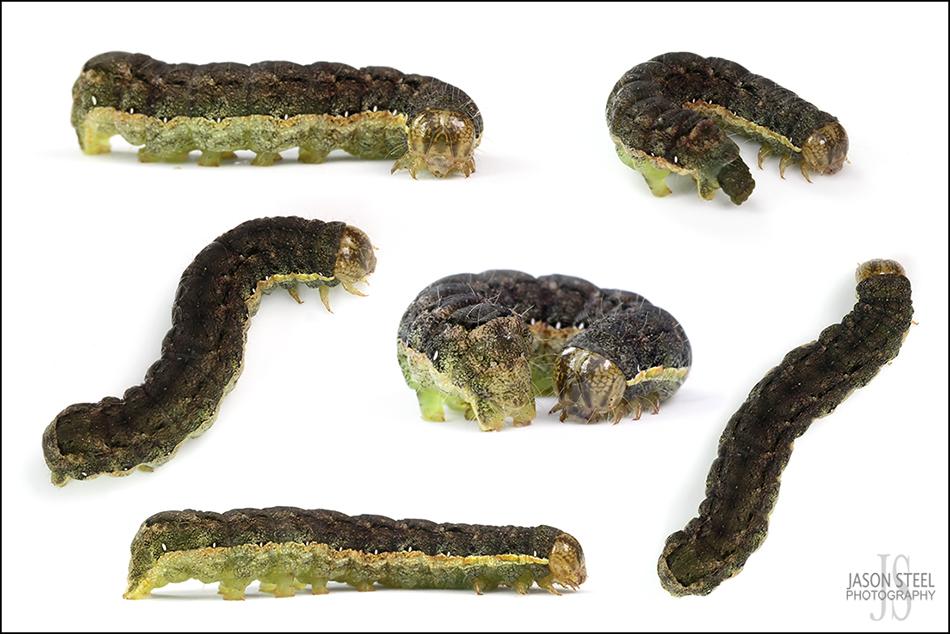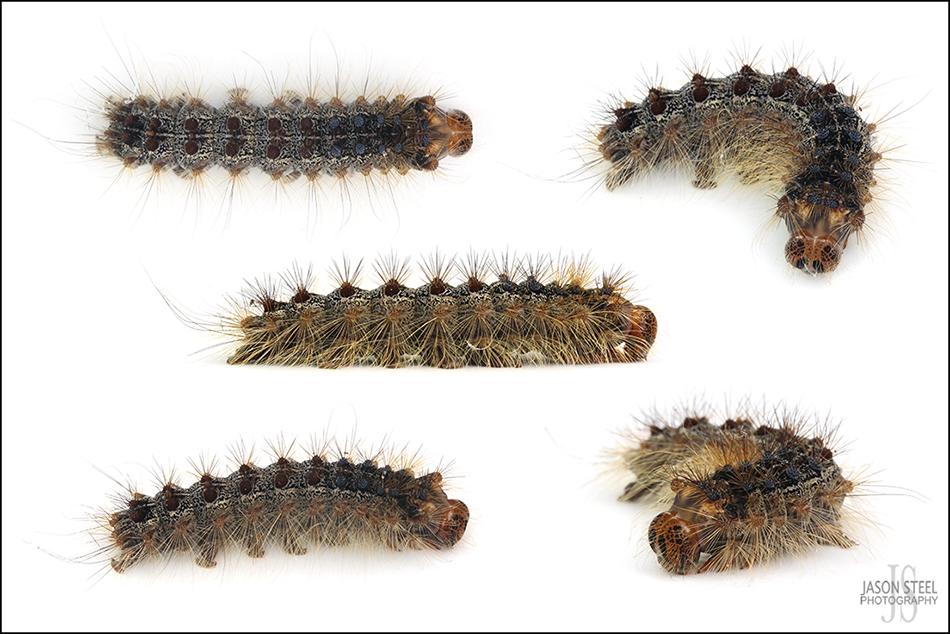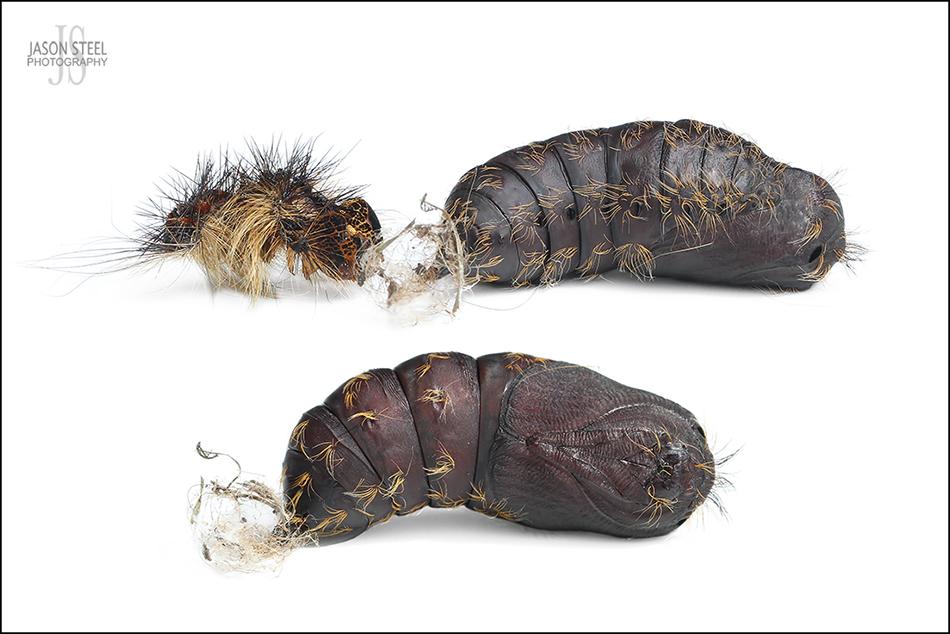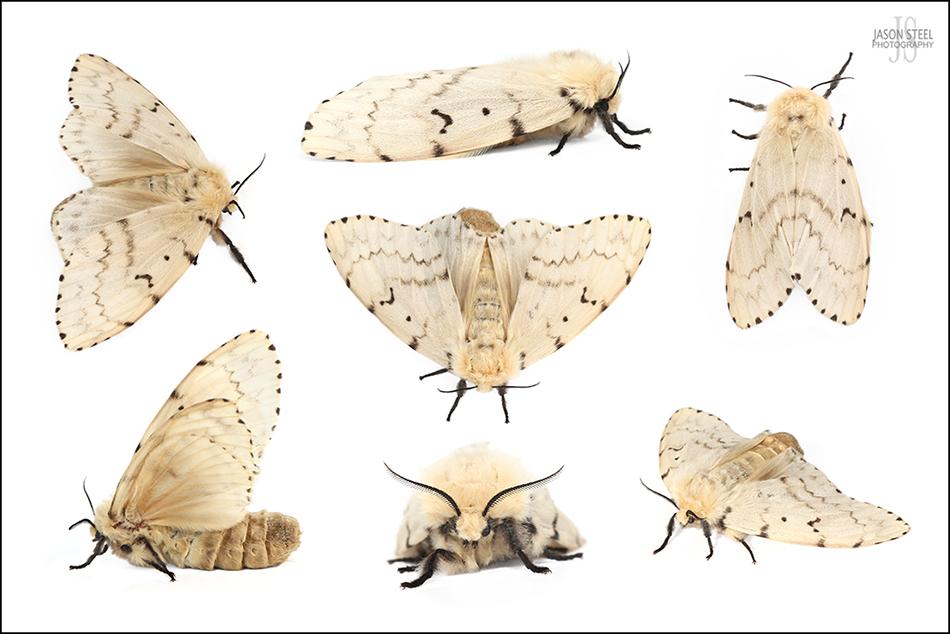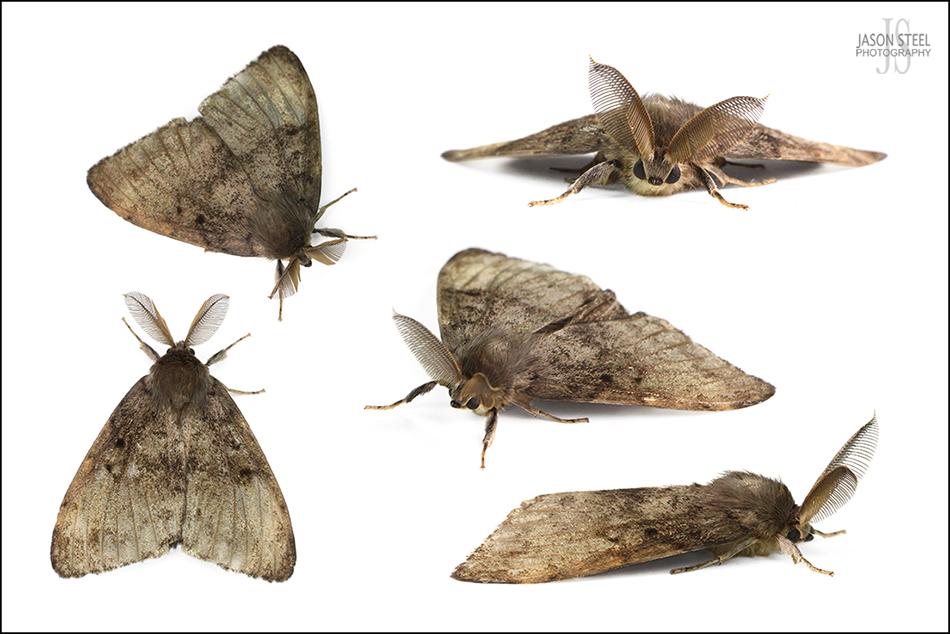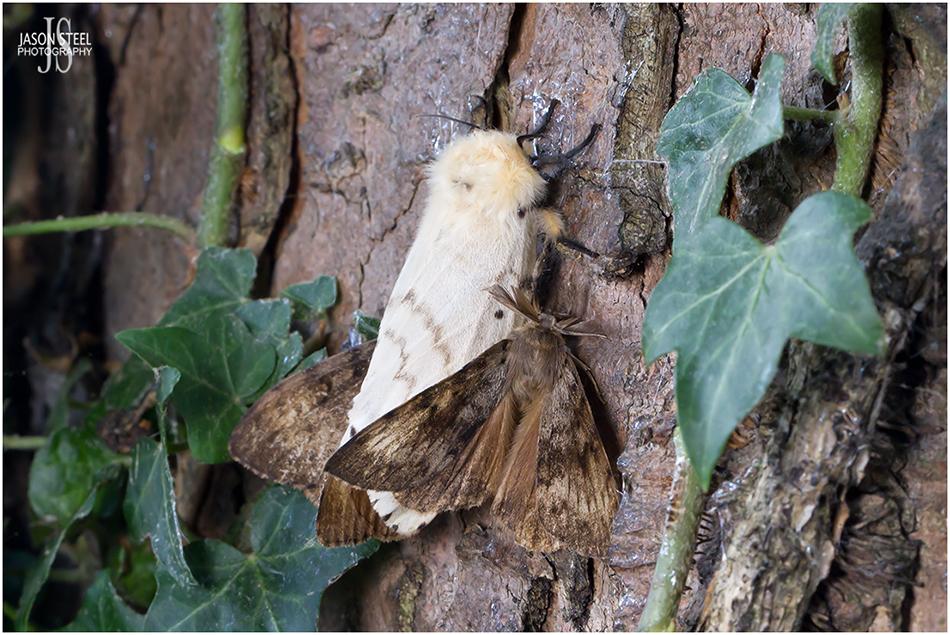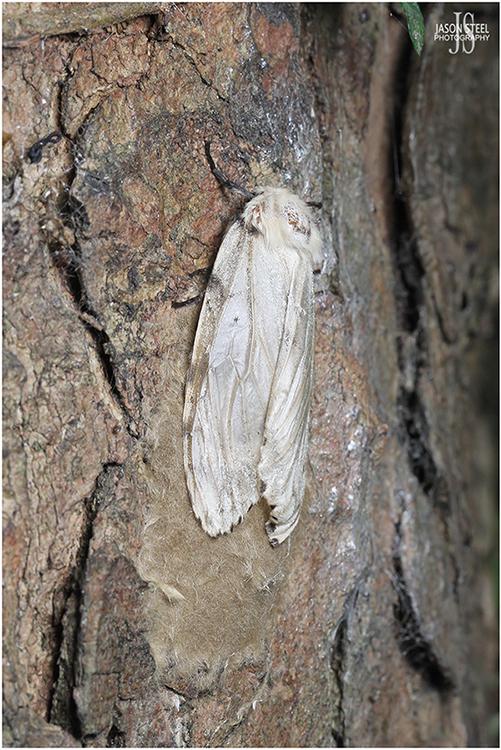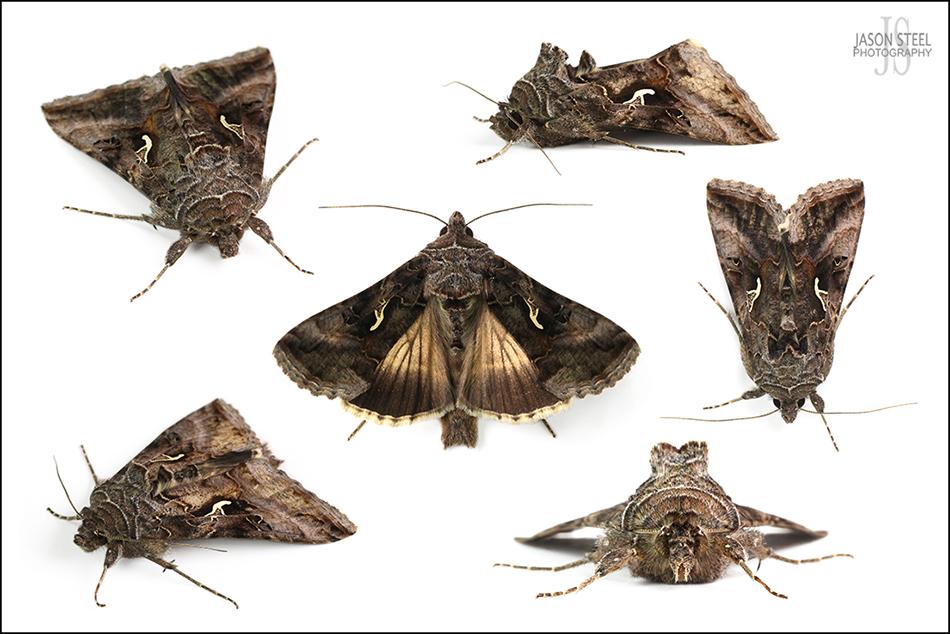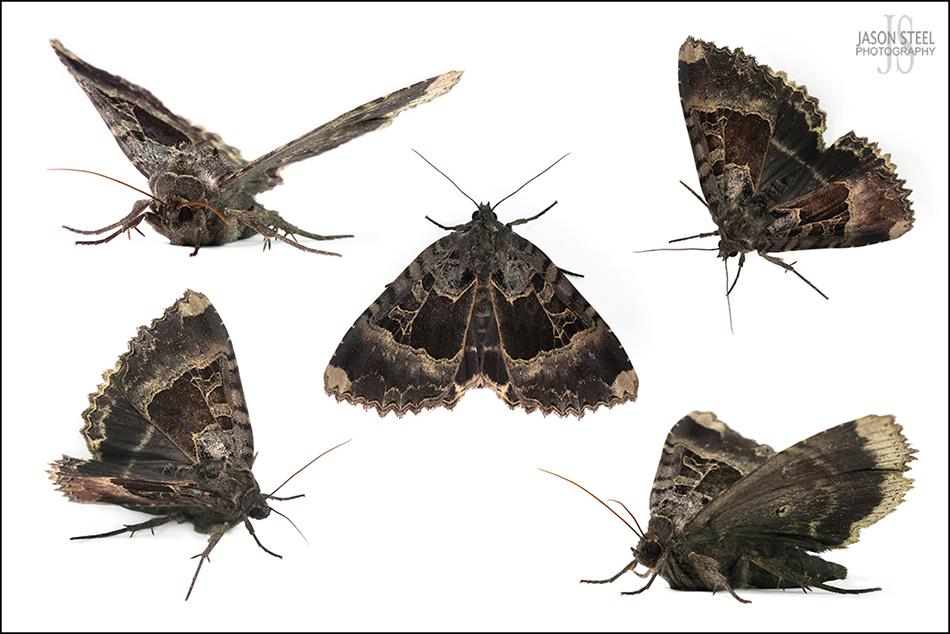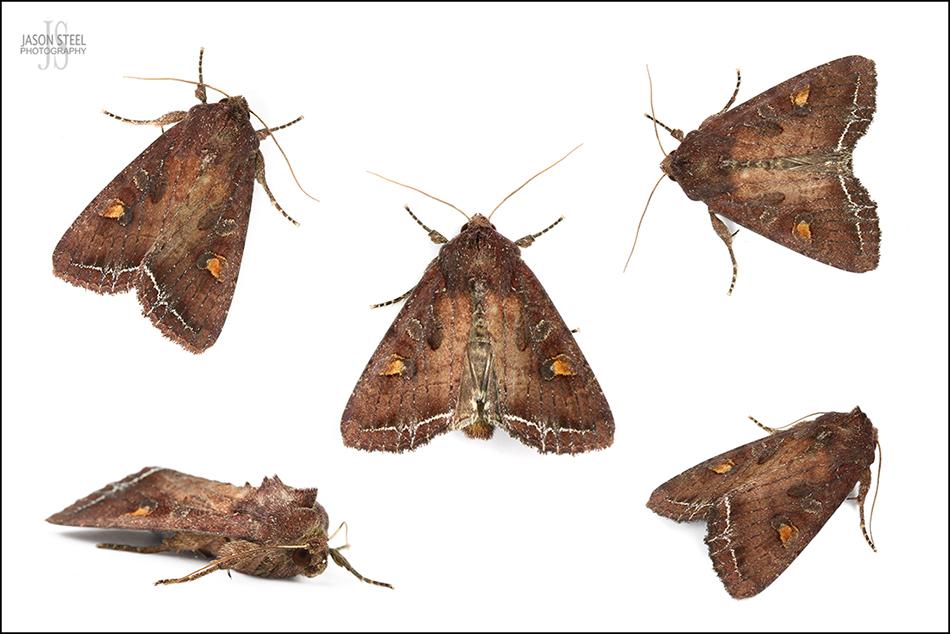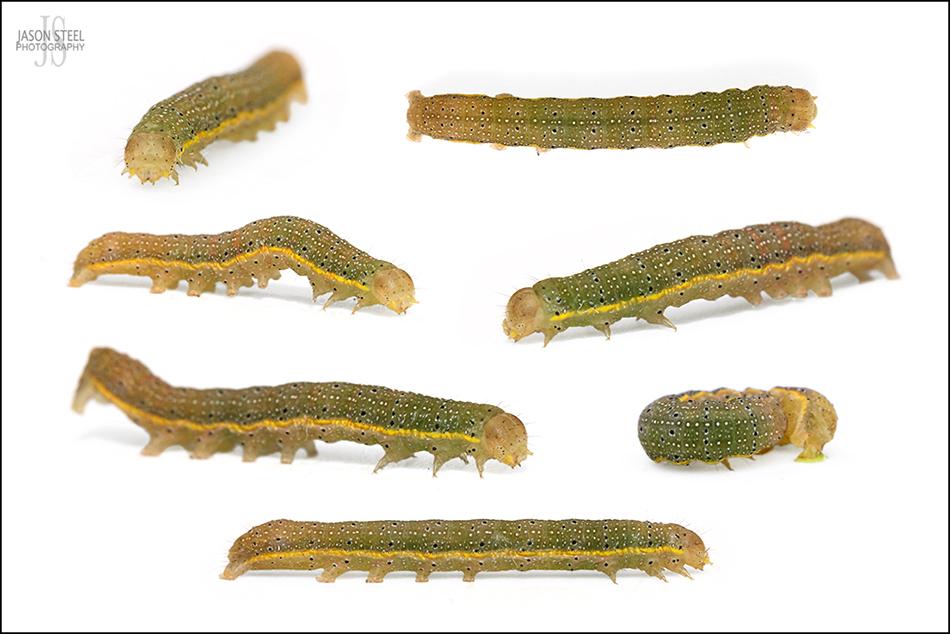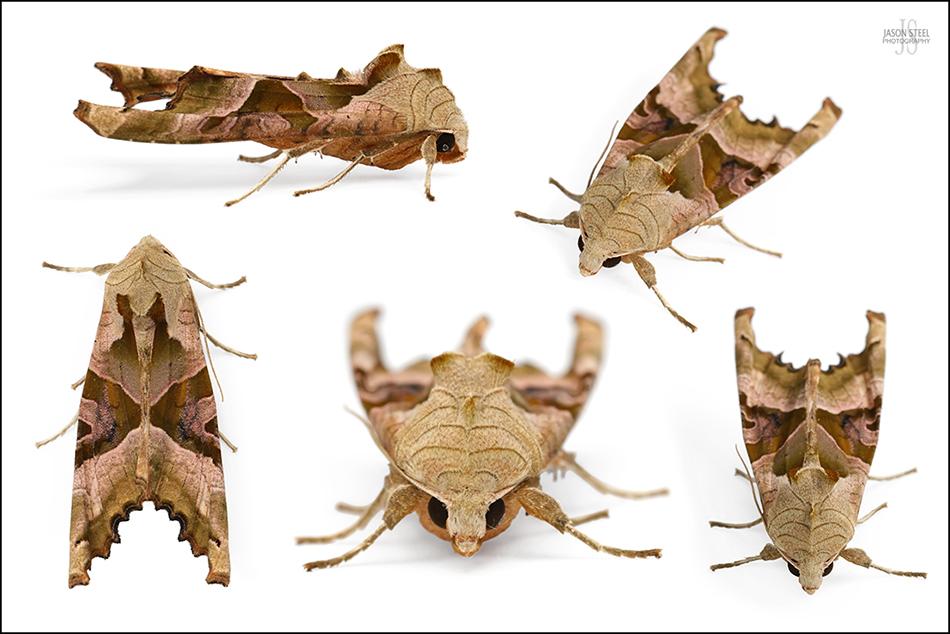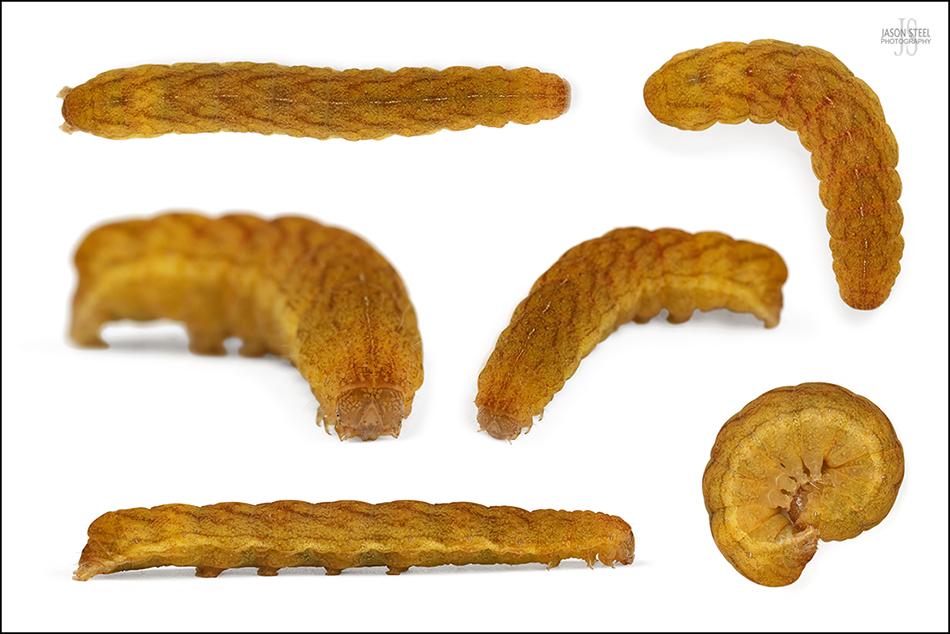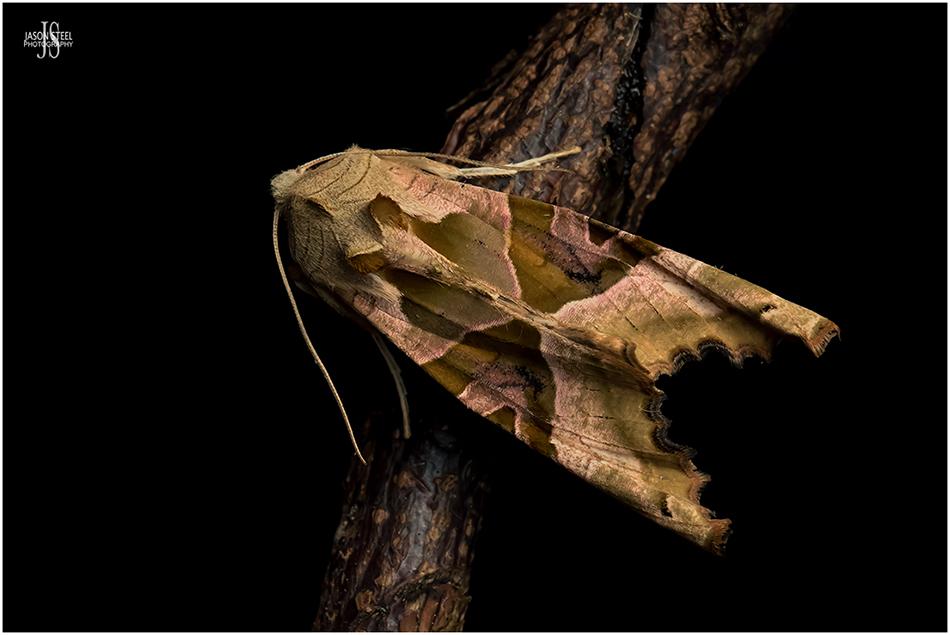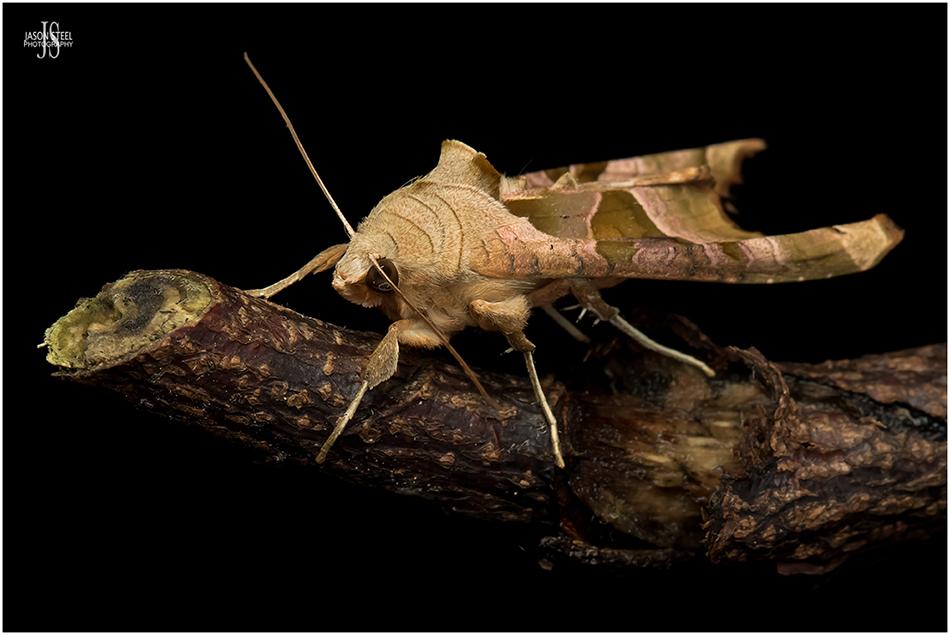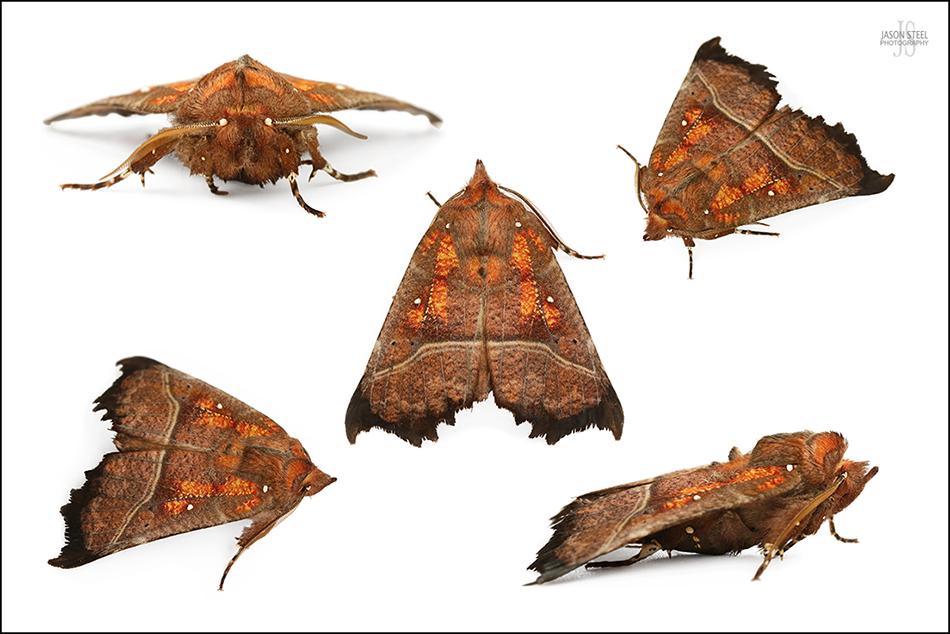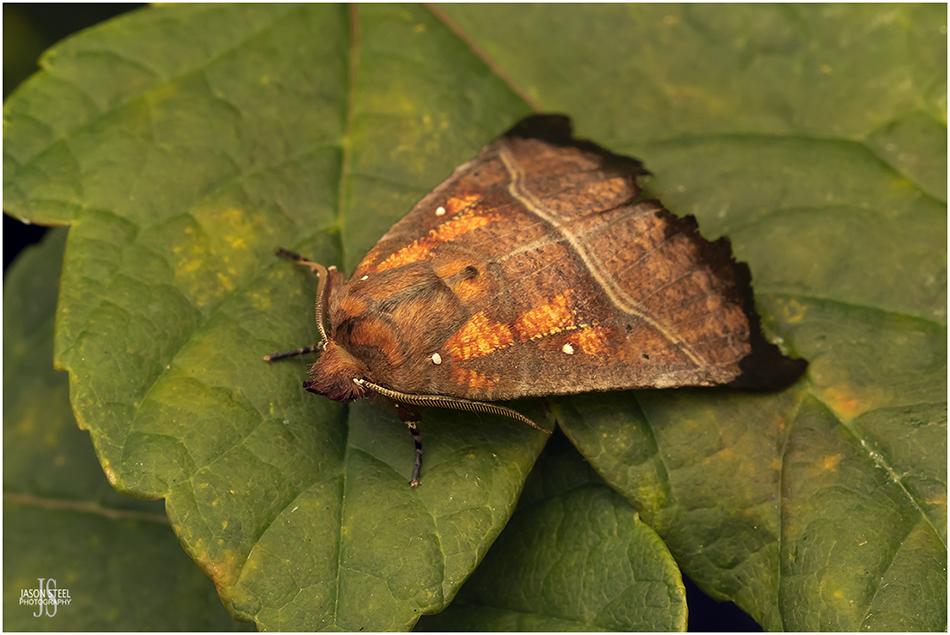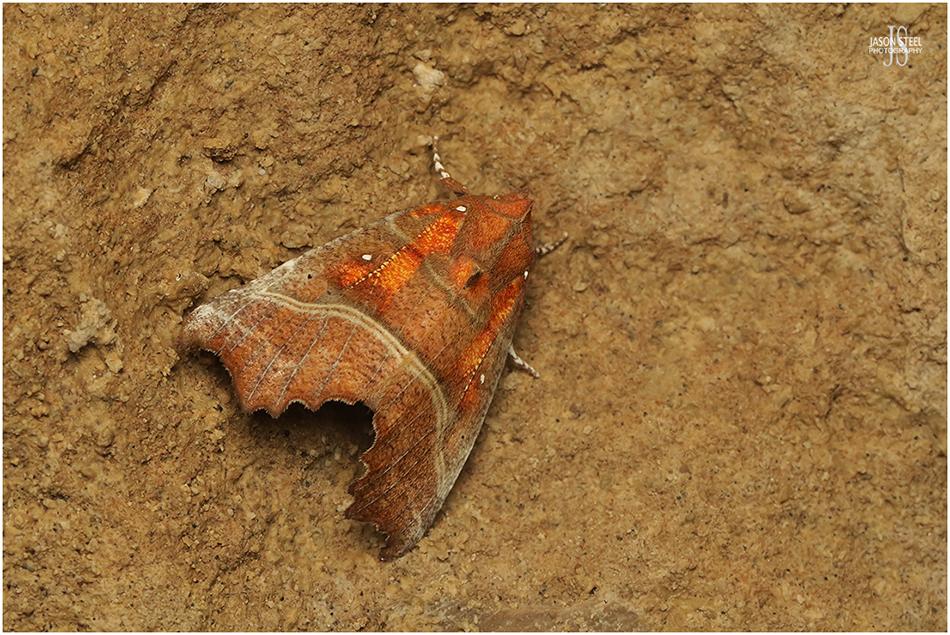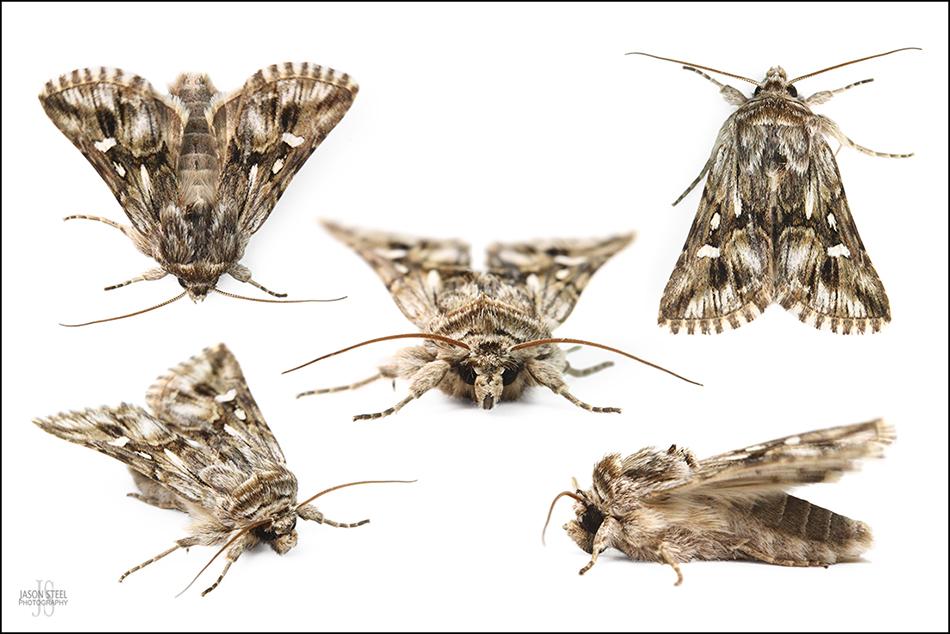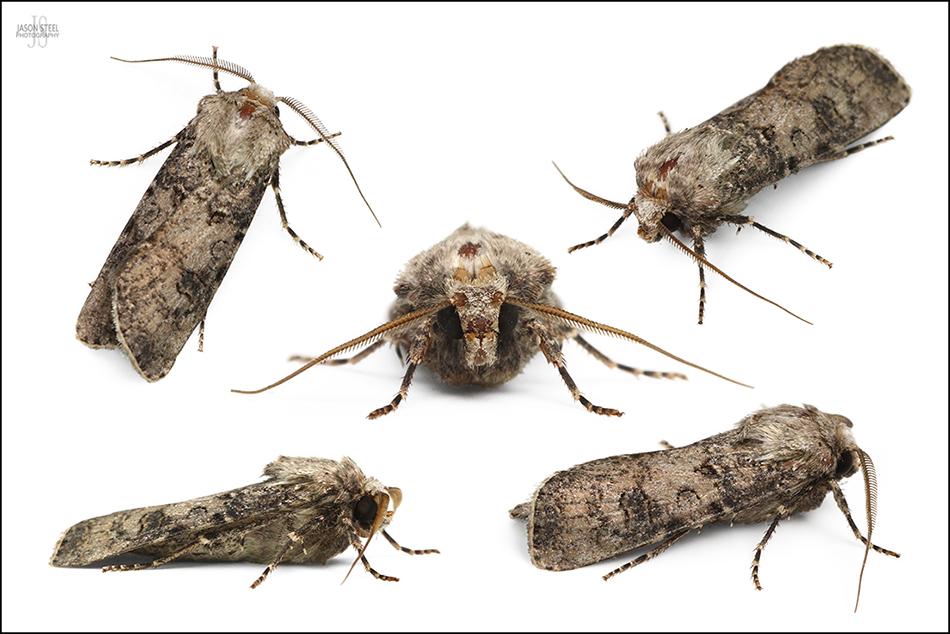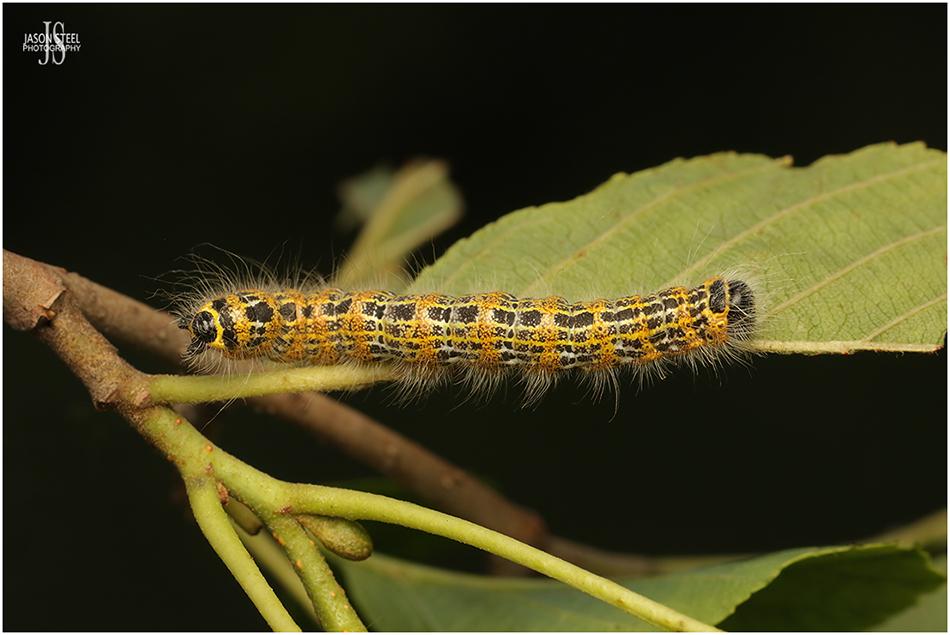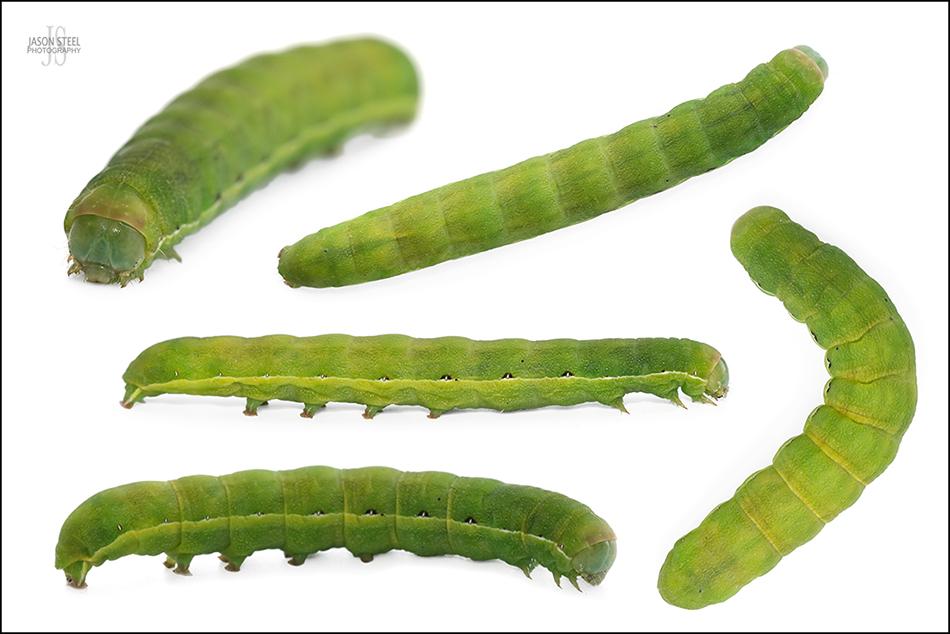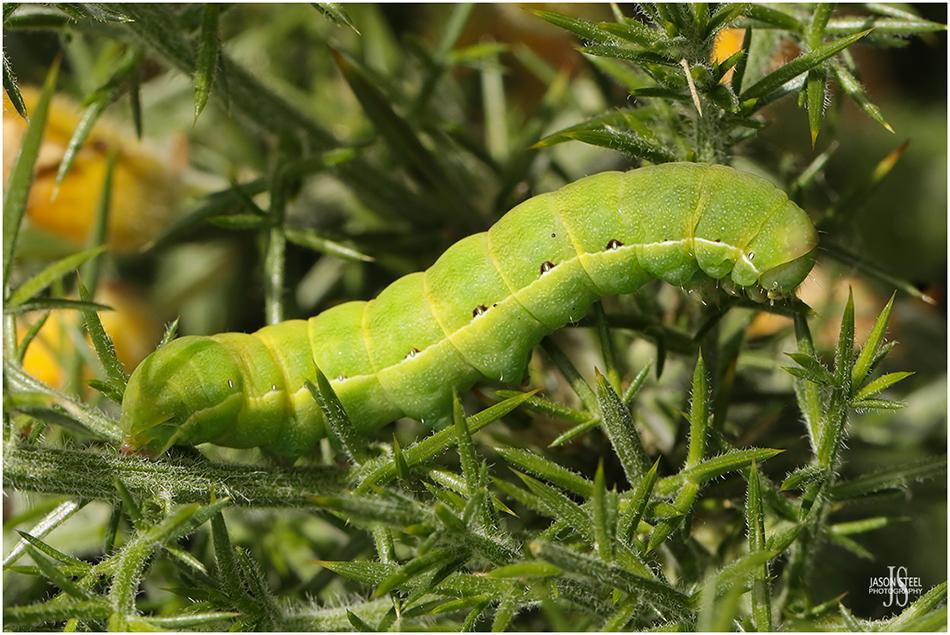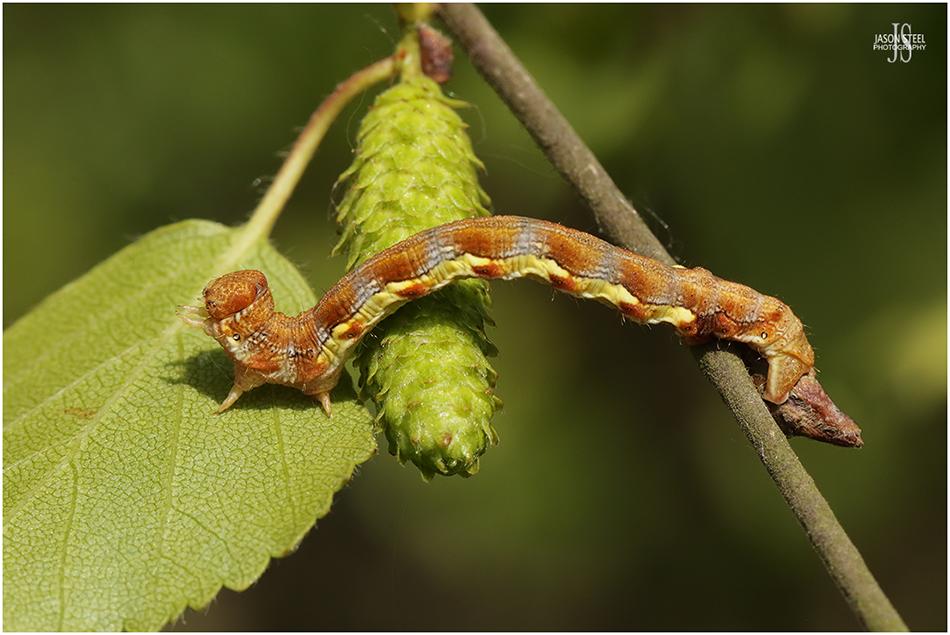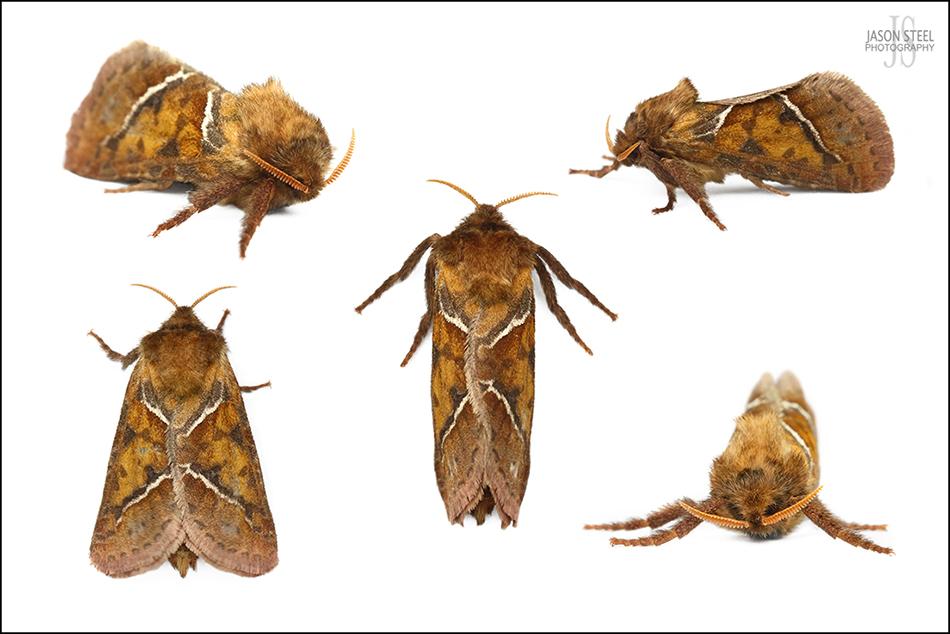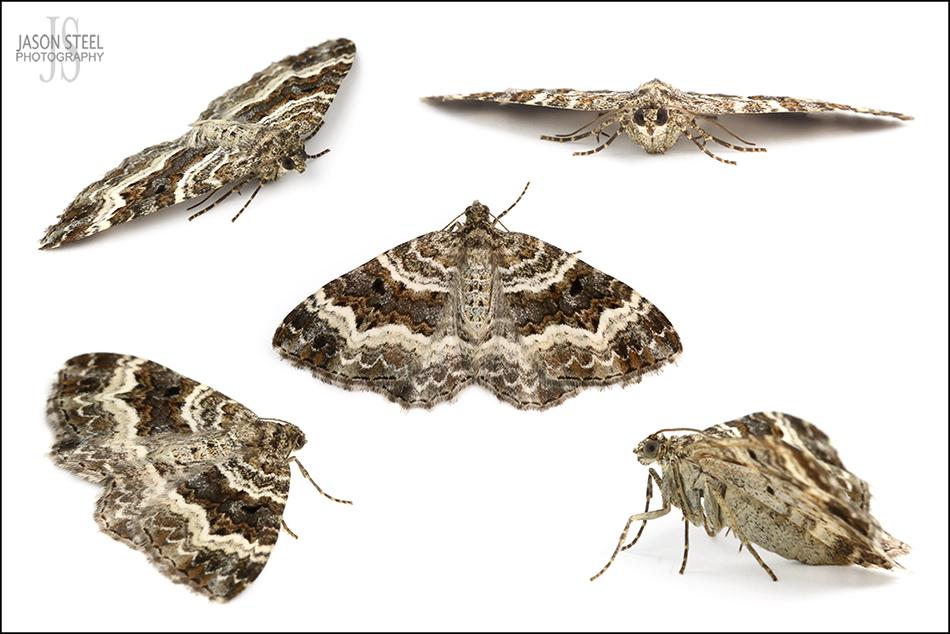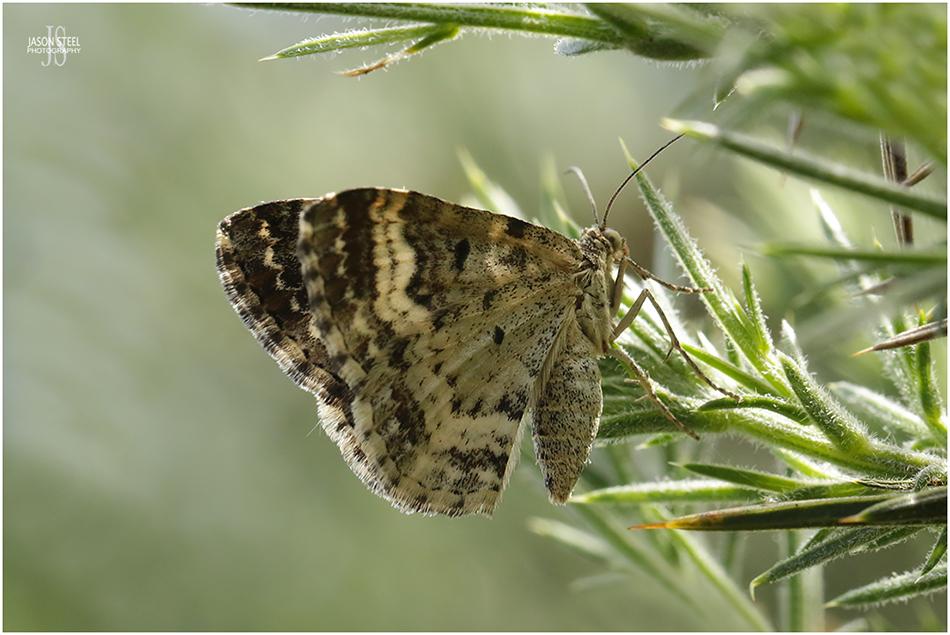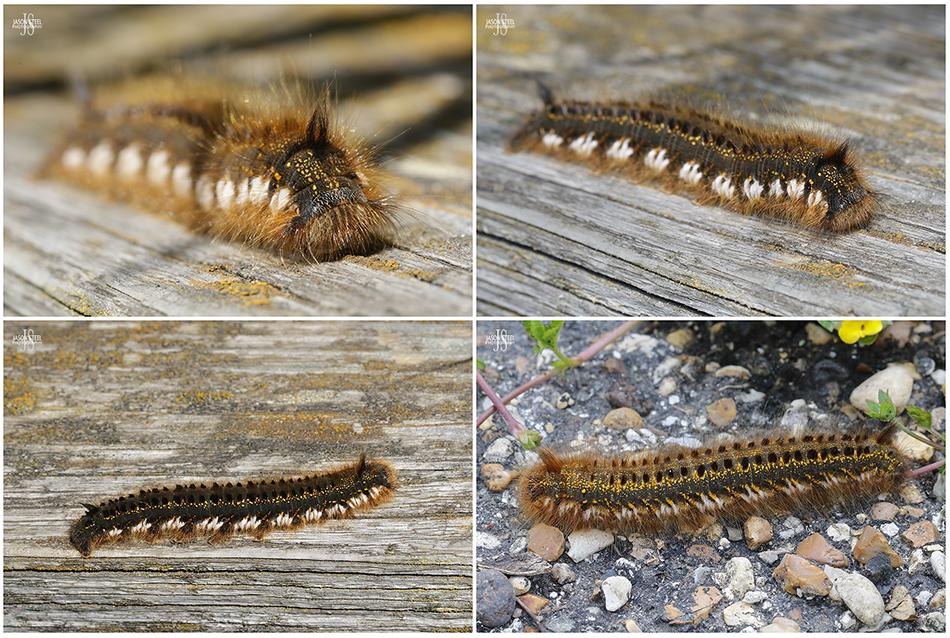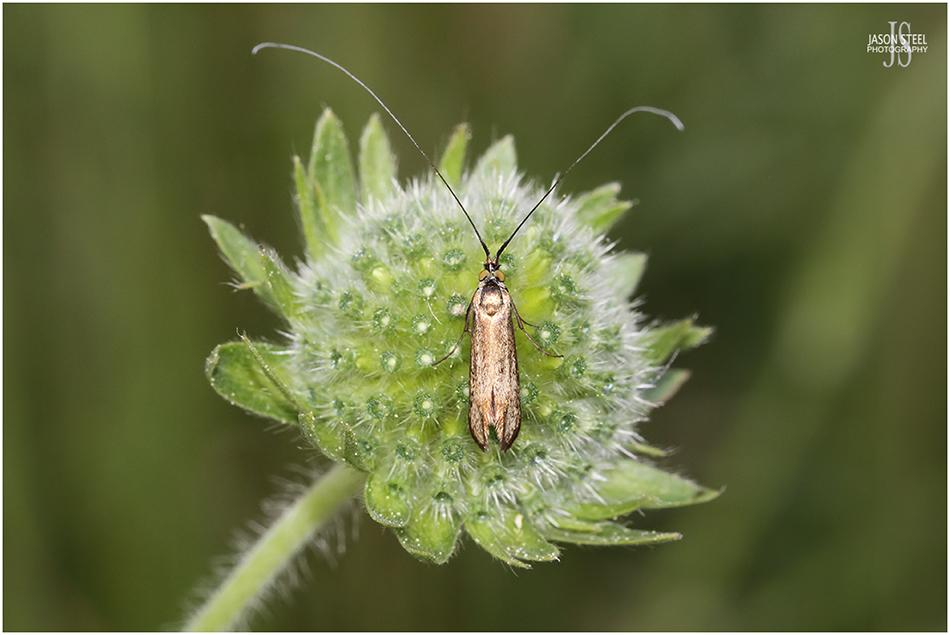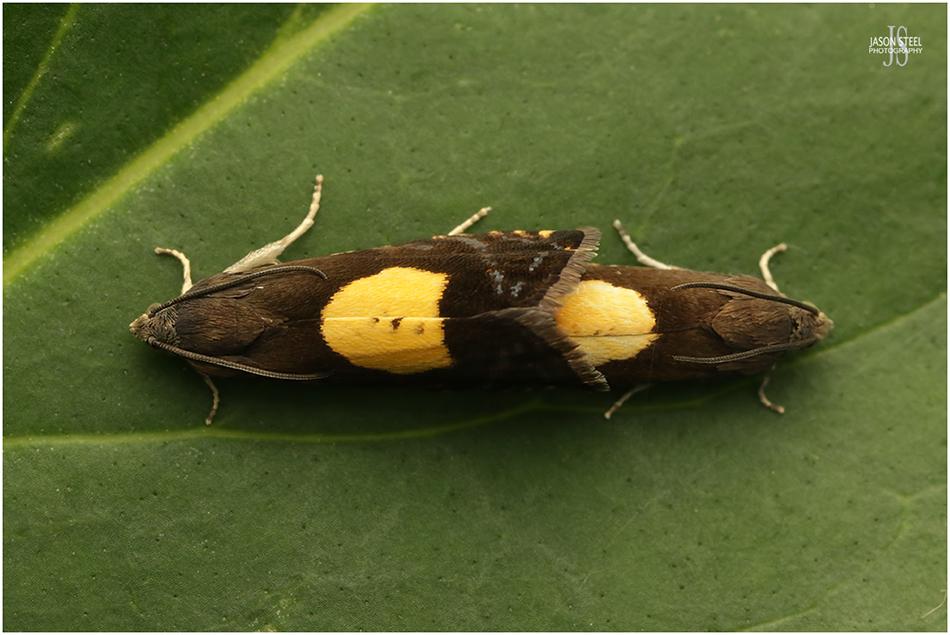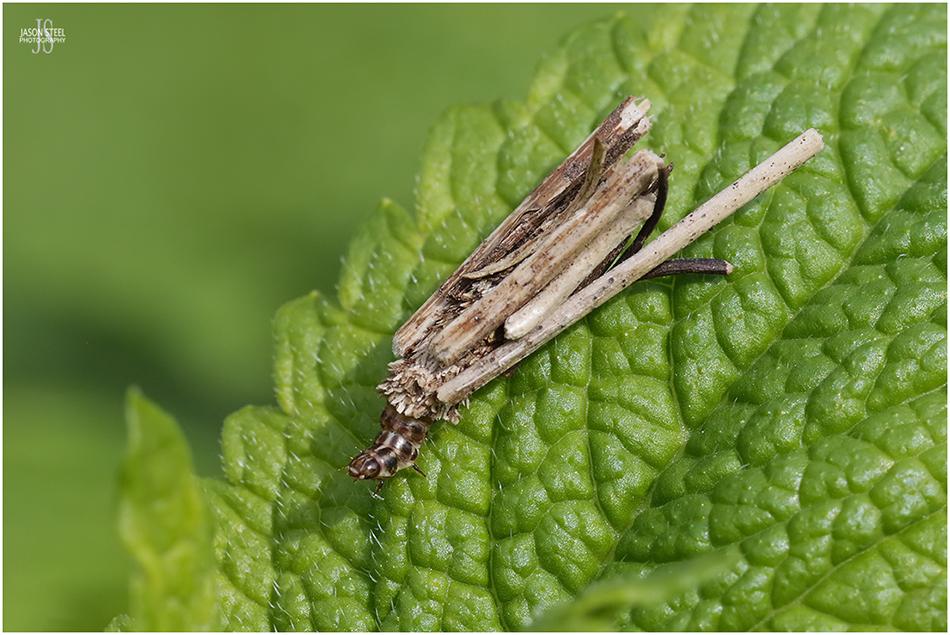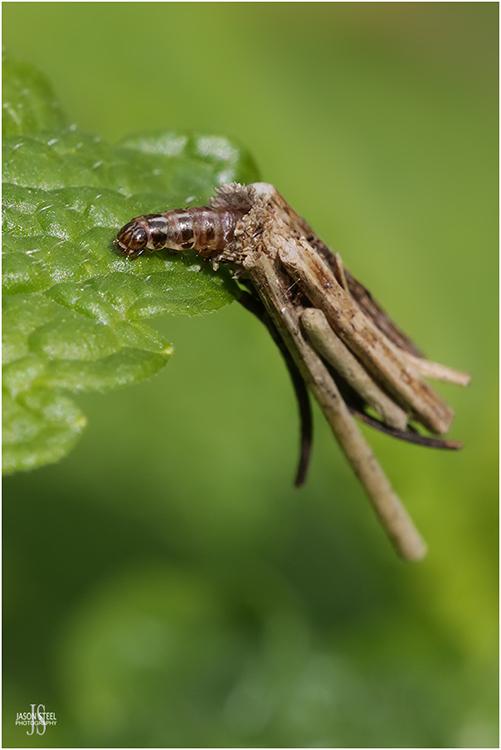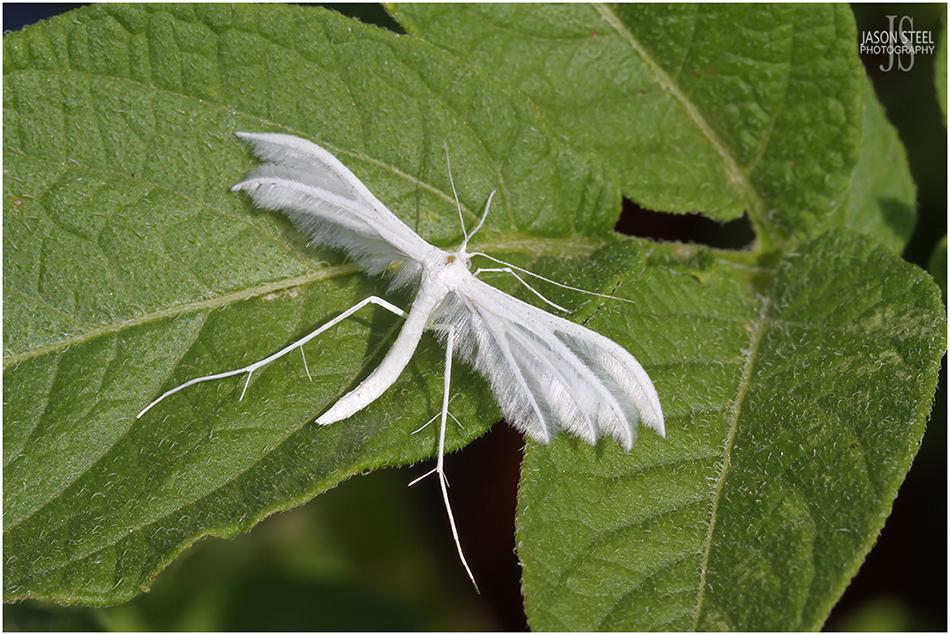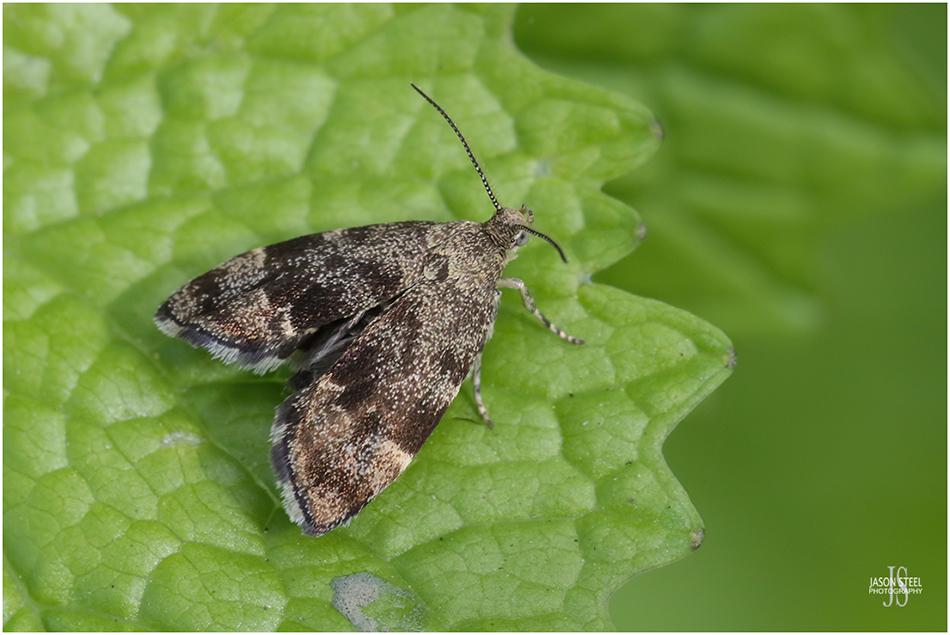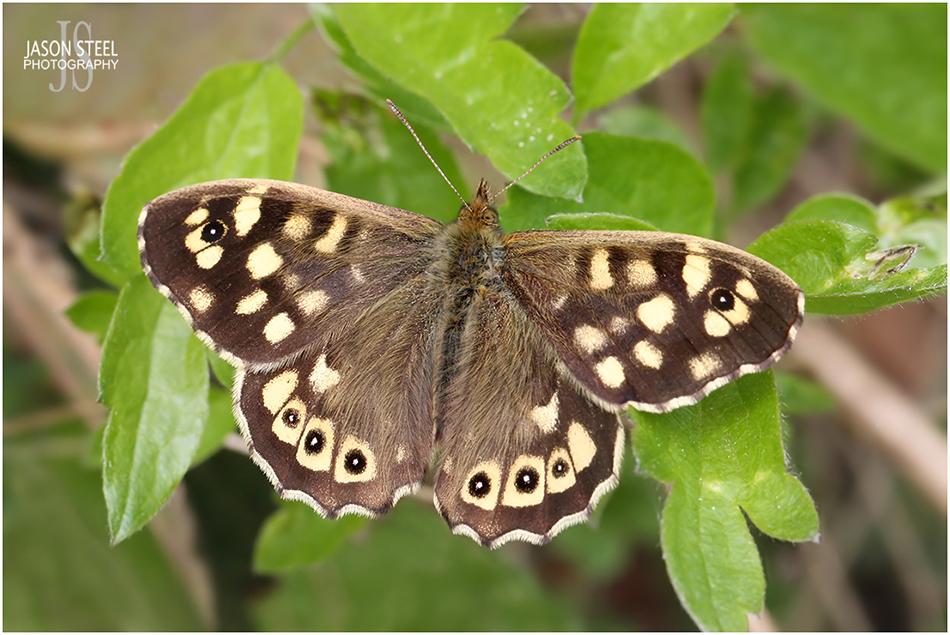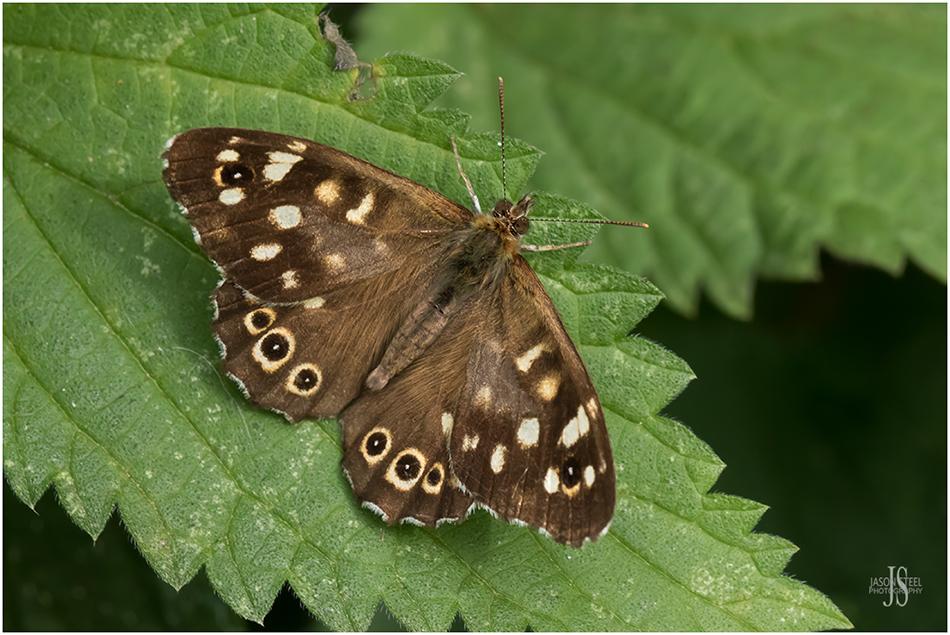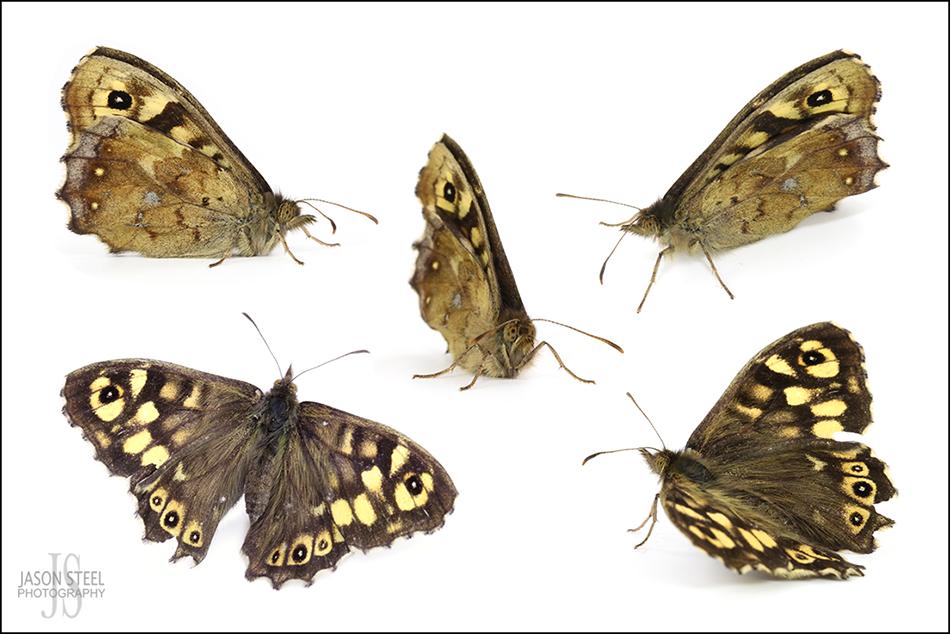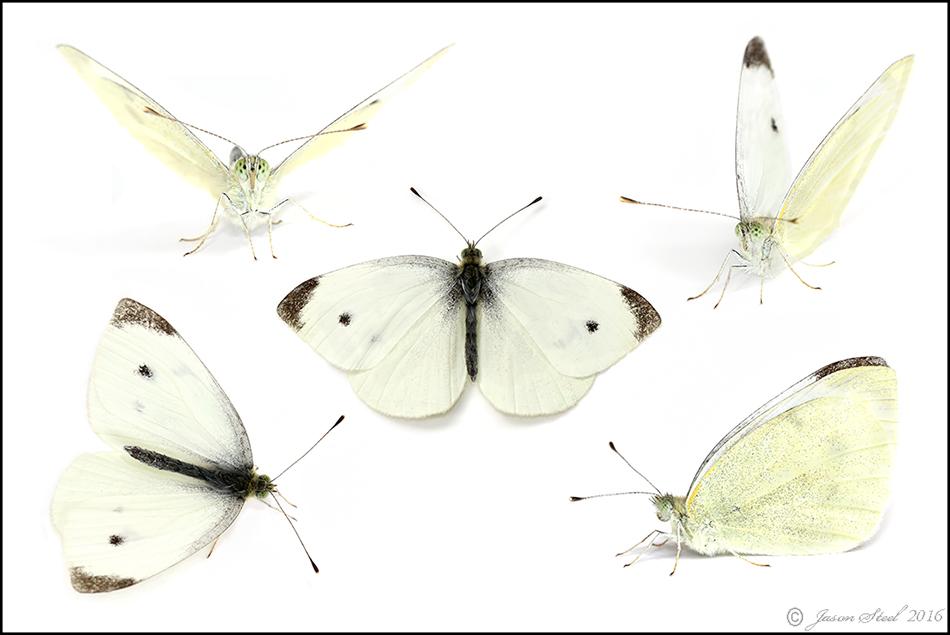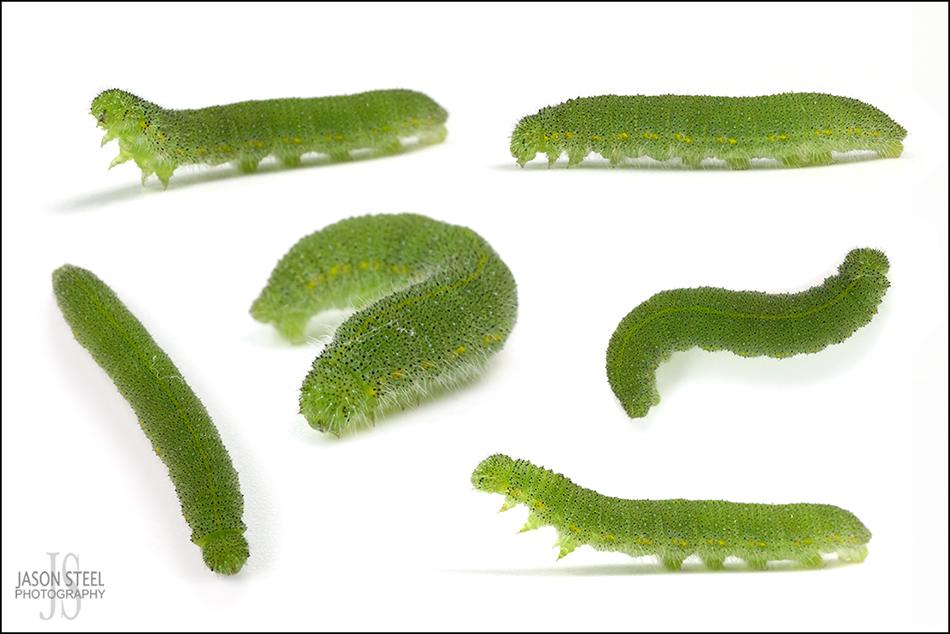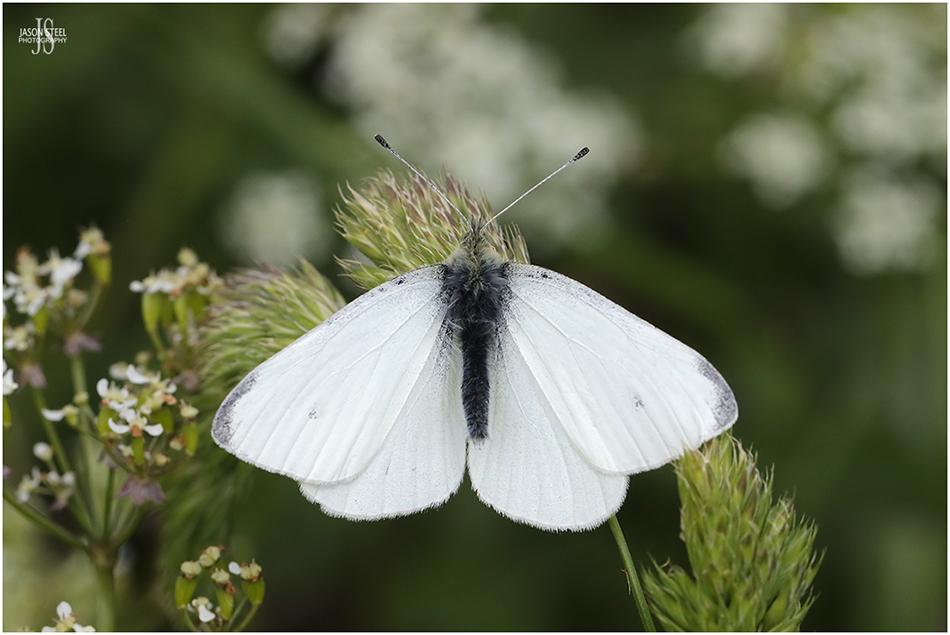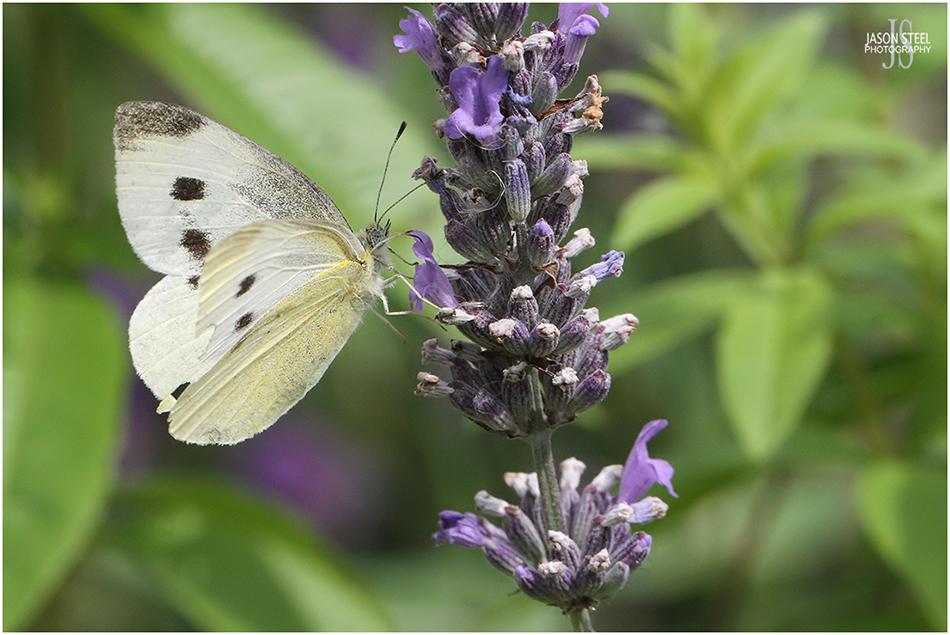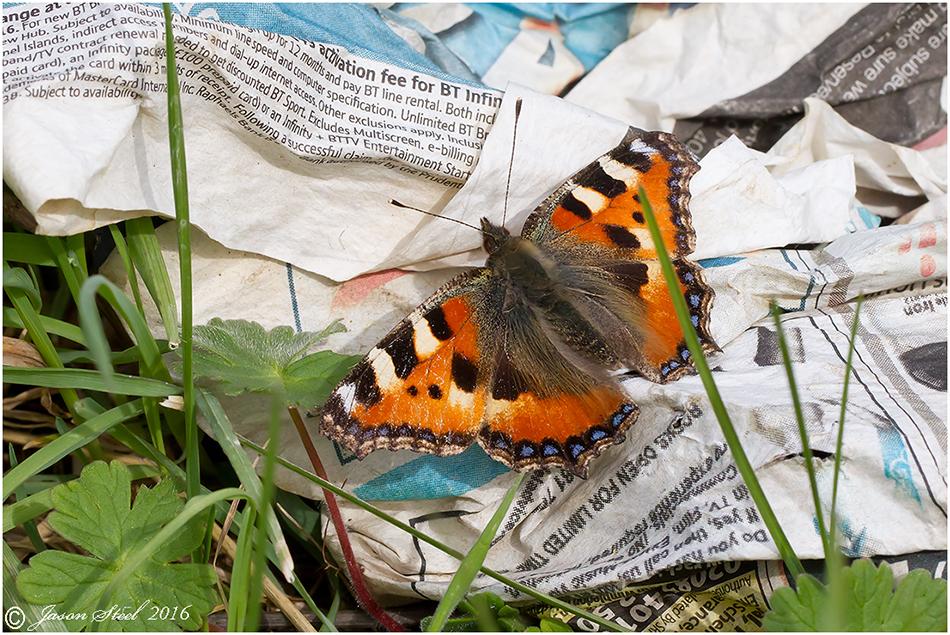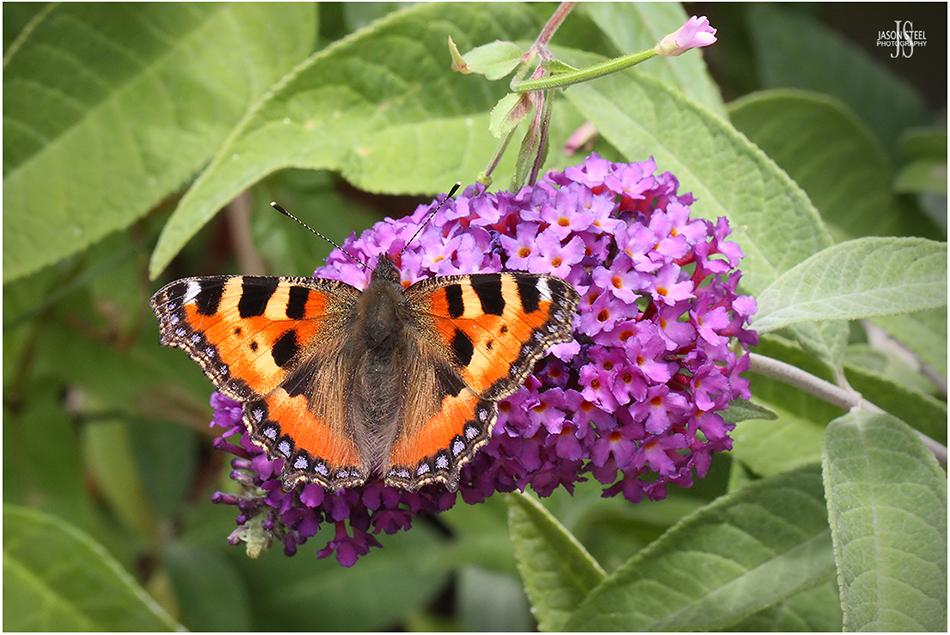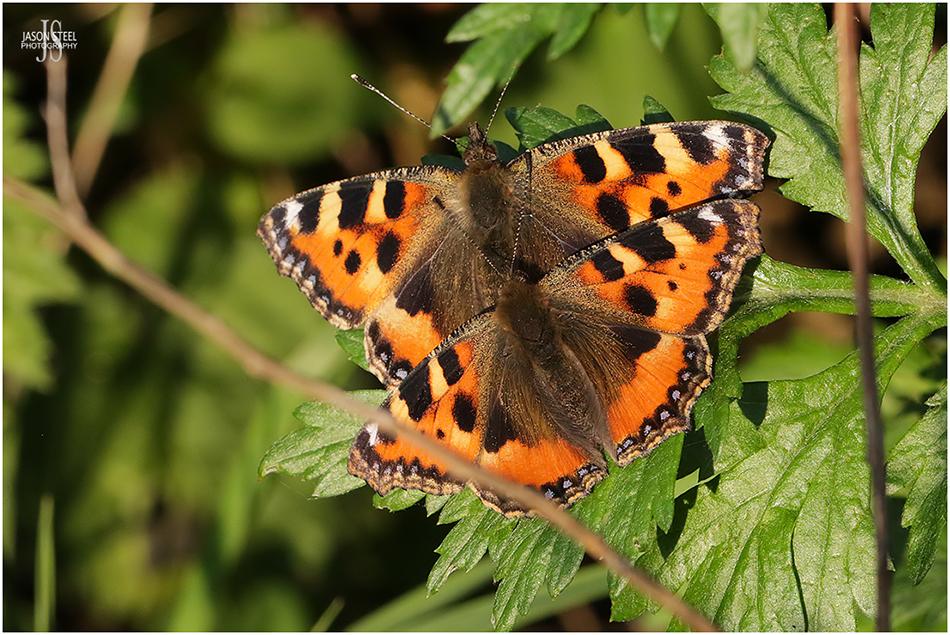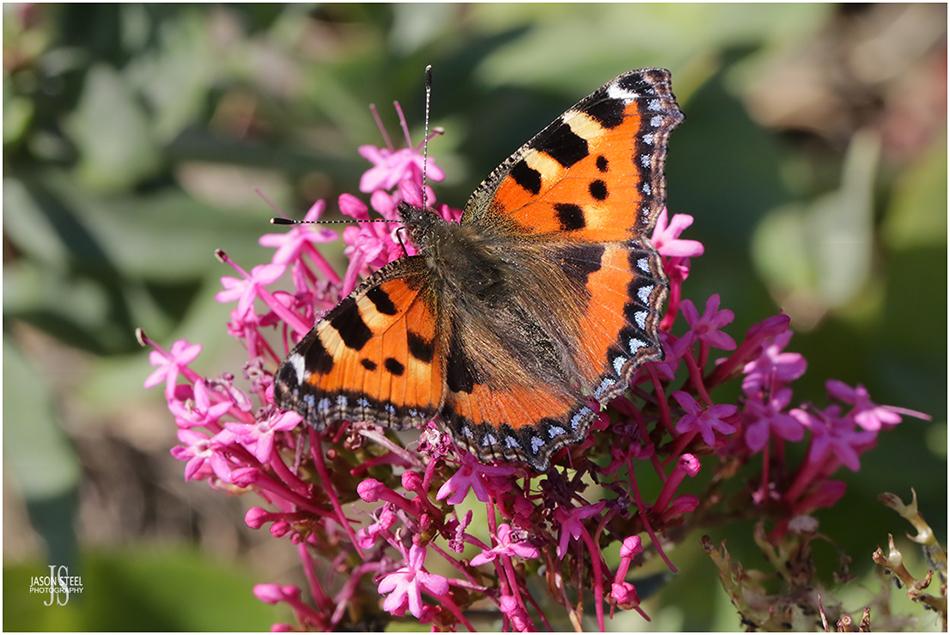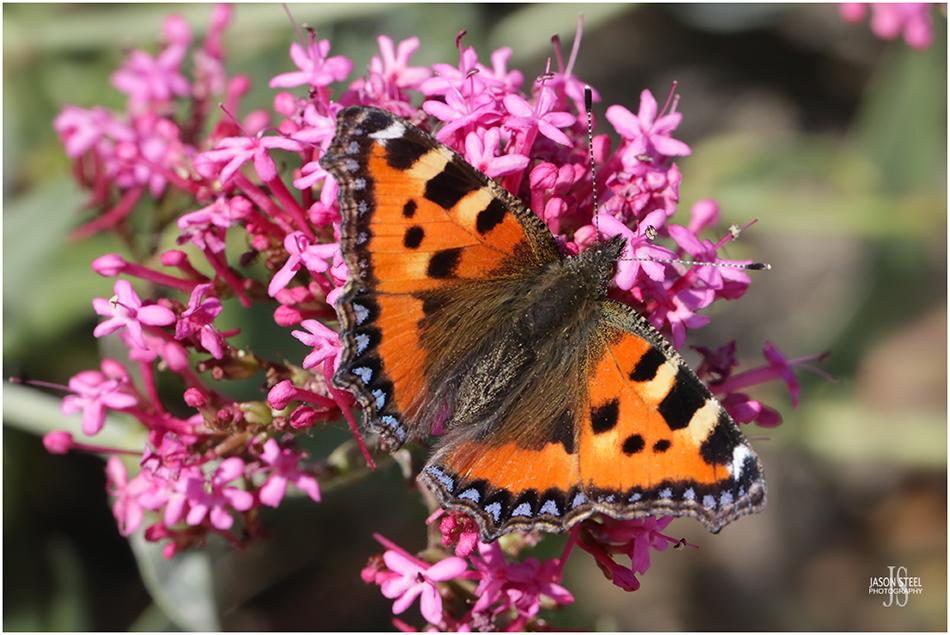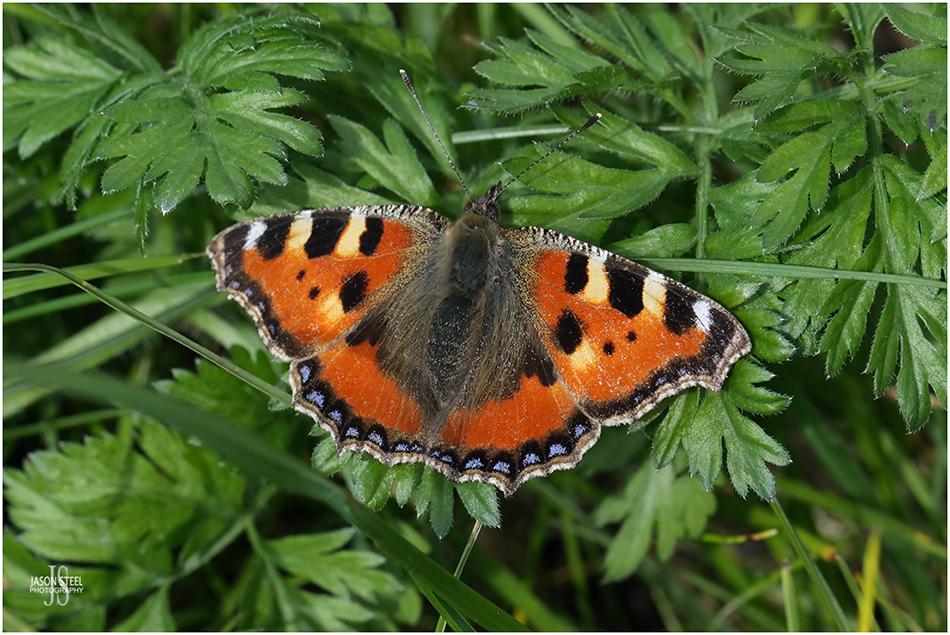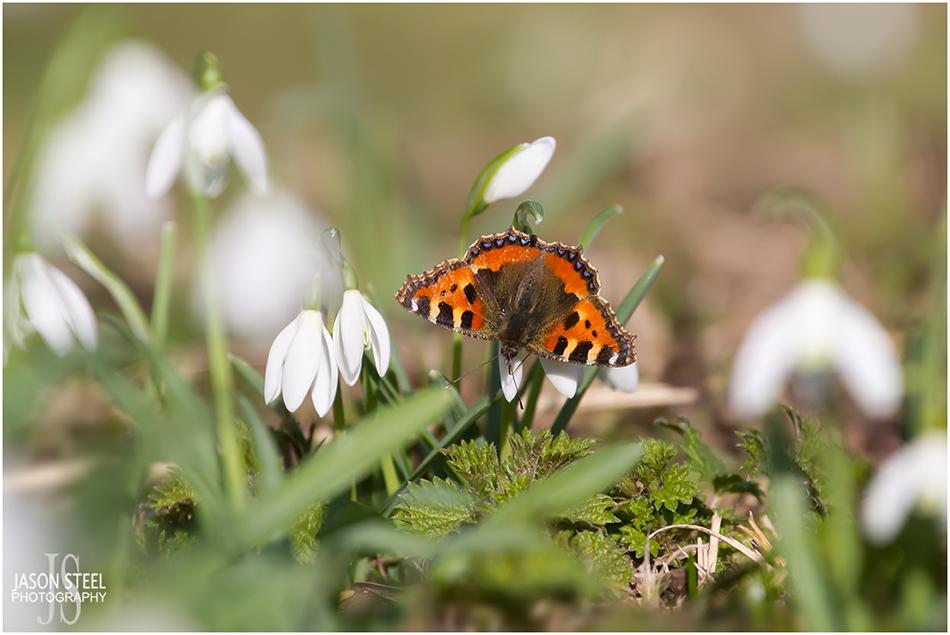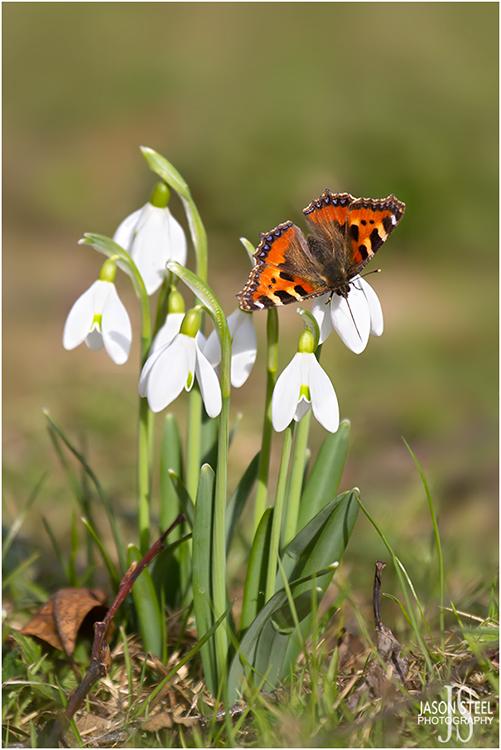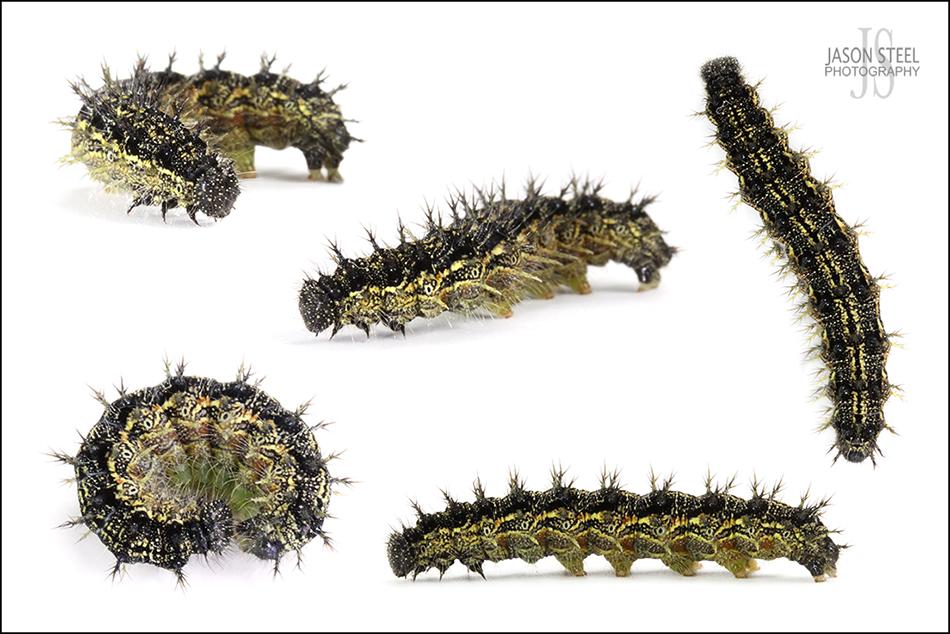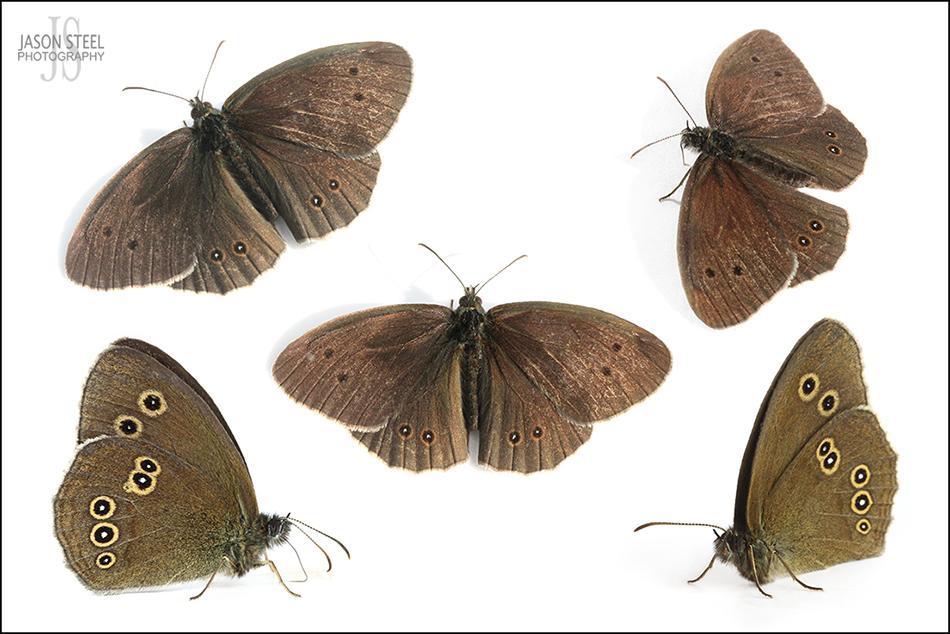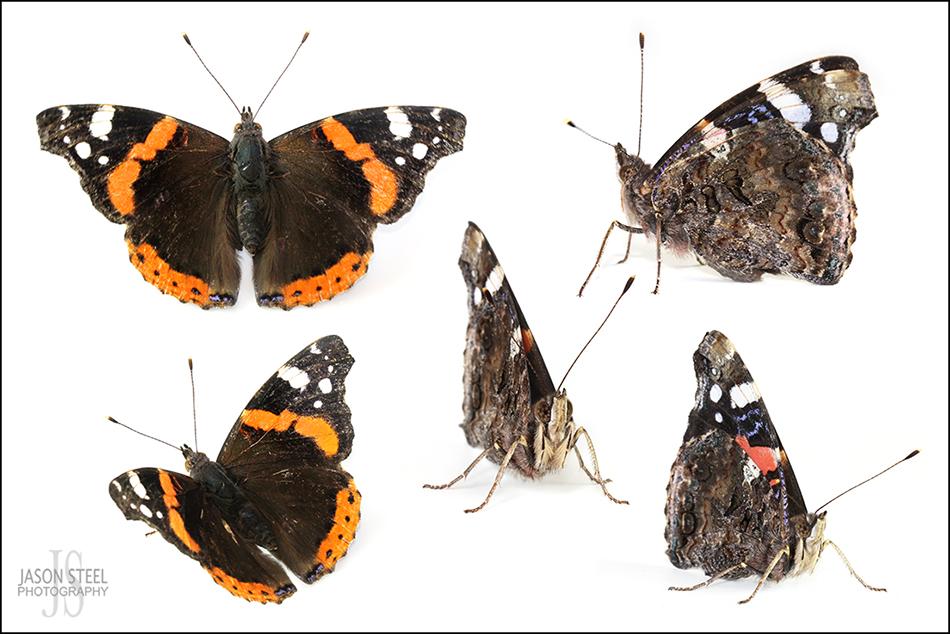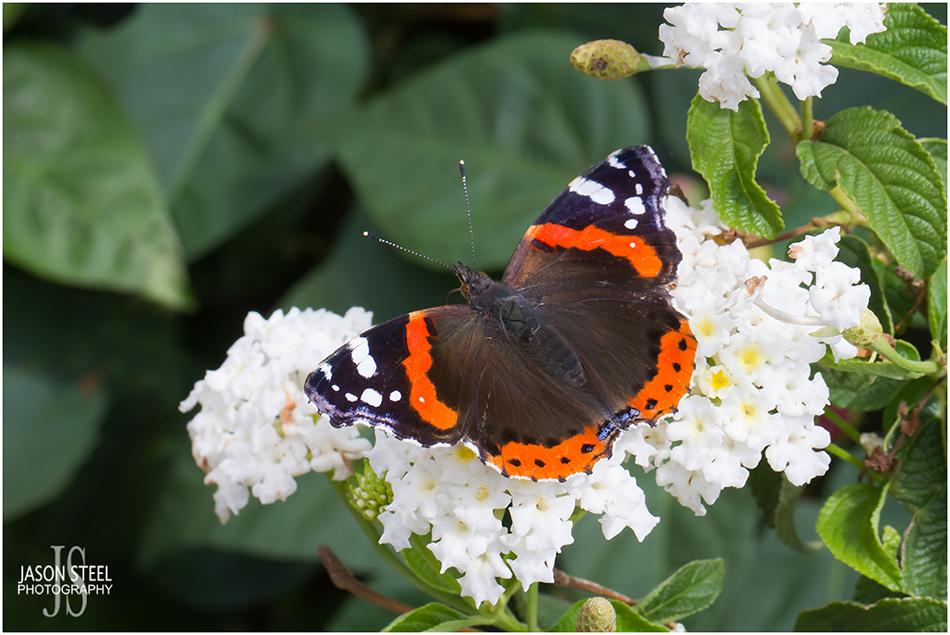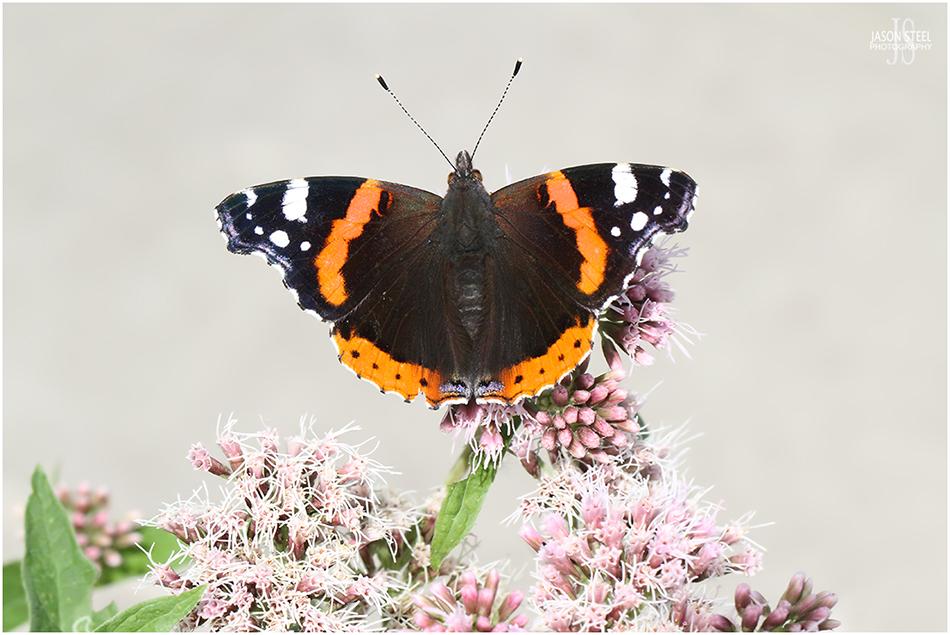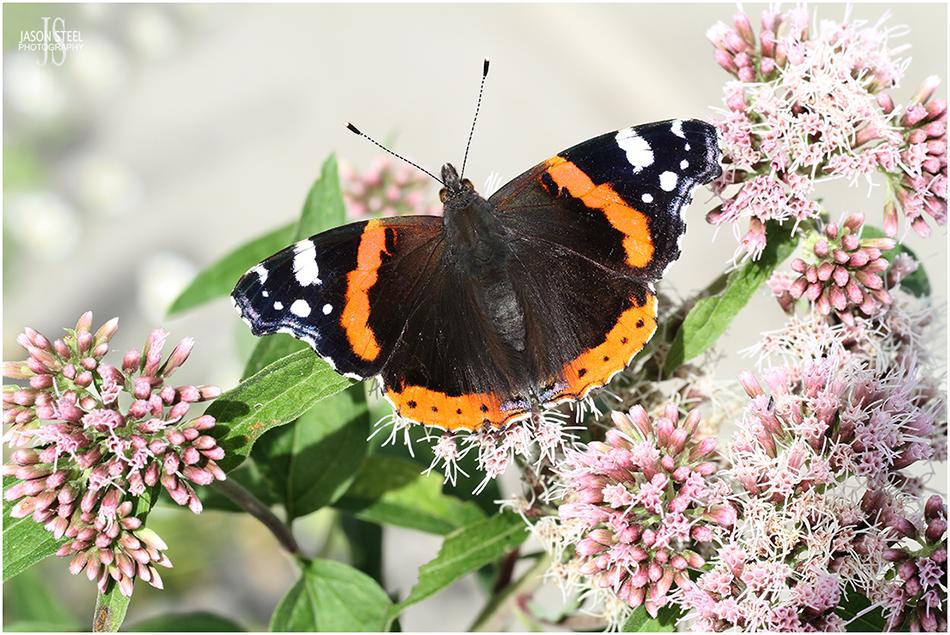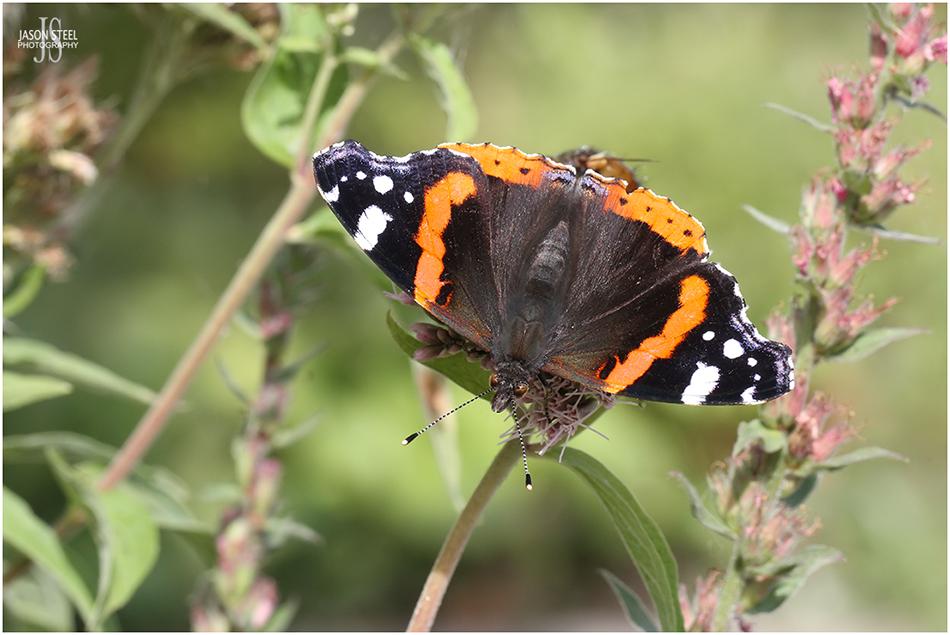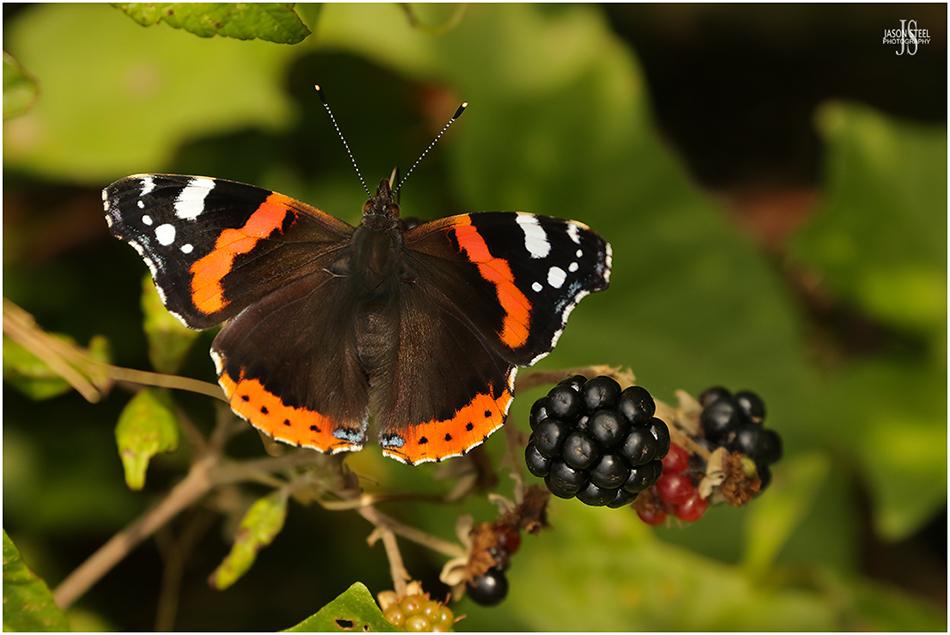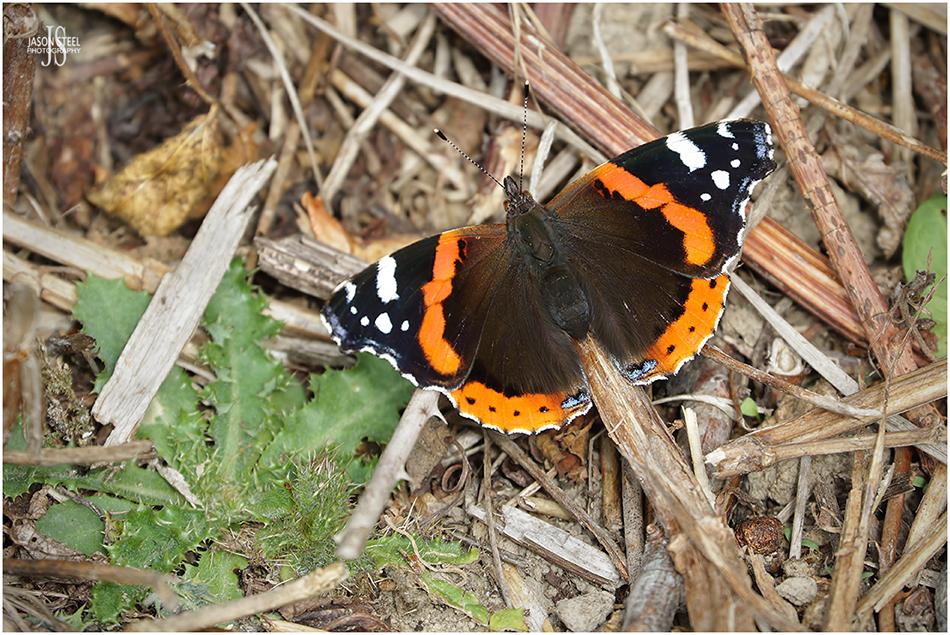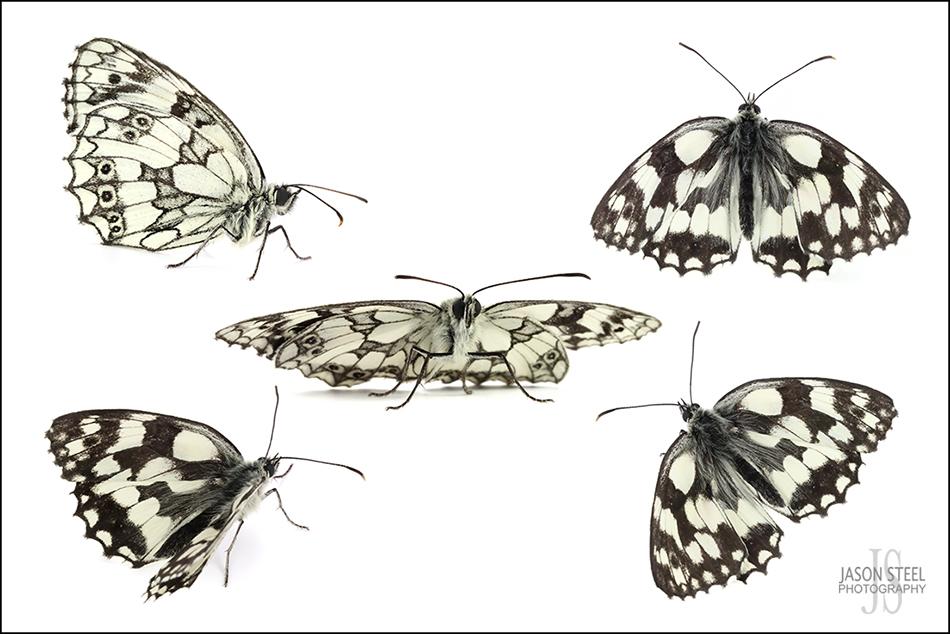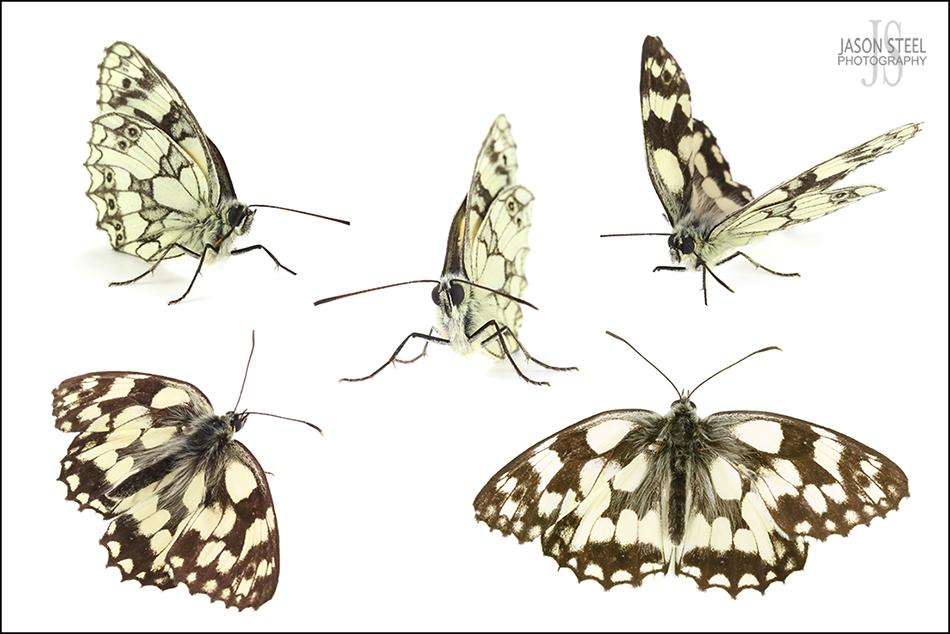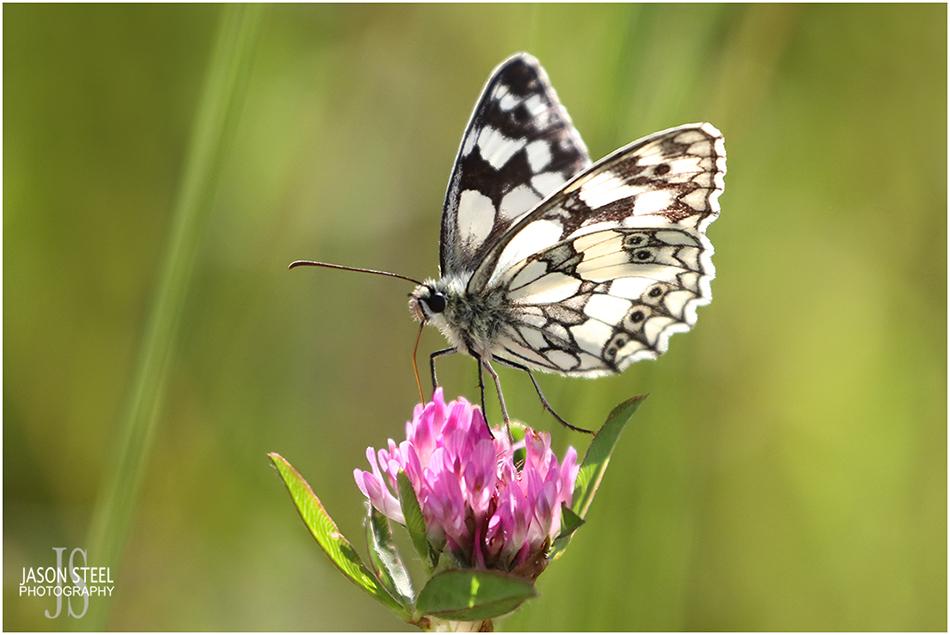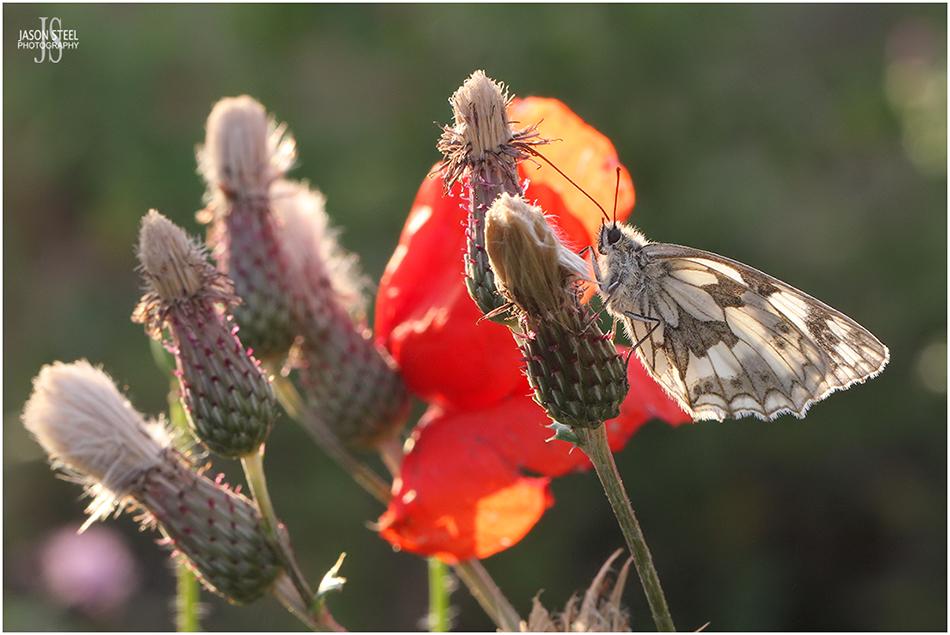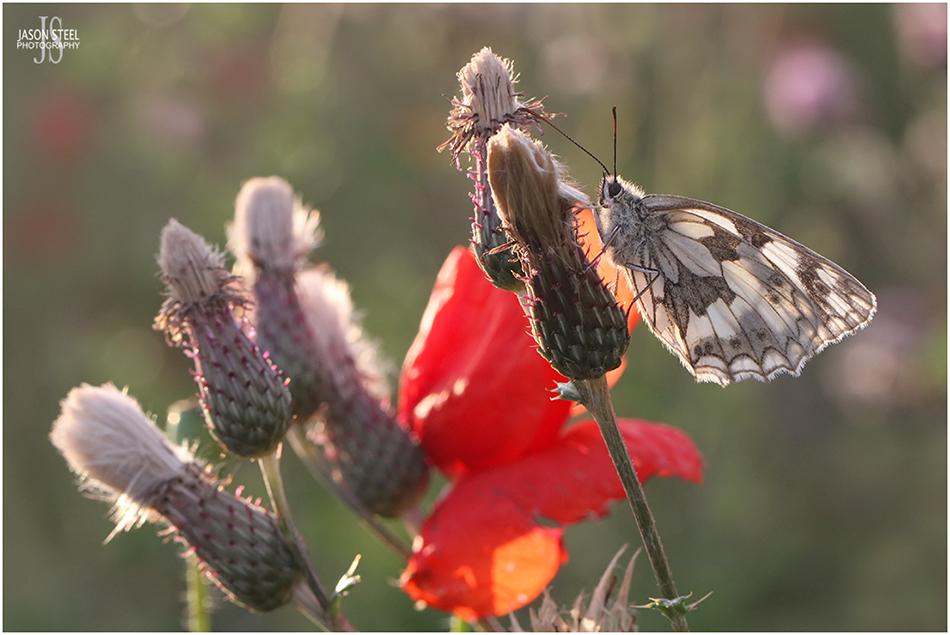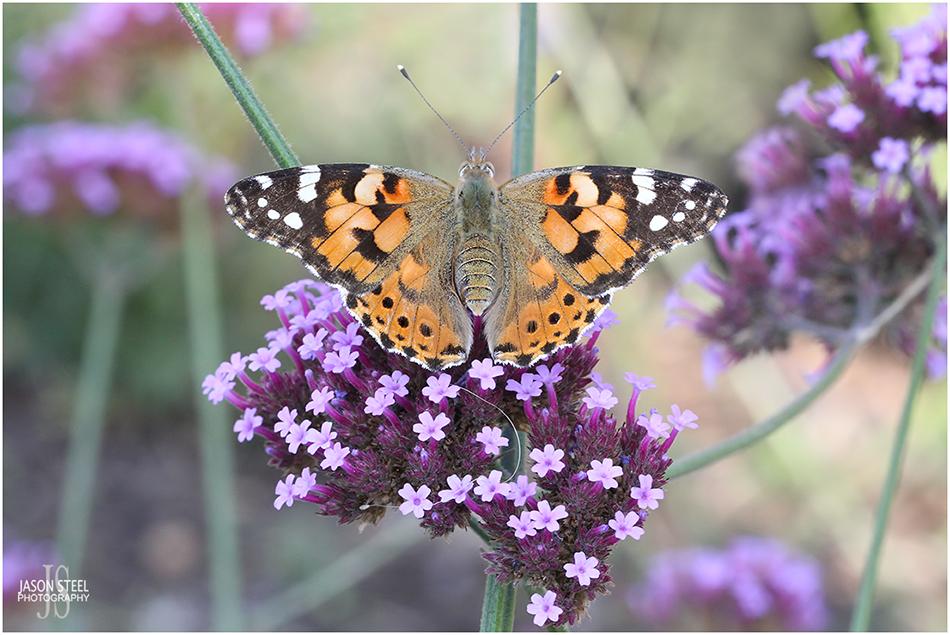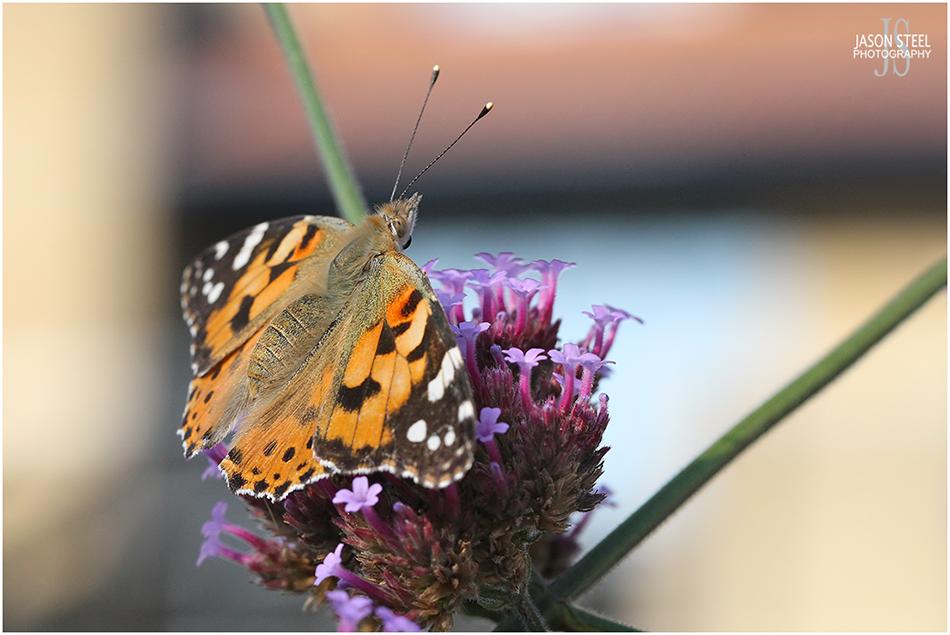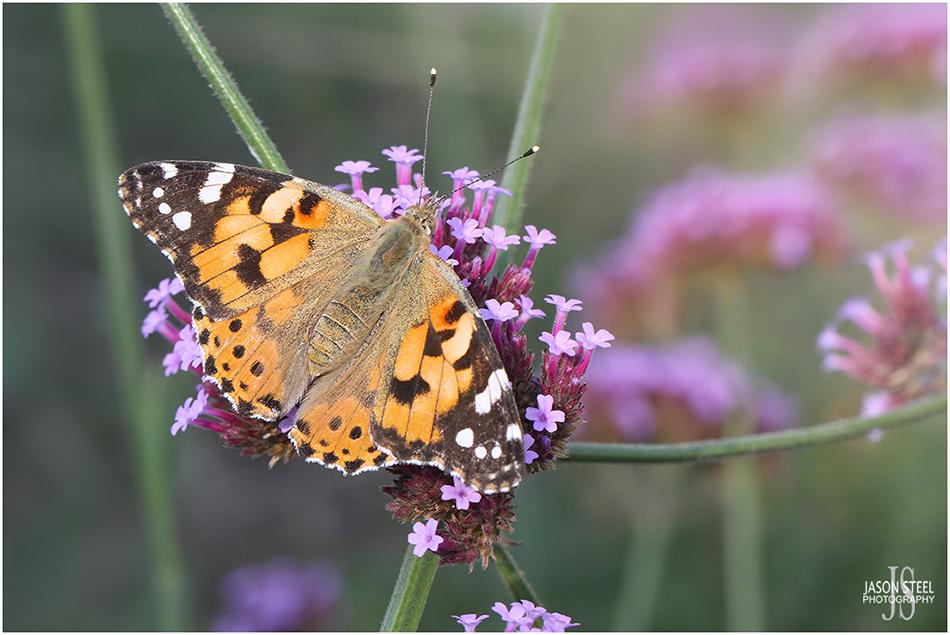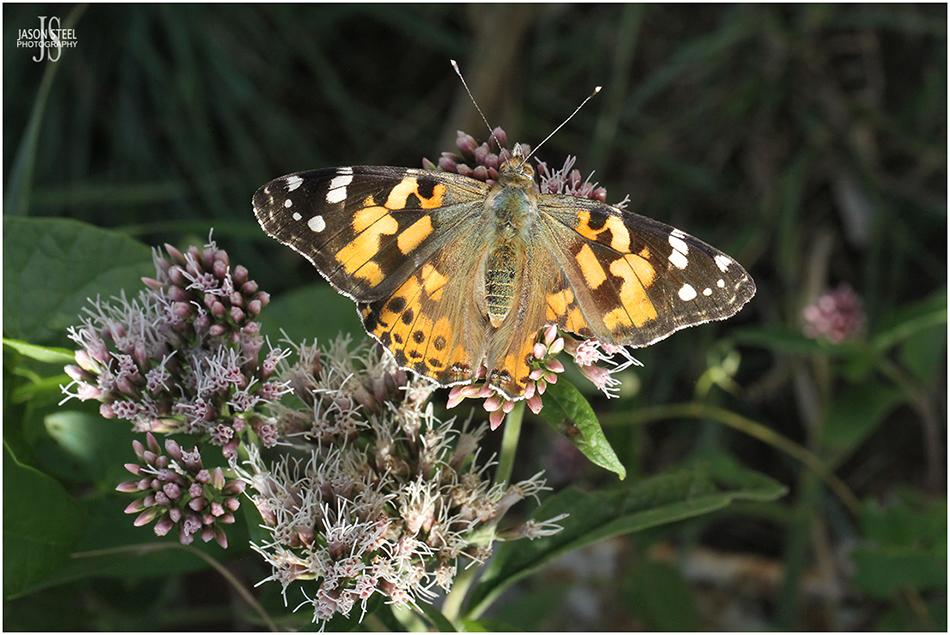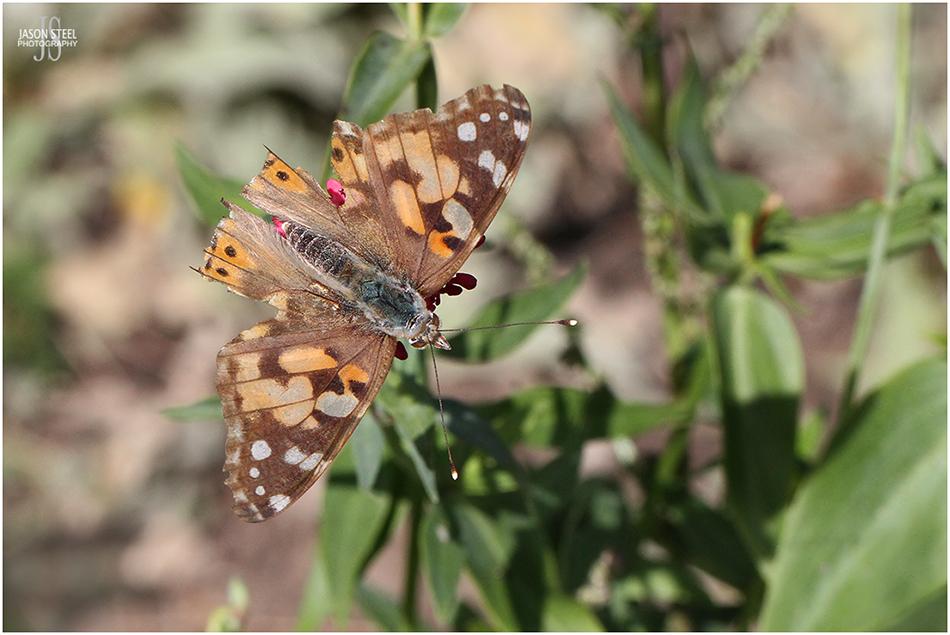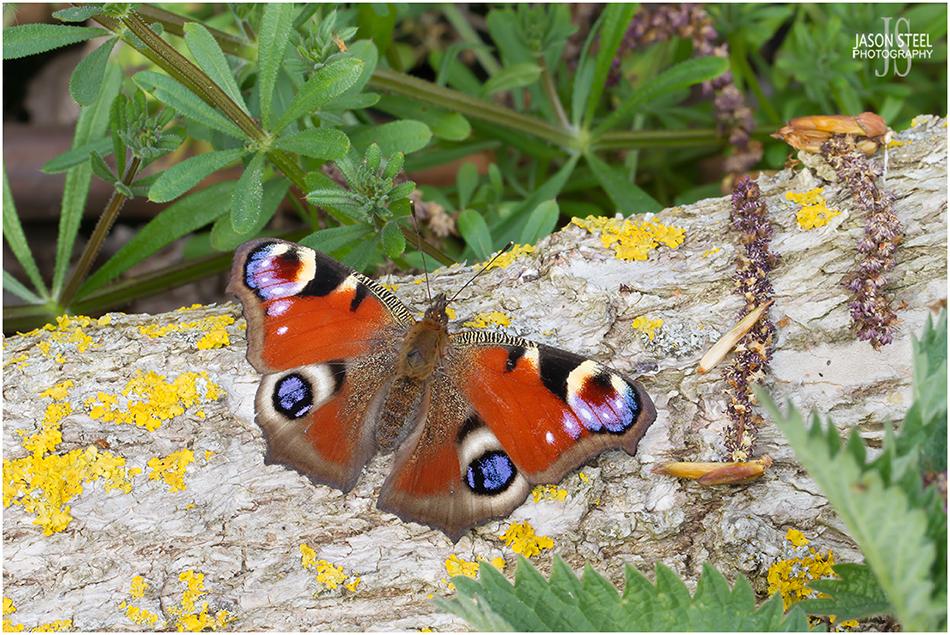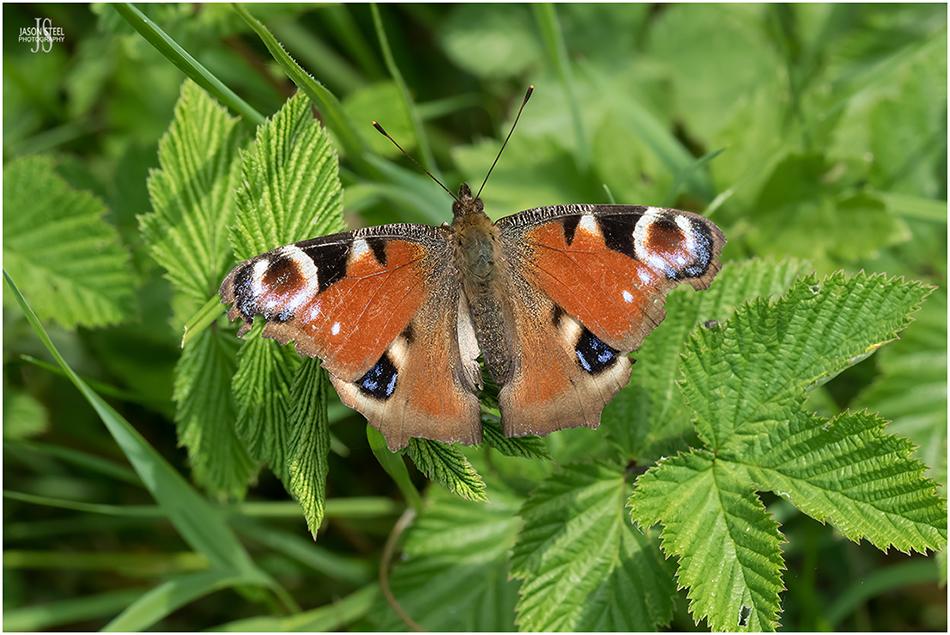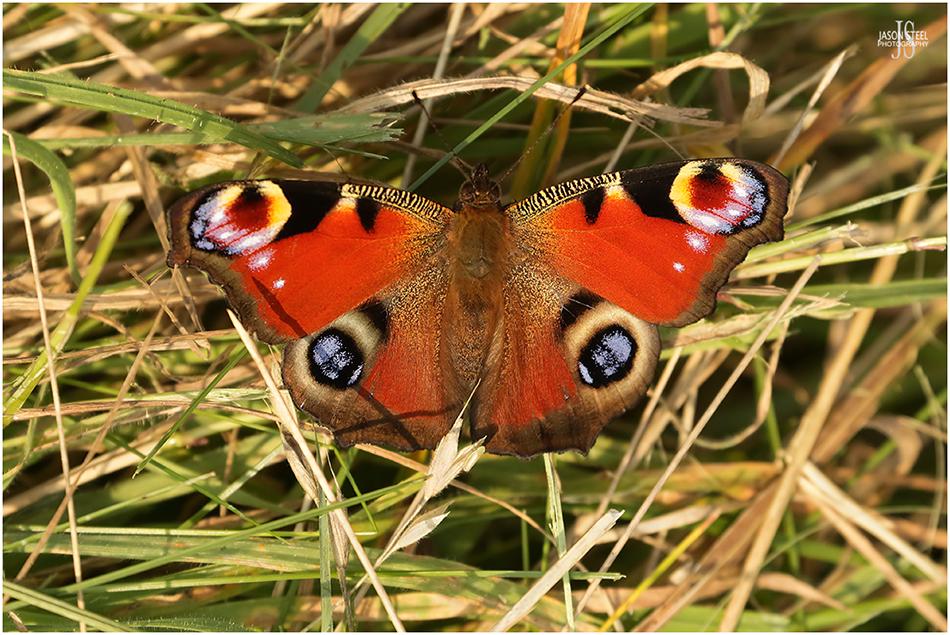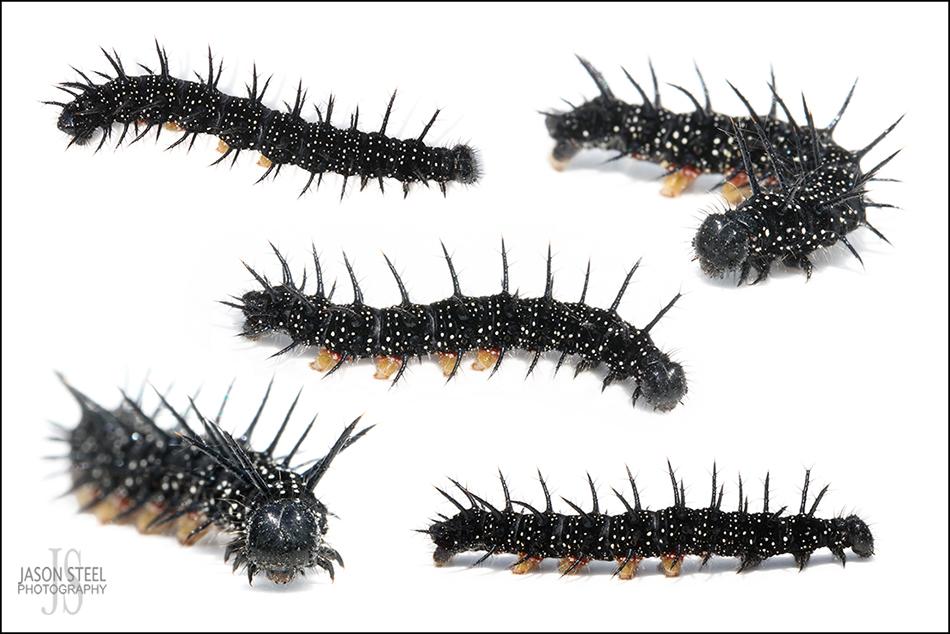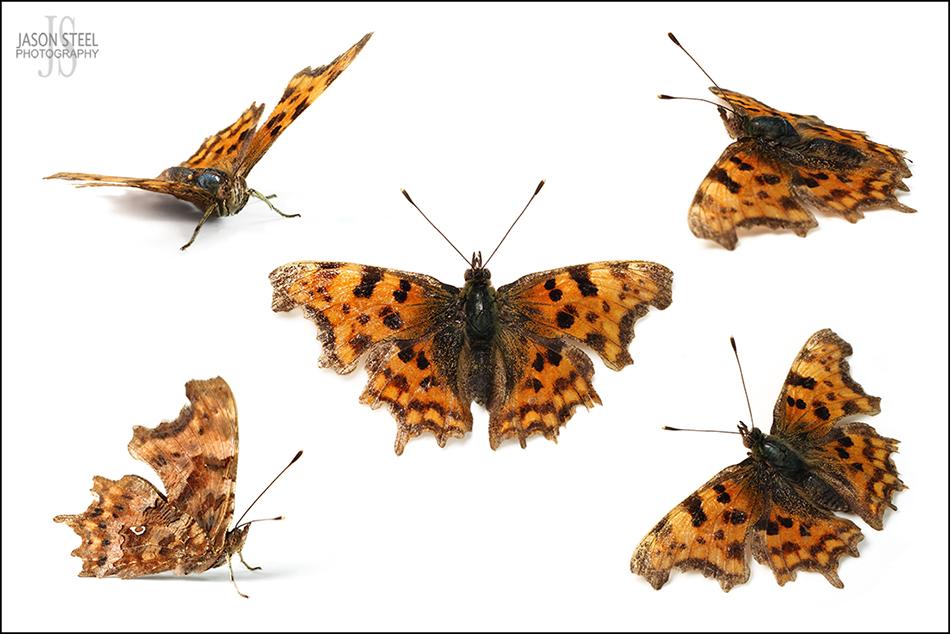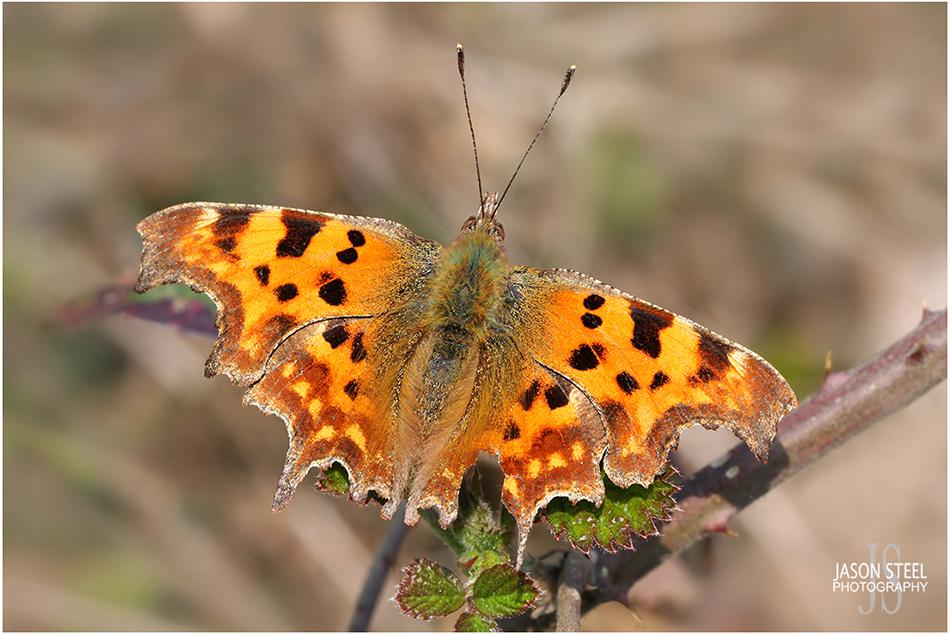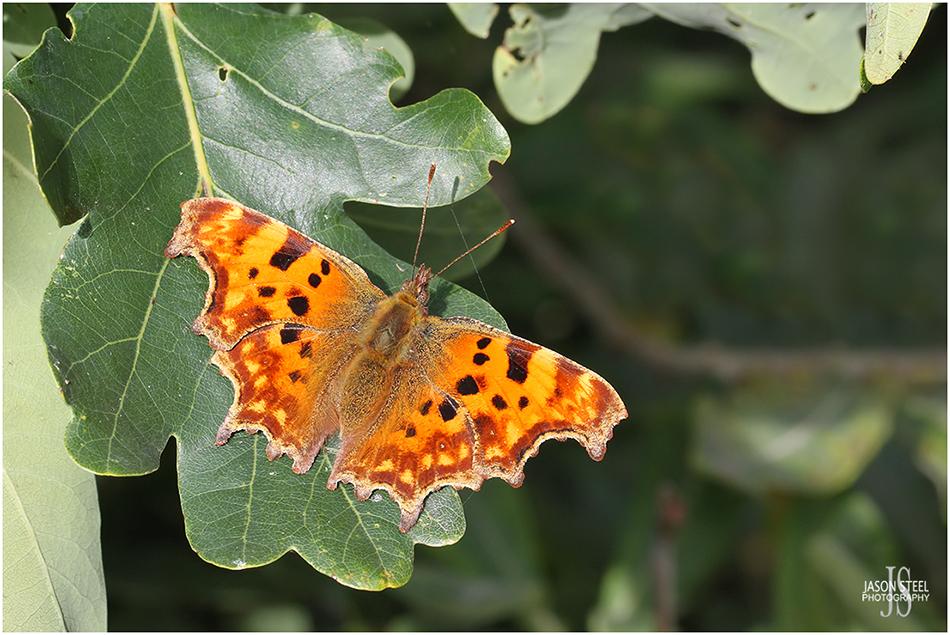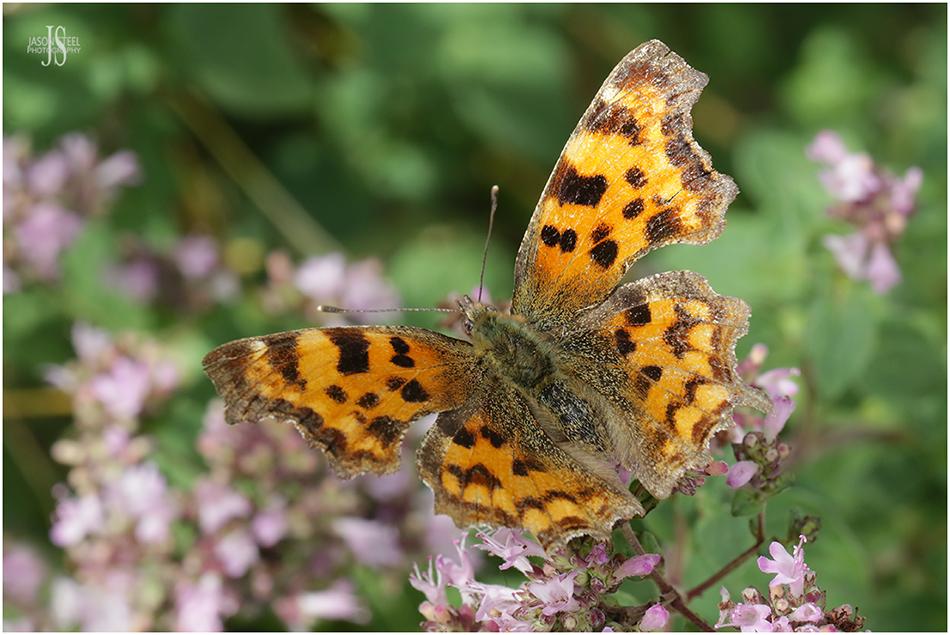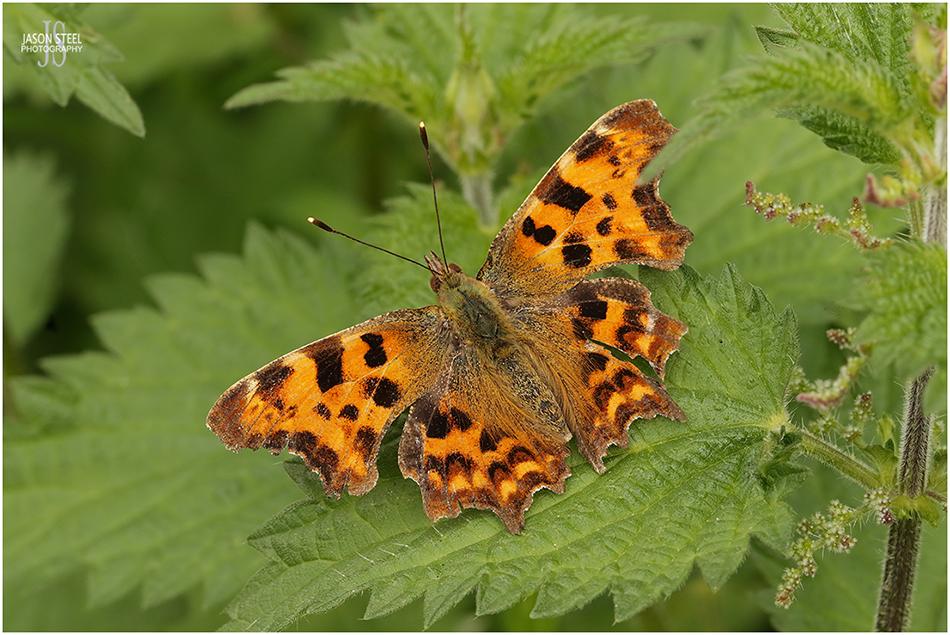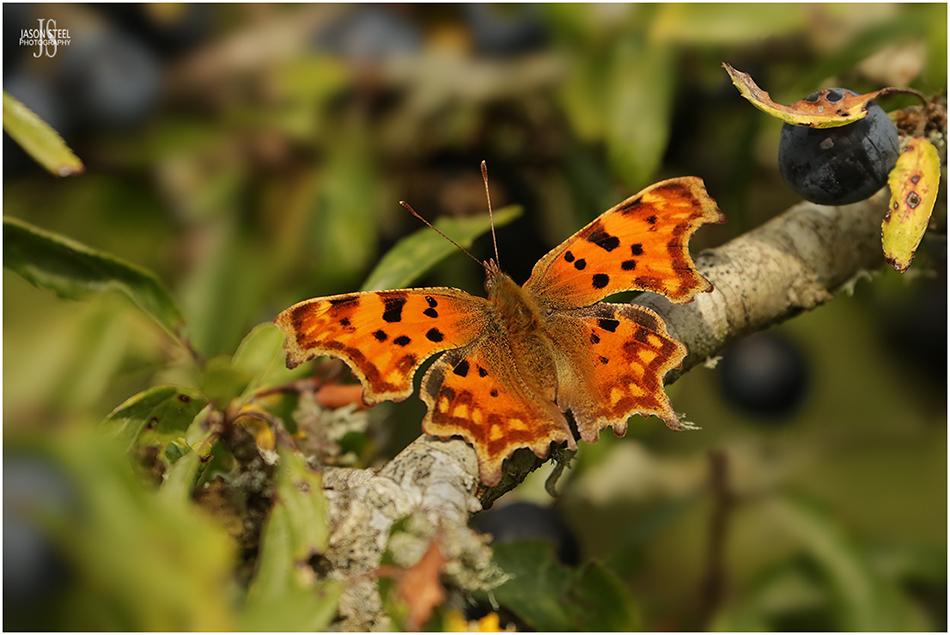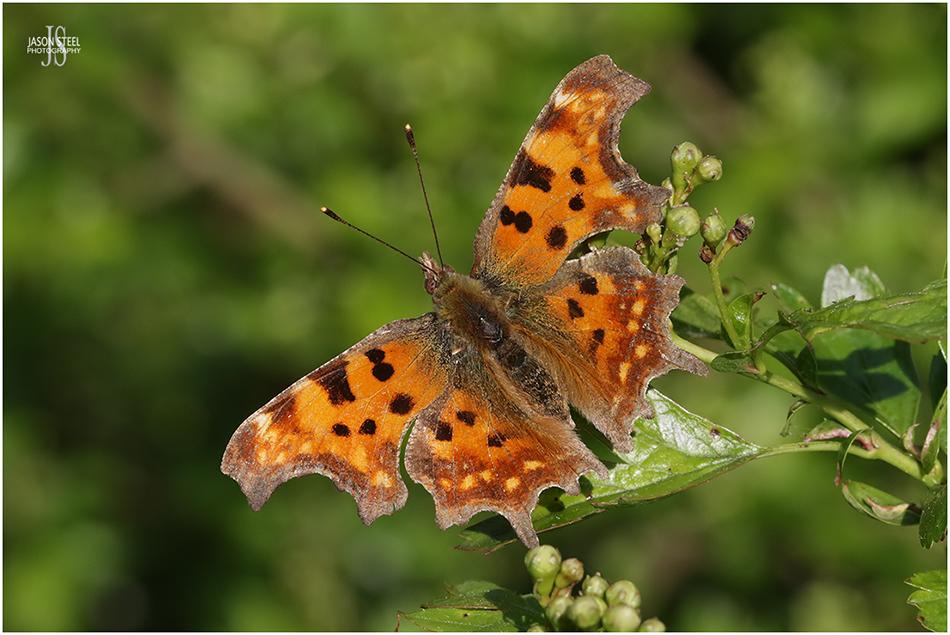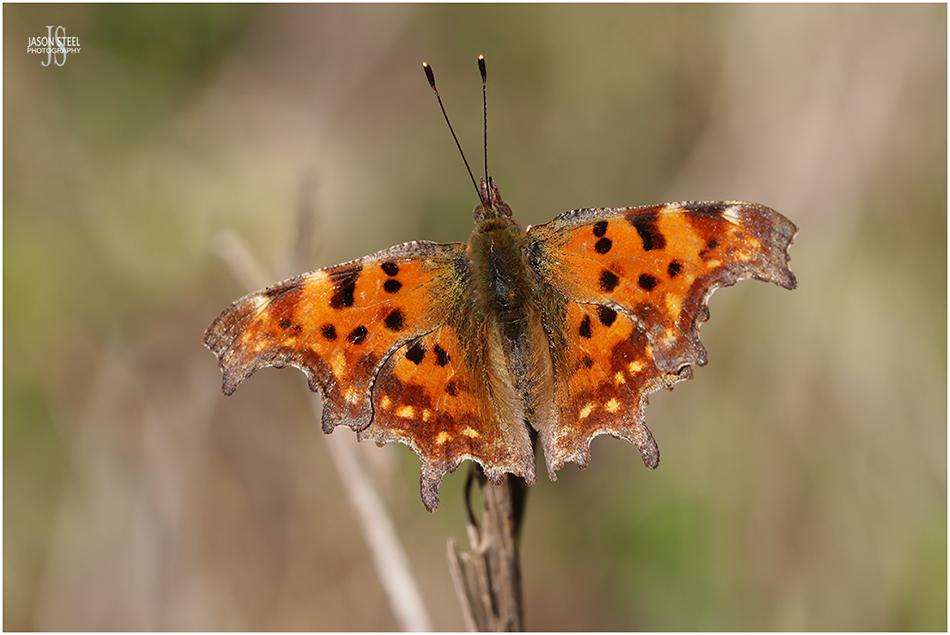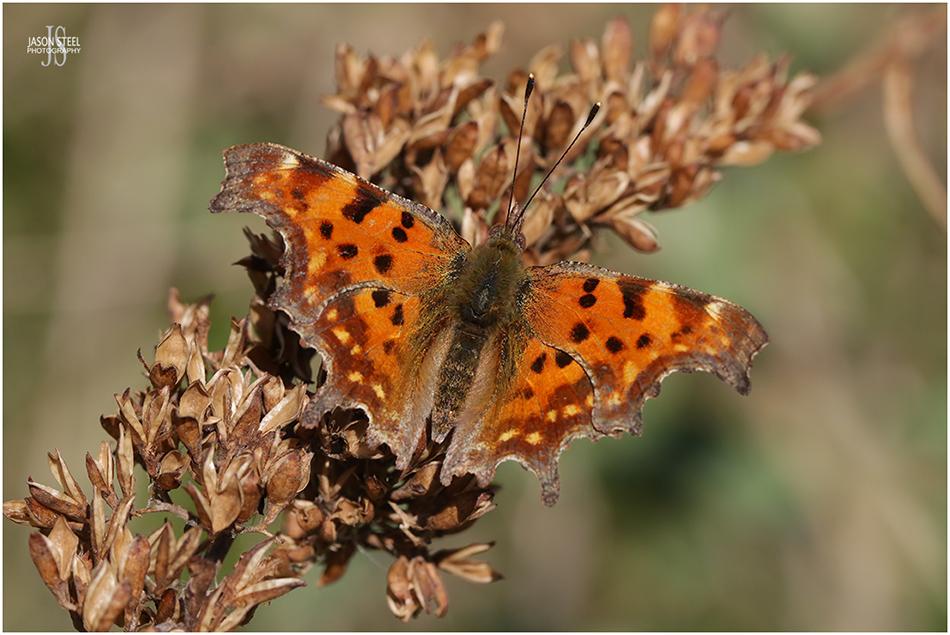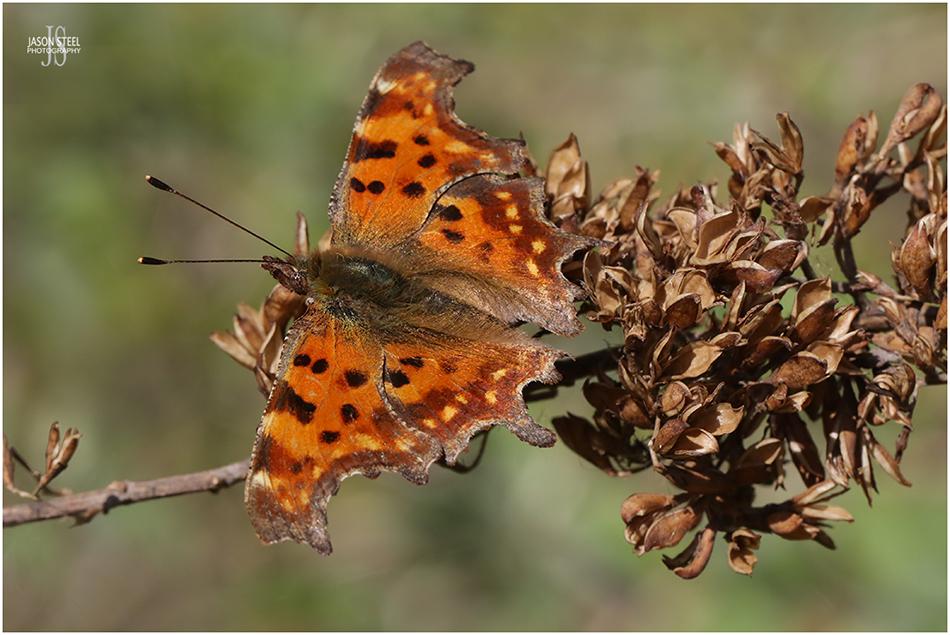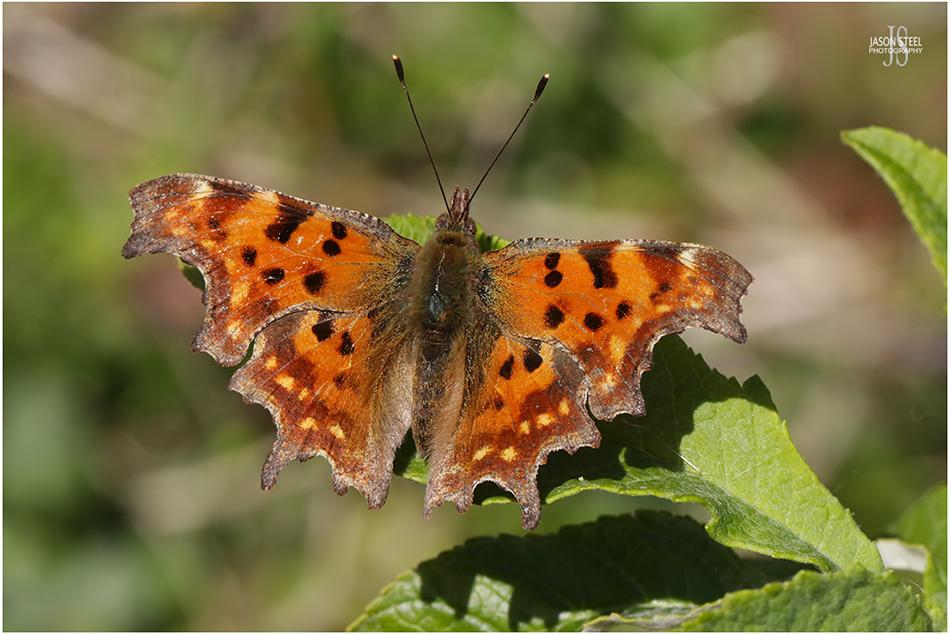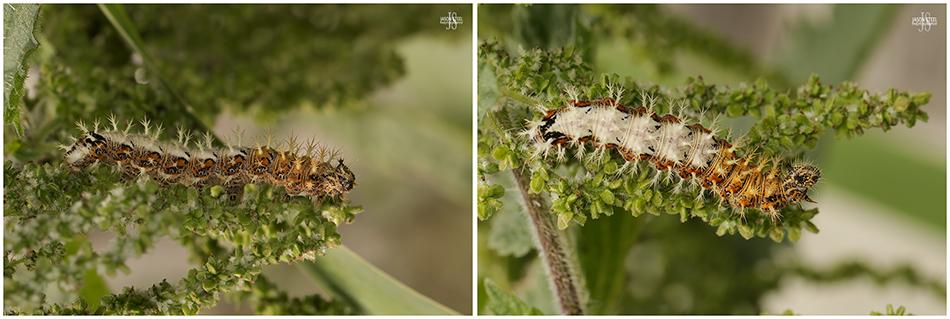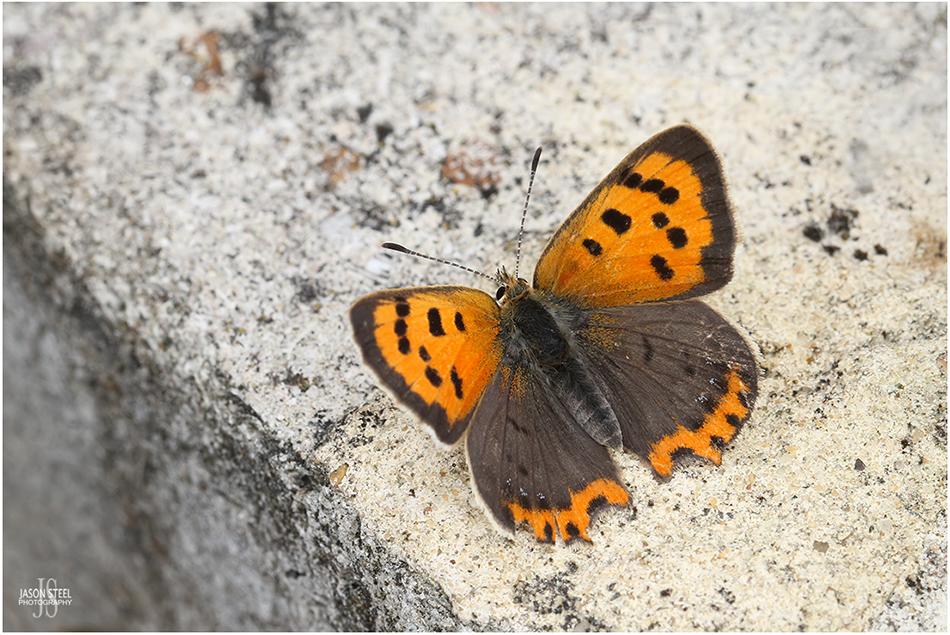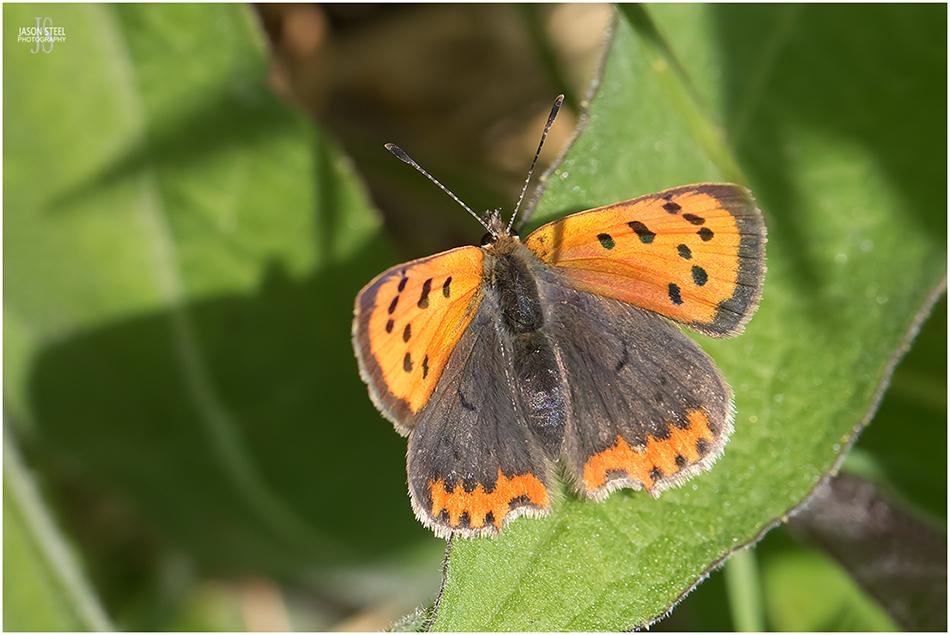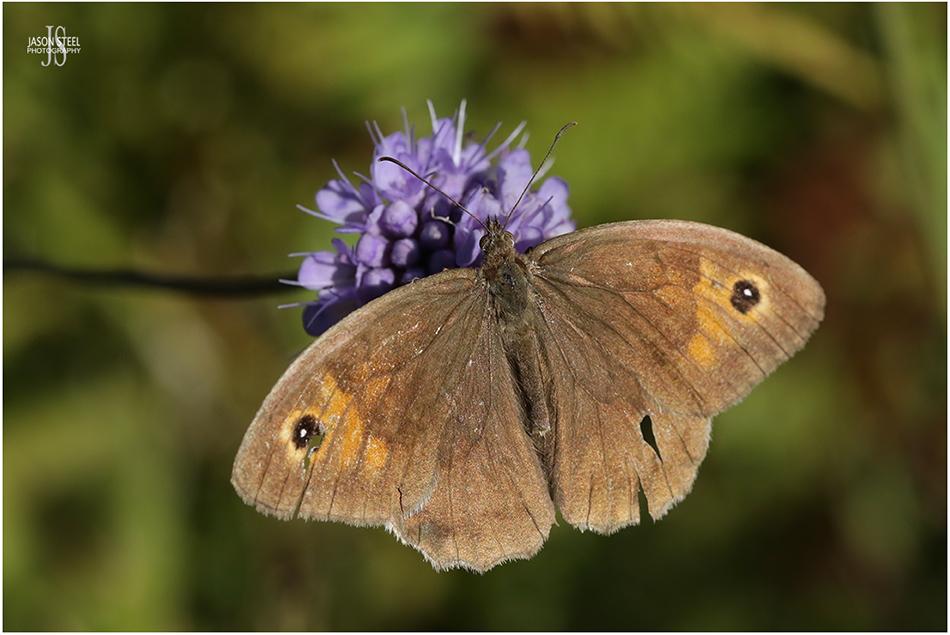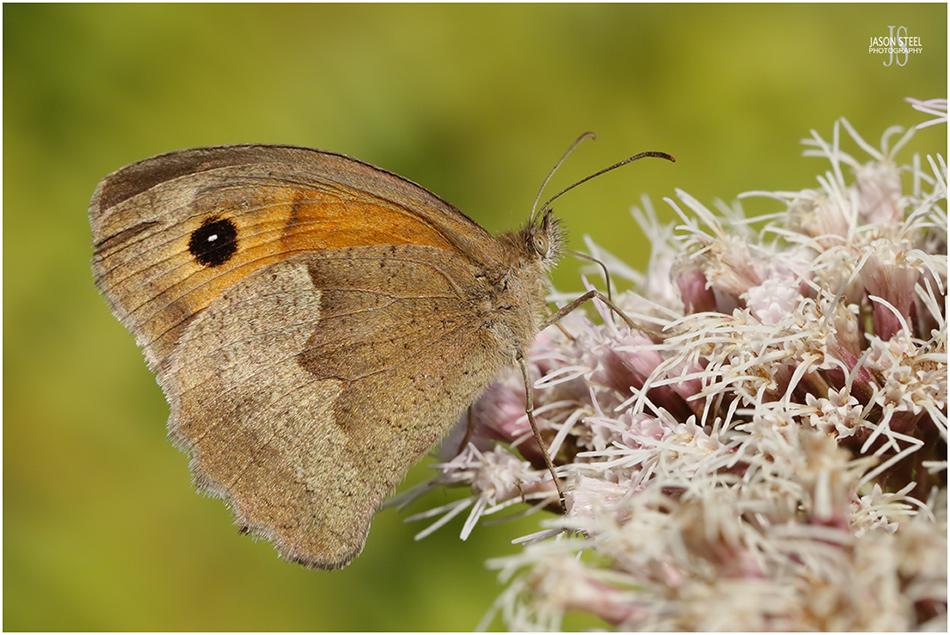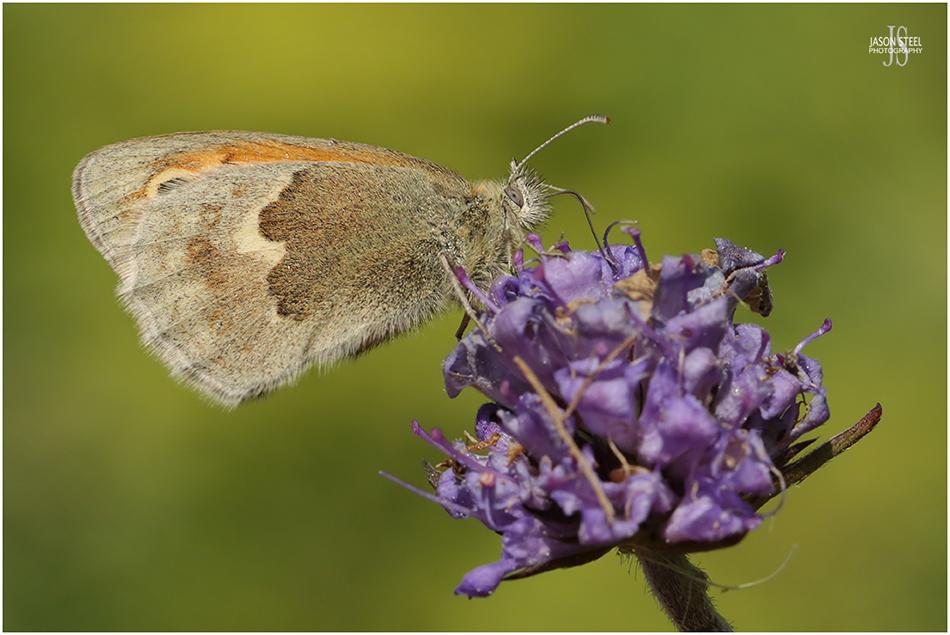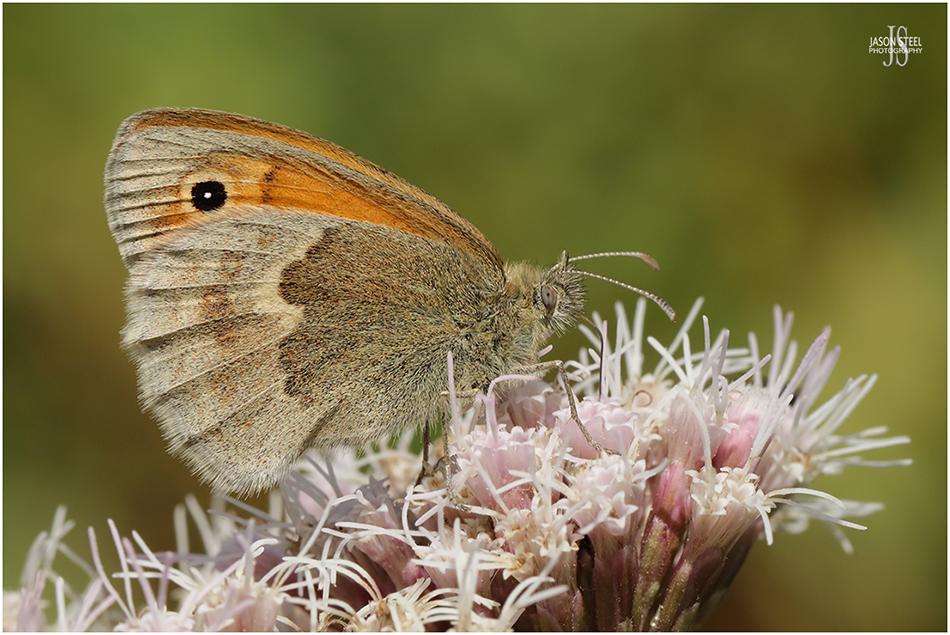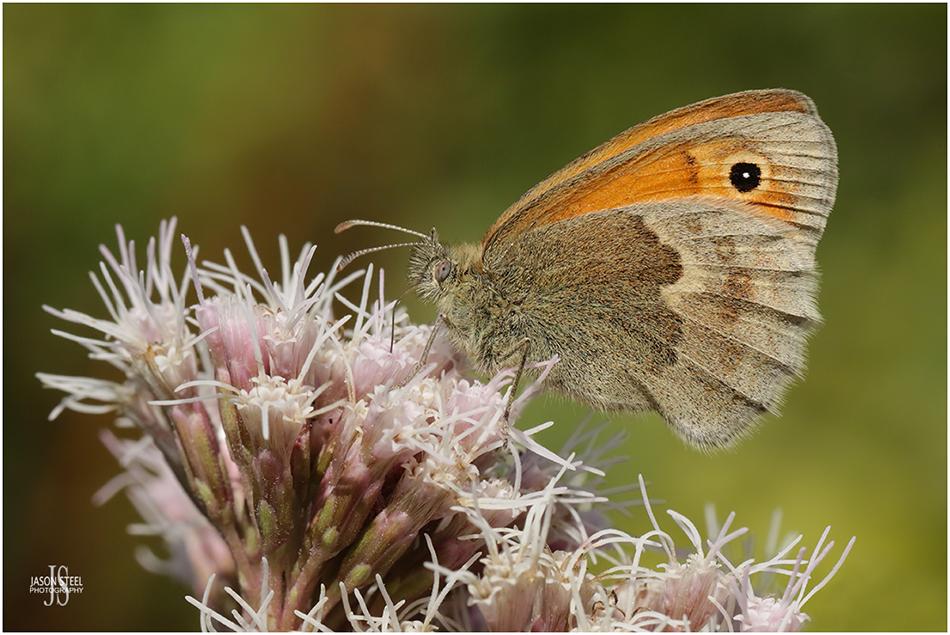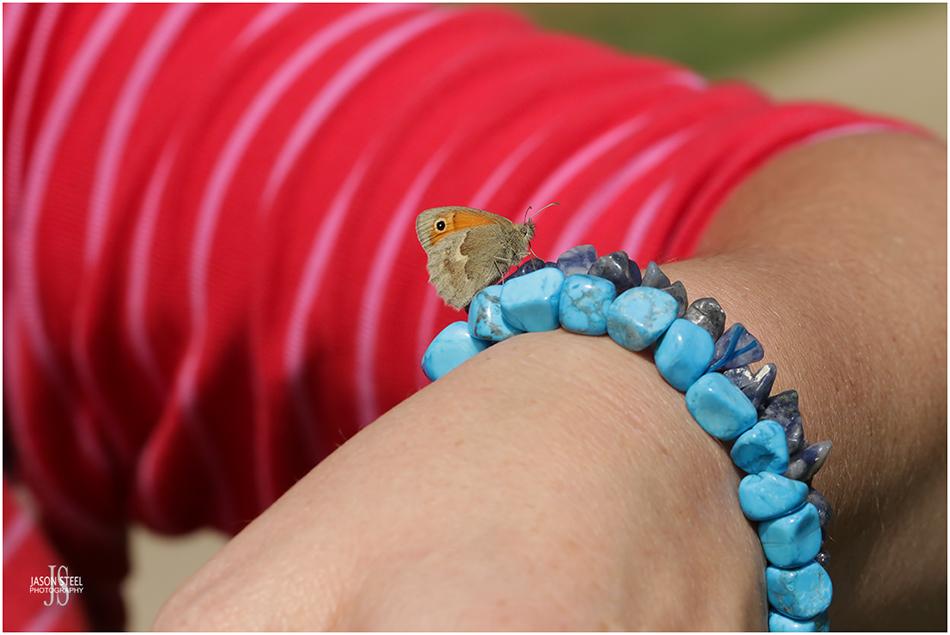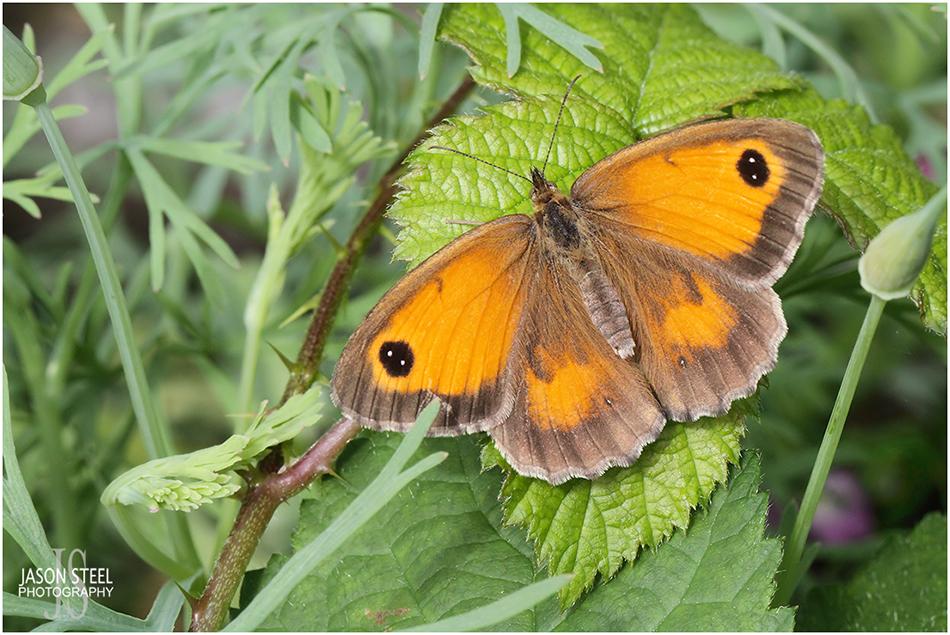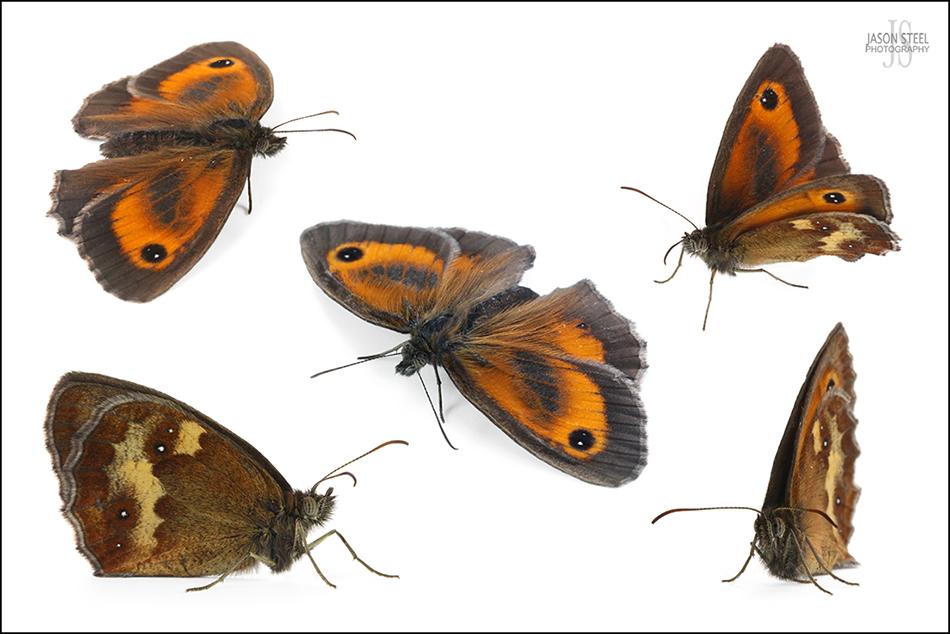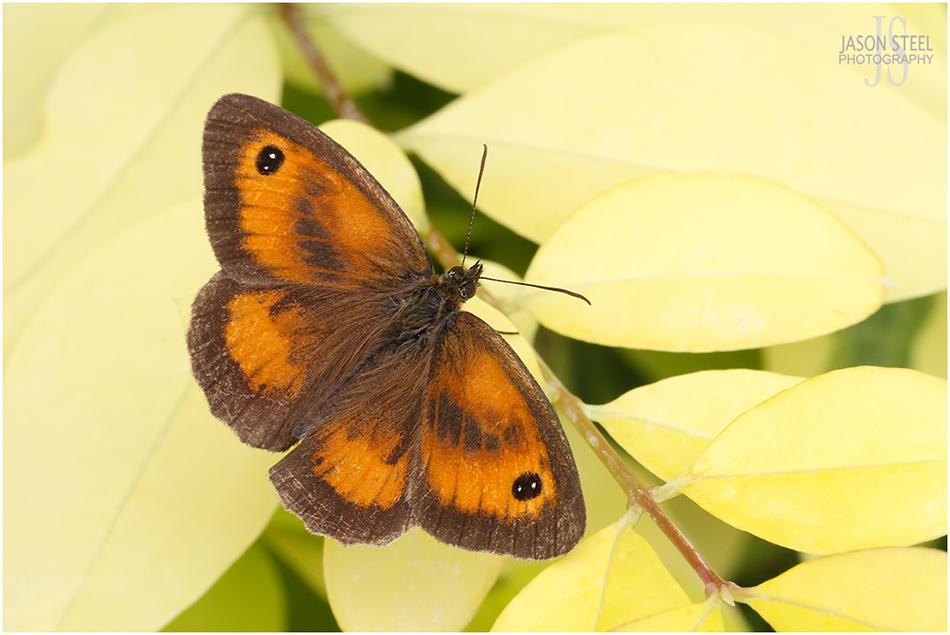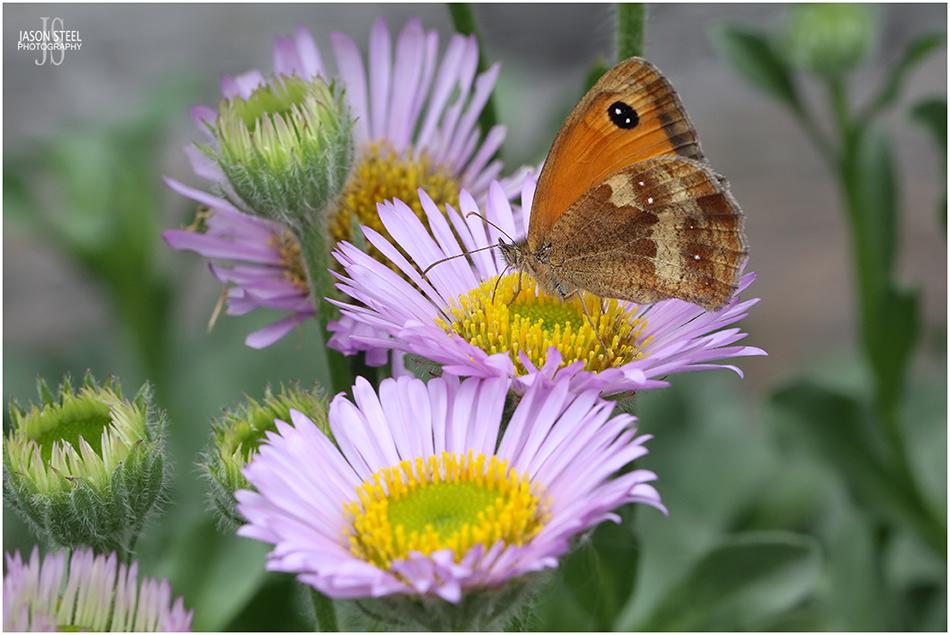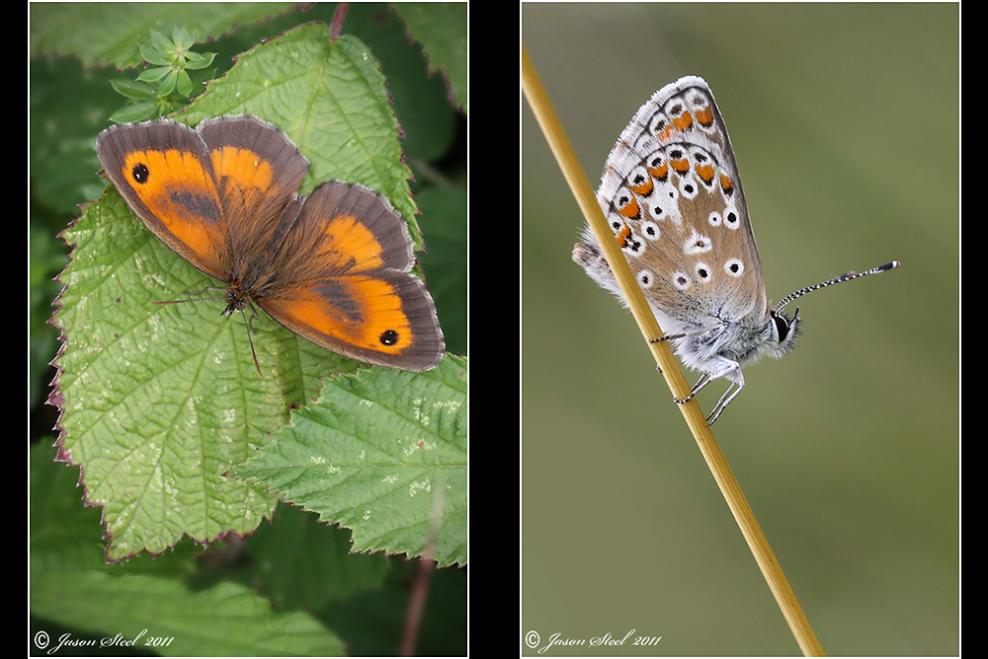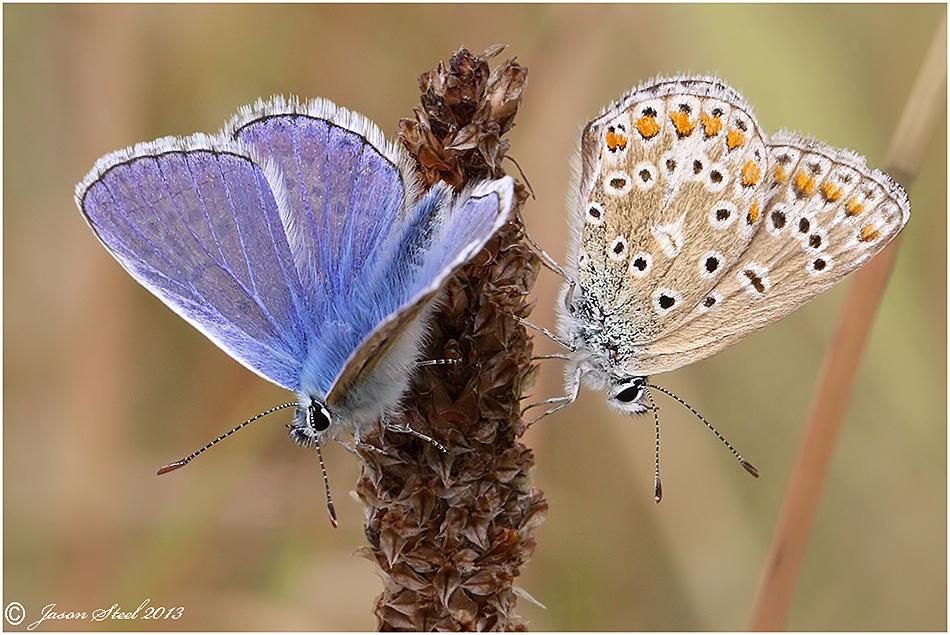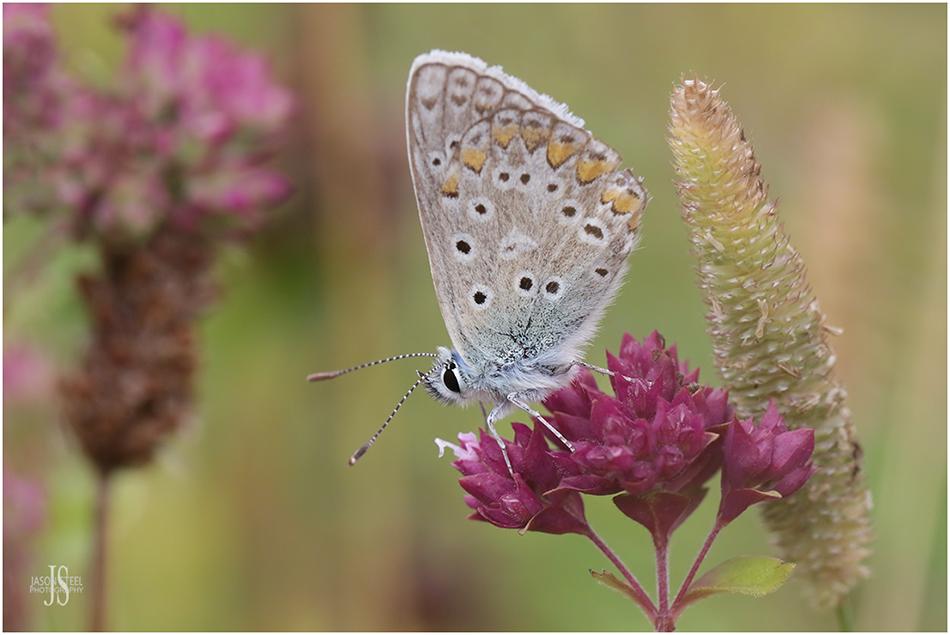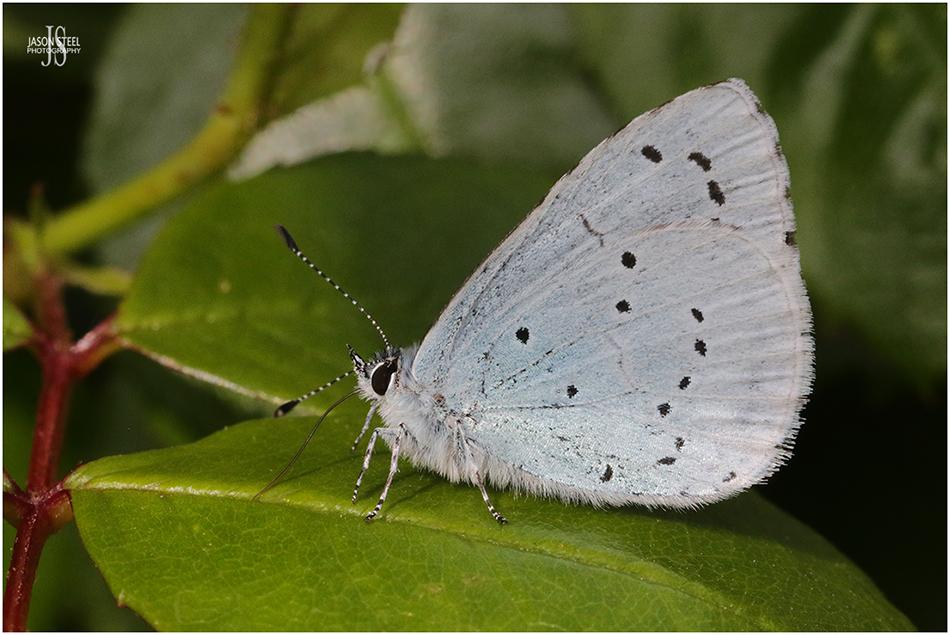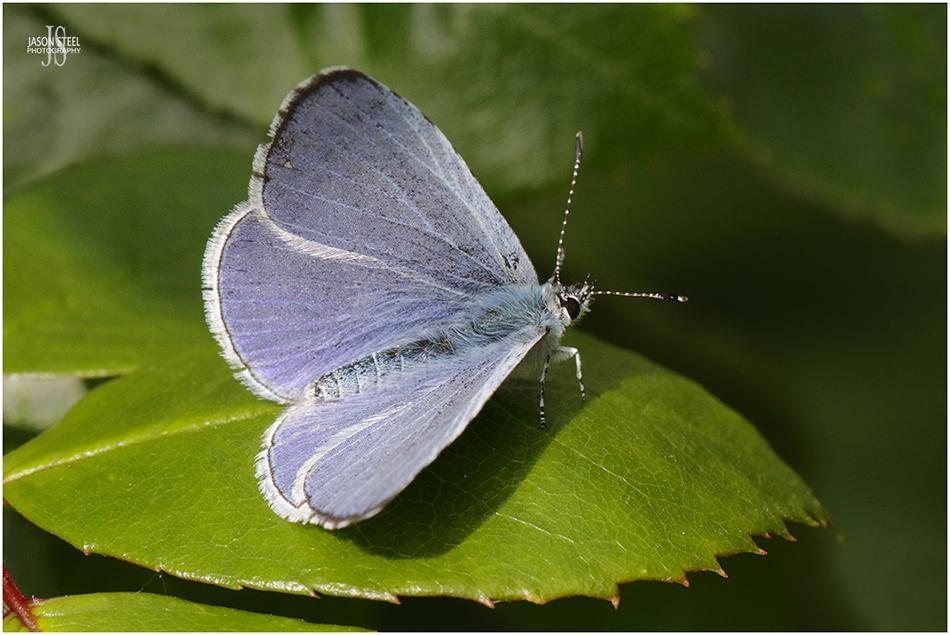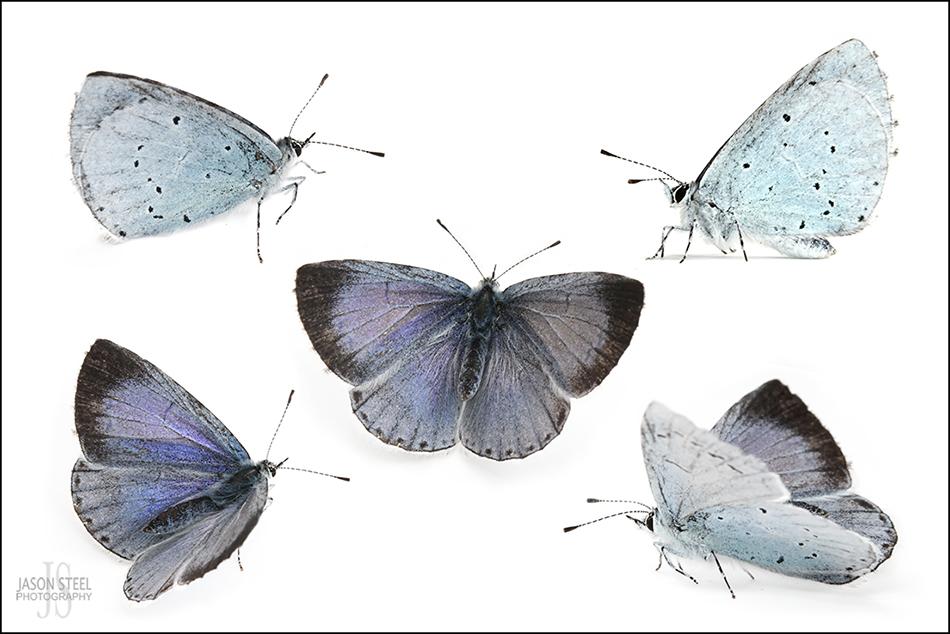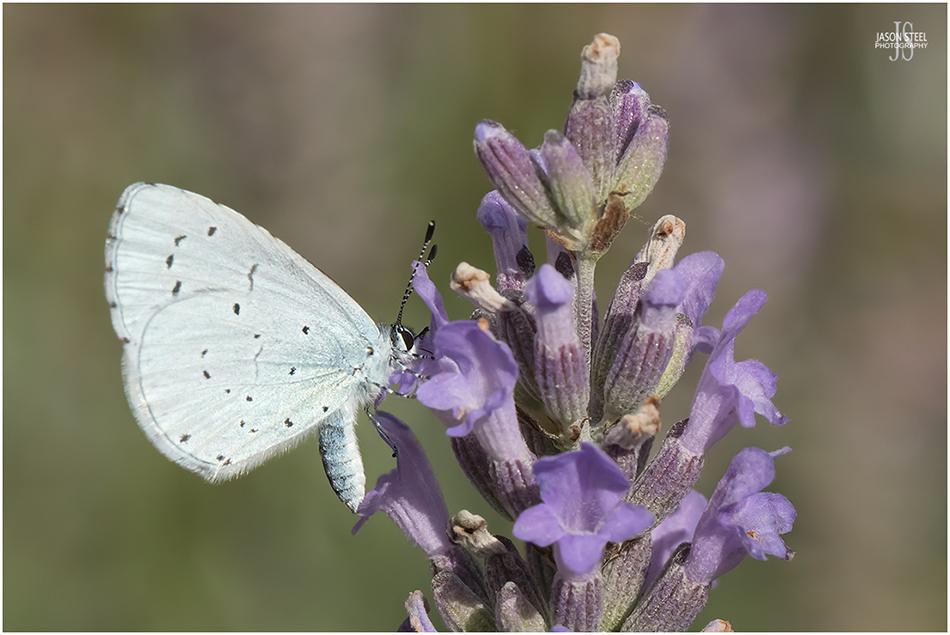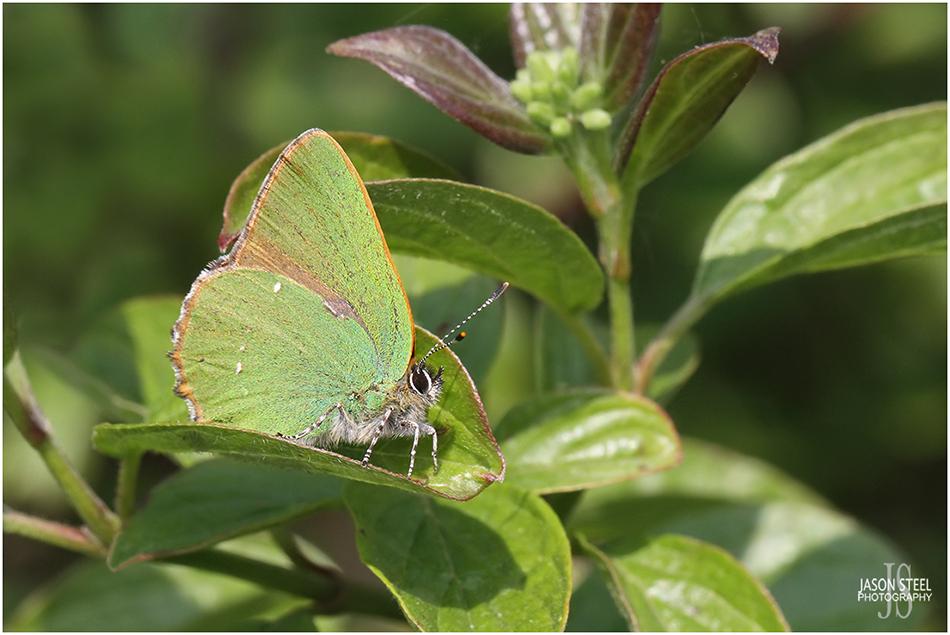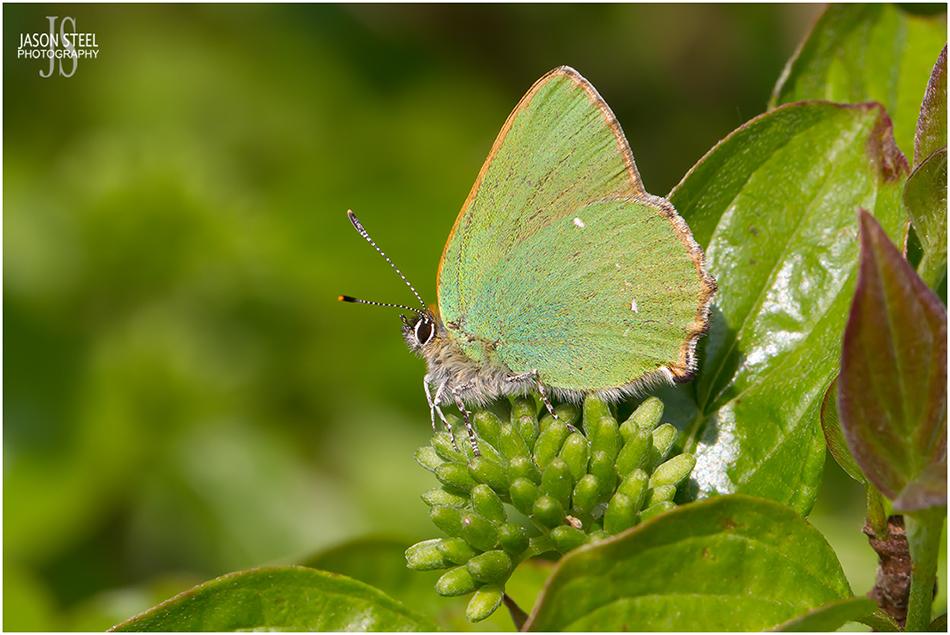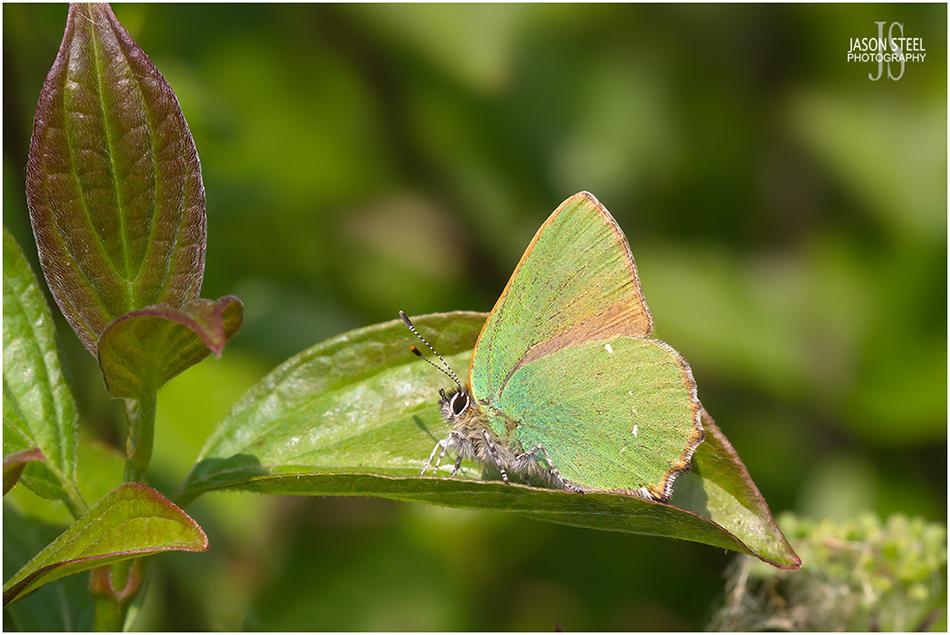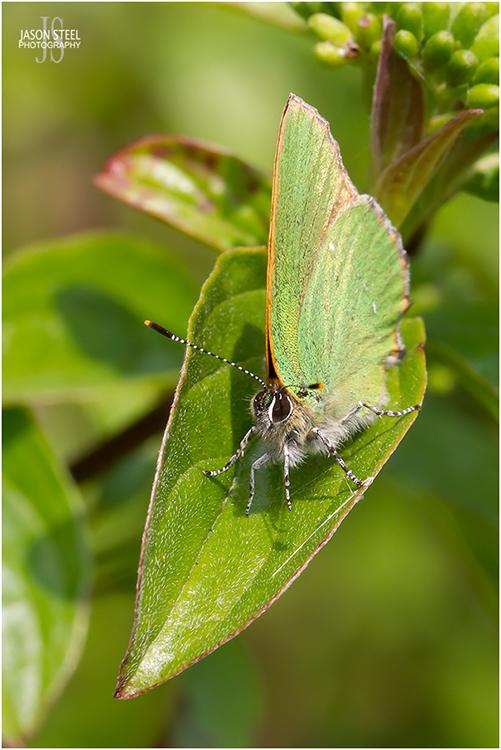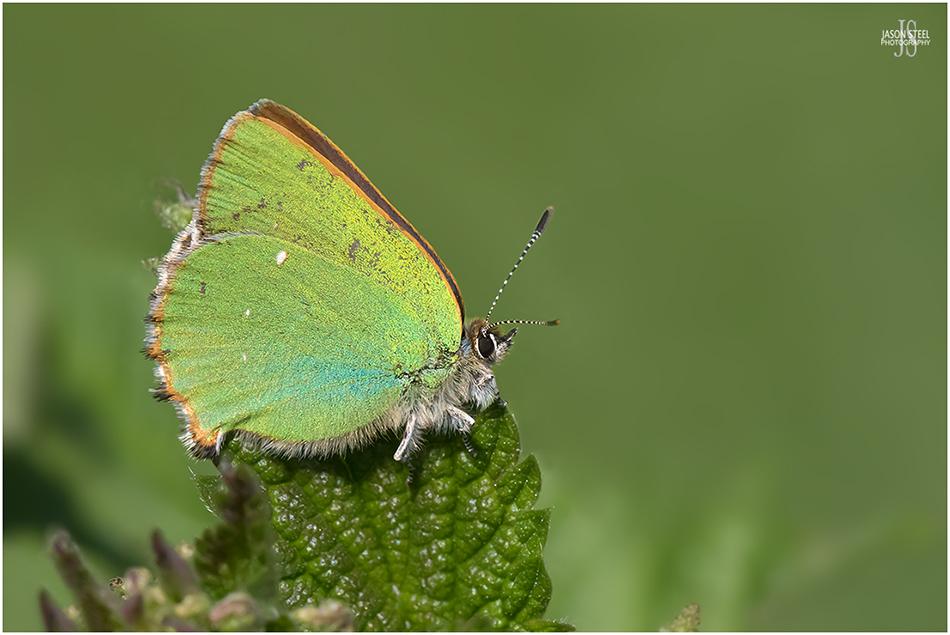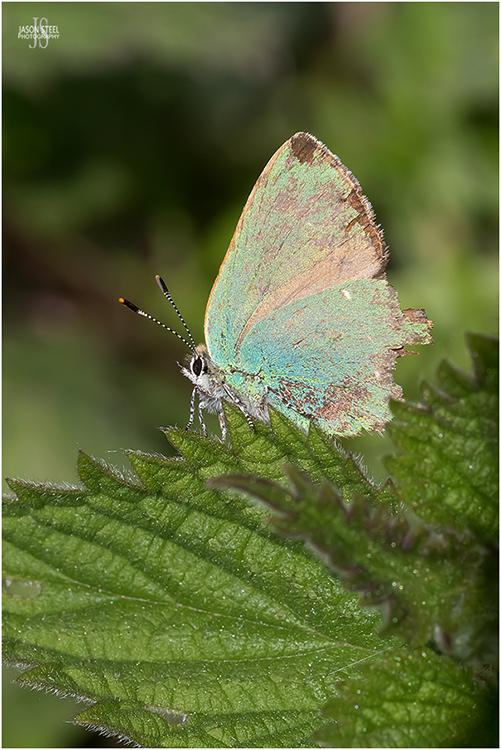Freshly emerged Elephant Hawk Moth
Elephant Hawk Moths are usually seen from May to July, and the caterpillars are usually seen from July until September. The caterpillars feed on Willowherbs, Bedstraw, Honeysuckle and Fuchsia plants. The adult moths feed on nectar. Towards the end of August - September the caterpillars are fully grown. At this stage they come down to the ground and leave their feeding plants. They now wander off looking for dry leaves, bark, loose soil and low vegetation to hide and pupate in. Here they will stay until the following May when they will emerge as an adult moth. Once buried in loose soil and leaves the caterpillar secretes a sticky fluid through its skin, as seen in the bottom-left image above. This quickly hardens and within a few days becomes a hardened pupa. The bottom-right image above shows the pupa just a few days after the caterpillar left its feeding plants. It already resembles a moth inside the cocoon.
Elephant Hawk Moth reared in captivity, hatched 21st April 2017
Elephant Hawk Moth Caterpillar found in a residential garden in SE London, 31st August 2016
Just before pupation occurs the caterpillar starts to secrete a sticky fluid from its skin, giving the caterpillar a dark and glossy appearance as seen in the image above.
Elephant Hawk Moth Caterpillar found in a garden in SE London, 24th August 2016
Elephant Hawk Moth Caterpillar - Green variety
Although when the larvae first hatch they are yellow or pale green in colour, most will quickly turn brown for the rest of the larval stage. A small minority will take on this bright green colour, seen above, and will remain green until they pupate. The adult moths will look the same regardless of the larval colour.
Fully grown 82mm Elephant Hawk Moth Caterpillar - Green variety. Shown on finger for size comparison.
Elephant Hawk Moth Caterpillar - Green variety, feeding on Fuchsia Plant
65mm Privet Hawk Moth caterpillar feeding on Forsythia in my SE London garden, 27th August 2021.
Privet Hawk Moth (Sphinx ligustri)
The Privet Hawk Moth is Britain's largest resident moth, and is only equalled in wing-span on occasion by the late summer / autumn migrant visitor, the Convolvulus Hawk Moth (Agrius convolvuli). Adult moths have a wing-span of between 85-120mm and only live for around five weeks between June and July. Privet Hawk Moths have dark brown and cream wings, and a pink and black banded abdomen. This moth is common and widespread across the southern half of England and Wales but becomes far more scarce the further north it is recorded. Privet Hawk Moths are attracted to light and strongly scented flowers, which they feed from the nectar of at night. Gardens, parks and woodlands are all regular habitat for this moth, and newly emerged adults can often be found resting on tree trunks and fence posts.
The large and distinctive caterpillars are even more impressive and reach 85mm in length. Caterpillars are bright green in colour with yellow spots and purple and white striped markings on their sides, and a black-tipped, curved tail. Whilst Privet is usually the main food source for the larvae they have also been known to feed on Lilac, Ash, Guelder-rose, Holly, Honeysuckle, Snowberry, Vibernum tinus, Forsythia and Spirea. Where the caterpillars feed on ash, it is usually found on saplings or the bushy low re-growth from coppiced trees. Caterpillars can be found from July until September before they bury themselves deep in leaf-litter or soil, sometimes 30cm or more beneath the surface to pupate. The pupation period is long and continues through the winter until the following June or July and can take 9 months or more. The chrysalis is about 45mm in length and dark brown in colour. It has a small point at the tail end and a small loop at the head end.
After searching in vain for many years hoping to find these caterpillars on the large privet bush in my SE London garden, I finally found this beautiful 65mm specimen on the Forsythia bush next to the Privet Bush. It continued to feed on the Forsythia leaves as I photographed it every day. After just one week Colin the Caterpillar had grown in length from 65mm to 75mm.
Prolegs
The Privet Hawk Moth in the image above can be seen gripping the stem of the host plant using its 5 pairs of prolegs. It's 3 pairs of real legs are at the front of the caterpillar, right behind the head, and are much smaller in size than the prolegs. Most "walking" is performed using the prolegs to grip onto the surface whilst the caterpillars abdominal muscles move the body of the caterpillar forward. A caterpillar relies on its real legs though when climbing a silken thread. The number of prolegs varies between different species from 2-5 pairs, but 4-5 pairs is most common. Prolegs have some muscular function but they are primarily operated by hydraulic fluid. Prolegs are not jointed and therefore do not have separate segments like traditional legs. The prolegs grip with a series of tiny hooks at the padded base, known as the crochet. The arrangement of these hooks is often used to identify caterpillars down to family level. The number of prolegs and their arrangement is also a useful feature for identifying caterpillars. When the caterpillar transforms into an adult moth or butterfly its prolegs will be lost. However its real legs will continue to grow into longer and more useful limbs.
LINK
Privet Hawk Moth caterpillar feeding on Forsythia in my SE London garden, 28th August 2021.
65mm Privet Hawk Moth caterpillar feeding on Forsythia in my SE London garden, 27th August 2021.
65mm Privet Hawk Moth caterpillar feeding on Forsythia in my SE London garden, 27th August 2021.
Privet Hawk Moth caterpillar feeding on Forsythia in my SE London garden, 30th August 2021.
Privet Hawk Moth caterpillar feeding on Forsythia in my SE London garden, 27th August 2021.
Privet Hawk Moth caterpillar feeding on Forsythia in my SE London garden, 27th August 2021.
65mm Privet Hawk Moth caterpillar.
80mm Oleander Hawk-Moth larvae. This specimen was one of 8 found feeding on a bush in Cyprus, September 2023.
Oleander Hawk-Moth - (Daphnis nerii)
The Oleander Hawk-Moth is a large and colourful species with a wing-span of around 90-130mm. Due its green colouration and patterning this moth is sometimes known as the Army Green Moth. The Oleander Hawk-Moth is usually a migrant that's flown over to the UK from Sicily, Crete, Cyprus or Northern Africa. This species is also widespread in Asia too. In the UK adult moths can sometimes be seen from August to September in the south of England, usually at open coastal sites. There is some discrepancy over whether this species has been known to breed in the UK or not. If it does happen then it's a very rare occurrence. The large colourful caterpillars are bright green in colour until their final stage of development. In this final stage, as the larvae reach their full size, they become a rustic orange colour. These larvae can reach up to 130mm in length. The primary larval food-plants are Periwinkle, Vinca spp, and oleander, Nerium oleander. The larvae pupate under loose soil and leaf litter. In warm conditions the moths can emerge as quickly as 18-30 days.
70mm Oleander Hawk-Moth larvae. This specimen was one of 8 found feeding on a bush in Cyprus, September 2023.
70mm Oleander Hawk-Moth larvae. This specimen was one of 8 found feeding on a bush in Cyprus, September 2023.
70mm Oleander Hawk-Moth larvae. This specimen was one of 8 found feeding on a bush in Cyprus, September 2023.
70mm Oleander Hawk-Moth larvae. This specimen was one of 8 found feeding on a bush in Cyprus, September 2023.
Oleander Hawk-Moth larvae. These specimens were found feeding on a bush in Cyprus, September 2023.
Oleander Hawk-Moth larvae. These specimens were found feeding on a bush in Cyprus, September 2023.
Poplar Hawk Moth - (Laothoe populi)
Puss Moth caterpillar in the Brooke Bond "Wonders of Wildlife" tea-card collection.
I have been interested in wildlife since I was a young boy. In 1978, at the age of seven years old, I was given a collection of tea-cards. The series that interested me the most was the Brooke Bond "Wonders of Wildlife" tea-card collection. One of my favourite cards in that series was the Puss Moth caterpillar and I searched bushes and trees ever since in the hope of finding one myself. Although considered as a common and widespread species it took me another 43 years to find my first Puss Moth caterpillar, a 40mm specimen, 6ft above the ground ,in the evening at Swanscombe Marshes, Kent.
Puss Moth caterpillar putting on a threat display at Swanscombe Marshes, 11th July 2021.
One of two Puss Moth caterpillars found in the morning feeding on a young Goat Willow Tree (Salix caprea) on Swanscombe Marshes, Kent, 11th July 2021.
Puss Moth caterpillar putting on a threat display at Swanscombe Marshes, 11th July 2021.
Puss Moth caterpillar at Swanscombe Marshes, 11th July 2021.
Puss Moth caterpillar at Swanscombe Marshes, 11th July 2021.
Puss Moth caterpillar at Swanscombe Marshes, 24th July 2021.
The colour of this Puss Moth caterpillar is now starting to change as it comes to the end of its larval stage. The wide dorsal stripe is now a uniformly dark reddish brown, and the previously white dots along its flanks are now black. The front legs have lost their yellow and black stripes.
Puss Moth caterpillar (Cerura vinula) 11th July 2021
A mating pair of 6-Spot Burnet Moths, photographed in a wildflower meadow along a railway line in Kent 21/07/2019
A mating pair of 6-Spot Burnet Moths, photographed at Swanscombe Marshes in Kent 24/07/2021
Cinnabar Moth Caterpillar
Cinnabar Moth Caterpillar feeding on Ragwort
Cinnabar Moth Caterpillar feeding on Ragwort, at Swanscombe Marshes, 3rd July 2022.
15mm Grey Dagger Moth found on a low branch of an oak tree in Alexander Park, Hastings, 16th September 2021.
Grey Dagger Moth - (Acronicta psi)
The Grey Dagger Moth is a medium sized moth with a wing-span of 34-40mm. The adults get their name from the dark dagger-like markings on their forewings. The larvae are distinctive with bright red and yellow colours and a tall black hump on the front end of their back. They can be found from July to October, and sometimes November, in hedgerows, woodlands and gardens. They feed on a variety of broad-leaved trees and shrubs including Oak, Blackthorn (Prunus spinosa), hawthorns, Apple (Malus domestica) birches, Sweet Chestnut (Castanae sativa), limes, elms and Rowan (Sorbus aucuparia). The caterpillars are fully grown after 30-35 days and overwinter as a pupae under loose bark and in gaps in rotting wood. Adult moths can be seen from June to early August.
As an adult the Grey Dagger Moth needs very close examination to distinguish it from the almost identical looking Dark Dagger Moth (Acronicta tridens).
Knot Grass Moth caterpillar (Acronicta rumicis)
Knot Grass Moth - (Acronicta rumicis)
A common moth across the UK with a wing-span of around 30-35mm. Caterpillars grow to 40mm in length and can be found feeding on a wide variety of herbaceous plants during the day. Adult moths can be seen on the wing during May to July. In the south of England a second brood can also be seen in August and September. The larvae take 30 days to fully develop and pupate amongst leaf litter.
35mm Knot Grass Moth caterpillar, Acronicta rumicis, found on low vegetation in a grass meadow in Canterbury, Kent, 2nd May 2022.
35mm Knot Grass Moth caterpillar, Acronicta rumicis, found on low vegetation in a grass meadow in Canterbury, Kent, 2nd May 2022.
35mm Knot Grass Moth caterpillar, Acronicta rumicis, found on low vegetation in a grass meadow in Canterbury, Kent, 2nd May 2022.
40mm Jersey Tiger Moth Caterpillar
Despite the number of Tiger Moths declining significantly in the UK over recent years the Jersey Tiger Moth has managed to expand its range and has increased in numbers in parts of Southern England.
Garden Tiger Moth caterpillar
Garden Tiger Moth (Arctia caja)
The caterpillars of the Garden Tiger Moth are often referred to as "Woolly Bear Caterpillars". Woolly Bear Caterpillars grow to around 6cm when fully developed and prefer to feed on Lambs Quarters, Violets and Clovers. They will also eat Dandelions, Nettles, Sunflower, Burdock and Yellow & Curly Docks. They are not a specialist feeder and feed on most wild plants and occasionally also eat garden plants including Spinach, Cabbage, Greens and Herbs.
27mm White Ermine Moth caterpillar found crossing a garden path in SE London, 6th August 2020.
White Ermine Moth (Spilosoma lubricipeda)
The White Ermine Moth is a medium sized moth from the same family as the Tiger Moths. They have white fore-wings with a varying number of black spots and a wing-span of around 34-48mm. Further north in England and in Scotland cream coloured specimens occur and occasionally brown specimens too. Adults are usually seen flying from May to July and sometimes later in the south of the England.
Caterpillars feed on a range of herbaceous plants including nettles and can be found from July until September before they pupate and overwinter amidst plant debris. White Ermine Moths are common across the UK in rural and urban environments including parks and gardens.
50mm Fox Moth caterpillar (Macrothylacia rubi) found on brambles in sand dunes at Horsey Gap, Great Yarmouth, September 2019.
Fox Moth (Macrothylacia rubi)
The Fox Moth is a fairly large moth with a typical wing-span of 44-62mm and sometimes 70mm . It gets its name from the colouration of the male which tends to be a beautiful orange brown. Specimens from the north of the country tend to be less orange and females tend to be even less colourful with many specimens appearing grey across the UK. The females are slightly larger with longer forewings. Females also lack the feathery antennae found on the males. The caterpillars are large and grow to around 70mm before pupating. Caterpillars start off black with bright orange bands but as they age the colour changes from black to reddish grey / brown with long grey hairs. The caterpillars can be found on heathland and coastal grassland feeding on brambles and heather from July until winter when they hibernate. Caterpillars emerge again in the spring and continue to bask on sunny days before pupating in April. In some areas the Fox Moth can be found on moors and open woodland too.
Adults can be found from May until early July. Female specimens only fly at night unless disturbed but male specimens can also be observed flying low to the ground during the afternoon as they search for a female to mate with.
Swallow-Tailed Moth (Ourapteryx sambucaria)
The Swallow-Tailed Moth is a large and unmistakable species with a wing-span of 44-60mm across. Newly emerged moths have yellow wings which fade to white in older specimens. These moths are strictly nocturnal unless disturbed during the daytime. At night they fly at great speed around woodland, parks and gardens. The caterpillars feed on a variety of woody broadleaves including Blackthorn, Hawthorn, Ivy, Elder and Horse Chestnut. They are usually seen in flight from June to August. Caterpillars overwinter in loose tree bark.
Light Emerald Moth (Campaea margaritata) found in my garden in SE London, 27th August 2017.
Light Emerald Moth (Campaea margaritata)
In the UK there are several different species of Emerald Moth from the
Geometridae family. Whilst newly emerged specimens are easy to identify their green colour fades quickly and identification is then easiest by looking at the wing-shapes and markings. -
Emerald Moths of the UK
The Light Emerald Moth is a common and widespread medium sized species with a wing-span of 36-52mm. They are found across the UK around deciduous woodland, parks and gardens. The larvae are long, thin and brown and can resemble a twig. They have a distinctive fringe of hairs that run the length of their underside and they feed on the leaves of deciduous trees and bushes from August to the following June. The larvae overwinter laying flat to the stem of the host plant. Adults can be seen flying from June to August and a second generation is often seen from August to September. Some adult specimens fade as they age and can be so pale they appear almost white in colour.
Small Emerald Moth from my SE London garden, 16th July 2020
Small Emerald Moth (Hemistola chrysoprasaria)
The Small Emerald Moth is found locally at sites mainly in the south of England and Wales. They have an average wing-span ranging from 28-40mm. Initially the adult moths are a bluish-green colour but they fade to white as the moth ages. Adults are usually found on the wing during July and August. The larvae are brown in colour during September and October and have great camouflage with a strong resemblance to the dead stems of the host plant, Traveller's Joy (Clematis vitalba). From November to the following March the larvae are generally inactive and resume feeding again in April to May. During this period the larvae are now green in colour and have excellent camouflage against the new green shoots of the host plant. The larvae reach around 12mm in length before pupating around June in cocoons hanging from silken threads from the host plant. This species favours hedgerows, open woodland and gardens, specifically with chalk or limestone soil where Clematis vitalba can grow.
Pale specimens of the Small Emerald are sometimes confused with the Light Emerald,
Campaea margaritata, but the two can be distinguished by looking closely at the wings. On the Light Emerald the white cross-lines on the wings are generally much straighter than those seen on the wings of the Small
Emerald.
Small Emerald Moth (Hemistola chrysoprasaria) found in a building in SE London, 7th July 2023.
Small Magpie Moth (Anania hortulata)
25mm Yellow Shell Moth (Camptogramma bilineata), one of many found in my garden in SE London 22nd August 2019
The Yellow Shell Moth is highly variable in shades and patterning. This is one of the less common variations of the species.
Leaf Litter Moth (Oegoconia Species) that flew into my house in SE London, 2nd July 2020
Leaf Litter Moth (Oegoconia Species)
A small micro-moth with a wing-span of 11-17mm. Usually flies from June to August. Larvae feed on leaf litter and decaying plant matter. There are three indistinguishable species in Britain that can only be separated by microscopic examination: Oegoconia quadripuncta, Oegoconia caradjai and O. deauratella.
Box-Tree Moth - (Cydalima perspectalis)
Box-Tree Moth (Cydalima perspectalis)
The Box-Tree Moth is an invasive species of moth from Asia. It was first recorded in the UK in 2007 as an adult and 2011 as a caterpillar. It has a wing-span of around 40mm and its wings have an iridescent sheen which can vary in colour from purple, gold, and green depending on how the sun's light is reflected.
Unfortunately the caterpillars of this moth are so destructive to Box plants that the Royal Horticultural Society has ranked this moth as the top garden pest in the UK! At the moment sightings were confined to the South-East of England but they are now spreading across all of England and the RHS has been asking for records of all sightings to be submitted since 2018:
Report Sightings HereThe caterpillars are dangerous because they have no natural predators due to the toxins in their skin making them inedible to birds and other insects in the UK.
Box-Tree Moth (Cydalima perspectalis) - Moving the light-source around shows the different shades and colours created by the iridescent sheen on the moth.
Box-Tree Moth (Cydalima perspectalis) - Lighter morph.
The Box-Tree Moth comes in two common variations or morphs. The lighter morph that appears almost white with a brown boarder, and the darker morph which is brown / purple. Both have a pearlescent sheen. The caterpillars of both variations are identical. There may also be a very pale morph as occasionally very pale specimens have been found. These may however jus be very faded examples of the lighter morph at the end of the season.
LINK 1
25mm Box-Tree Moth caterpillar (Cydalima perspectalis). Photographed in SE London garden in mid August 2019
Box-Tree Moth (Cydalima perspectalis) - Back-lit against my kitchen window.
One of hundreds of Box Tree Mothy caterpillars feeding on Box plants in Rochester, Kent, 17th May 2021.
Where Box-Tree Moths are found they are often in very high numbers. Their vivacious appetite for the leaves of Box plants causes extensive damage to the plants which eventually results in the death of the plant.
Female Bee Moth, found resting on low vegetation at Ashdown Forest, East Sussex, 20th May 2022
Bee Moth / Wax Moth - (Aphomia sociella)
The Bee Moth is a small / medium sized moth with a wingspan ranging from 18-44 mm. The Bee Moth is from the Galleriinae subfamily of Snout Moths, and is common and widespread across the UK. Males are typically more patterned and colourful, and lack the black spots on the wings. Despite its insignificant appearance the larvae of the Bee Moth can be a serious pest to bumble bees and social wasps. The female moth sneaks into the nest of bees, and social wasps, and lays around 100 eggs. The larvae of the Bee Moth are small white grubs, with orange heads, and once hatched they quickly begin feeding on the wax walls of the cells in the nest. The Bee Moth larvae feed largely on the waxy cell walls, hence the name Wax Moth, but they don't just eat the wax walls. Bee Moth larvae also feed on the nectar and pollen stored in the cells, and even on the bee larvae themselves. The Bee Moth larvae will eat everything in their path, including debris and dead bees. Adult moths are typically on the wing from June to August, but can on occasion be recorded from April through to October.
28mm Riband Wave Moth (Idaea aversata). Found in my suburban garden in SE London in July 17th 2020
Small Dusty Wave Moth (Idaea seriata) found on my dining-room window in SE London, 26th May 2020
Small Dusty Wave Moth (Idaea seriata)
The Small Dusty Wave Moth is a small and rather plain looking nocturnal moth with an average wing-span of 19-21mm. It is commonly found in woodlands, wasteland and gardens and seems to have a preference for resting on walls and windows of houses. Adult forms are found across the UK, usually from June to July. In the south of England a second brood can usually be seen from August to September. The caterpillars feed on a variety of herbaceous plants including ivy.
42mm male Willow Beauty Moth (Peribatodes rhomboidaria) that visited our bathroom one evening on 29th June 2020.
Willow Beauty Moth (Peribatodes rhomboidaria)
The Willow Beauty is a medium-sized moth with a wingspan of around 30-48mm. Willow Beauties are one of several very similar Beauty Moths that can be tricky to distinguish, but the Willow Beauty is the most common and widespread. Ironically the Beauty Moths are all fairly dull in appearance. Although usually brownish in colour Willow Beauty has a grey variation (f. perfumaria) and a dark melanic variation (f. rebeli).
This species is often found in woodland, parks and gardens in July and August and again in September in the south of England. The caterpillar larvae feed on Hawthorn, Ivy Privet, Honeysuckle and various broadleaved deciduous trees.
40mm male Willow Beauty Moth caught in a moth trap in my garden in SE London, 2nd August 2020.
30mm Grey Birch Moth (Aethalura punctulata) found sheltering on a tree-trunk in shaded woodland at Ashdown Forest, East Sussex, June 2022.
Grey Birch Moth - (Aethalura punctulata)
The Grey Birch is a small / medium sized moth that's common and widespread across the UK, especially in England and Wales. It has a wing-span of around 30-35mm and adults can be seen flying at night during May and June. This species is most commonly associated with woodland habitats and the leaves of Birch Trees (Betula) are the main food source for the larvae. The caterpillars have are also known to feed on Alder Trees (Alnus glutinosa) too. The Grey Birch Moth is typically a mottled greyish-brown colour with three darker transverse line across its wings.
Large Yellow Underwing Moth - (Noctua pronuba)
Large Yellow Underwing Moth (Noctua pronuba)
A large and common moth found throughout Britain, with a wing-span of 45-55mm. It's possibly the most commonly encountered of the UK's larger moths in July - September. This dull brown / grey moth reveals it's subtle beauty when it flashes its bright yellow / orange underwings. The yellow / light brown caterpillars feed on a variety of herbaceous plants and grasses.
Large Yellow Underwing Moth larvae - (Noctua pronuba)
This specimen measured 48mm in length and was found in my garden in SE London under a tuft of grass 8th September 2019. The caterpillar of this moth is extremely similar in appearance to that of the Heart & Dart Moth (Agrotis exclamationis).
Lesser Broad Bordered Yellow Underwing Moth, photographed in my SE London garden, 8th August 2021
Lesser Broad Bordered Yellow Underwing Moth (Noctua janthe)
A medium-sized moth with a wingspan of 30-40mm. Adult moths are found throughout Britain and fairly common in the south of England in woodland, hedgerows and gardens. This species is often attracted to flowers, especially Ragwort, Lavender, and Buddleia. They are also attracted to light and regularly turn up in light traps. The forewings wings can vary from a reddish brown to purple in colour. The underwings are yellow to orange with a wide black band. Adults can be seen from July to September. This species is breeding in the south of Britain. The larvae overwinter and can be found from September to May, and feed on deciduous trees, shrubs and various herbaceous and woody plants including Blackthorn, Willow, White Dead Nettle, Broad-leaved Dock and Scentless Mayweed. This is a fairly new species to the UK and was first recorded here in 2001. Noctua janthe is almost identical to Noctua janthina and the two species can be difficult to separate.
Lesser Broad Bordered Yellow Underwing Moth, photographed in my SE London garden, 8th August 2021
35mm larvae of Noctua comes, photographed on Forsythia, in my SE London garden, 15th April 2023
Lesser Yellow Underwing Moth (Noctua comes)
A medium-sized moth with a wingspan of 37-45mm. The Lesser Yellow Underwing is common throughout Britain. The caterpillars of both the Lesser Yellow Underwing, and the Lesser Broad-bordered Yellow Underwing feed on wide variety of shrubs at night. Caterpillars can be seen around September / October, before hibernating. They reappear between April and June. Adult moths are on the wing from July until September, and can show considerable variation in both colour and patterning of the forewings.
35mm larvae of Noctua comes, photographed on Forsythia, in my SE London garden, 5th May 2023
35mm larvae of the Buff Ermine Moth, photographed on lake-side nettles, in a public park in north Kent, 16th September 2023.
Buff Ermine Moth - Spilarctia luteum
The Buff Ermine moth is an attractive, medium-sized moth with a typical wingspan of around 28-44mm. The forewings range from a yellowish-buff colour to a paler white-buff. The wings have a varying number of black dots but usually include a row of elongated black dots that run from the tip pf the forewing to the trailing edge of the wing. This row of dots distinguishes the the Buff Ermine moth from the sometimes similar White Ermine. Occasionally black forms can occur.
This moth belongs to the Arctiidae family that contains the Tiger Moths, Ermines and Footman Moths. The Buff Ermine moth is considered as common and widespread in the UK and can usually be found in gardens, parks, hedgerows and woodland. Adults can be seen from May to July.
The hairy larvae can be found from July to October, feeding on a wide range of herbaceous plants, especially Common Nettle, Honeysuckle and Birches. The larvae pupate at the end of autumn amongst plant debris and leaf litter. The caterpillar pictured above is quite a pale specimen and the larvae of this species are more typically darker brown with dark orange hairs.
Cabbage Moth (Mamestra brassicae)
Cabbage Moth (Mamestra brassicae)
A common moth found throughout Britain, Europe and North Africa, with a wing-span of 40mm. Adult moths fly from May to October. The Cabbage Moth is considered a pest and is highly destructive to many crops especially vegetables. Moths lay 2 or 3 broods of eggs each year and caterpillars can be found throughout the year. Late broods overwinter as pupae in the soil.
Adult moths can resemble other species but can always be distinguished by a curved spur on the tibia of the foreleg if examined closely.
Cabbage Moth (Mamestra brassicae) late phase.
The eggs are pale green in colour but develop dark centres within a few days of being laid. The eggs hatch after about 7 days and caterpillars are fully grown at 40mm in length after a further 30 days. They then pupate in soil and emerge as moths after 14-21 days. These caterpillars change appearance 4 times as they develop and can vary considerably with different shades of green and brown.
38mm female Gypsy Moth cocoon
This large cocoon was found in my garden tool shed in late July. I kept it in an indoor tank for two weeks until it emerged as a female Gypsy Moth.
Female Gypsy Moth with a wingspan of around 60mm
Male Gypsy Moth with a wingspan of around 40mm
Female Gypsy Moth with two competing males.
After photographing the freshly emerged female Gypsy Moth I placed it at the bottom of my garden on the trunk of a large Sycamore Tree. Within just three minutes three male specimens had arrived on the scene attracted by the powerful pheromones released by the female. The males have large and prominent feather-like antennae which are used to detect the faintest trace of the female's pheromones. Once on the scene it really was just a case of "first come, first served" as two of the males both tried to get into a mating position with the female. As soon as a male had attached himself to the female the other males immediately lost interest and I suspect at that point the female had stopped releasing her pheromones.
Female Gypsy Moth sitting over her egg mass, which will hatch in the following spring.
After mating the female walked to the sheltered rear of the tree and laid her egg mass on the bark. Here she remained for the two next weeks sitting on top of her eggs, looking worn and battered by the weather.
Silver Y Moth (Autographa gamma)
Silver Y Moth - (Autographa gamma. Previously Phytometra gamma and Plusia gamma)
The Silver Y Moth can vary considerably in colour but it gets its name from the characteristic "Y" always present on the fore-wings. This moth is an immigrant species coming to the whole of the UK from Europe, anywhere from spring to autumn. It can often be seen flying in both day and night. This is a medium-sized moth with a wing-span of 35-40mm. Caterpillars are green in colour and feed on a variety of low plants. Numbers of adults can vary each year but on occasion this species can be very numerous in the south and SE of England.
17mm Bright-Line Brown-Eye Moth caterpillar (Lacanobia oleracea)
Angle Shades Moth (Phlogophora meticulosa)
Angle Shades Moth (Phlogophora meticulosa)
The Angle Shades Moth is an attractive and distinctive moth with pinkish brown colouration, giving it excellent camouflage as it rests on twigs alongside weathered autumn leaves. This is a medium sized moth, with a wingspan of around 42-52mm, that is common across the UK. Adults fly mainly at night and can often be found resting on garden fences, walls and vegetation during the daytime. Most adults are seen between May and October, although this species has at least two broods and specimens have been recorded all year round in both adult and larvae form. This is a migratory species and numbers can increase significantly at times, with visitors from abroad, especially at southern coastal locations.
The larvae come in two forms, a dull green form and a brown / orange form. Both have rows of chevron markings, when viewed from above, and a pale stripe that runs along their sides. These caterpillars reach around 45mm in length before pupating. They feed at night on a wide range of herbaceous plants, including Common Nettle, Hops, Red Valerian, Broad-leaved Dock, Bramble, Hazel, Barberry, Birches and Oaks. The larvae continue feeding during the winter as long as the temperatures remain above freezing. The Angle Shades Moth is from the Noctuidae family of Arches, brindles, minors, rustics and allies.
The only species this moth is sometimes confused with is the closely related, but far smaller, Small Angle Shades, Euplexia lucipara.
43mm Angle Shades Moth larvae (Phlogophora meticulosa)
This fully grown 43mm Angle Shades Moth caterpillar was found on some Highlander Rose plants, Saxifraga, that my wife bought 6th November 2021. Within two days it had eaten all the leaves on the plants before disappearing. The adult moth emerged exactly a month later on the 7th December 2021 when it was found flying around my hallway. These larvae usually bury themselves beneath leaf-litter, or just beneath the surface of loose soil, to pupate.
Angle Shades Moth (Phlogophora meticulosa)
Angle Shades Moth (Phlogophora meticulosa)
The Herald Moth (Scoliopteryx libatrix)
The Herald Moth (Scoliopteryx libatrix)
The Herald Moth is a distinctive and unmistakable, medium-sized, nocturnal species, with a wing-span of 38-46mm. They're widespread and common across the UK. Adults are usually seen feeding on overripe berries and flowers at night, from early spring to late in the year. This species overwinters late as an adult and is often found resting in barns and outhouses during the winter, sometimes in groups. The bright green larvae can be found from May to July, with a second brood in the south of England in August. They feed on willows, aspen and other poplars.
Herald Moth found on an inside wall of a tower-block of flats in SE London, 13th October 2021
When captured for photos this moth convincingly played dead, laying on its back with its legs folded underneath. I was able to manipulate the moth into position, and straighten its legs for photos, whilst I was fully convinced the moth was actually dead. It wasn't until I took the moth outside for photos on a natural background that it suddenly came to life and flew away.
Herald Moth, found resting on the roof of a cave in Dorset, 8th August 2022.
Toadflax Moth (Calophasia lunula)
Toadflax Brocade Moth (Calophasia lunula)
The Toadflax Brocade Moth is a medium-sized nocturnal species with a wing-span of 26-38mm. This species has been resident in the UK since 1950 and is now found in Southeast and Central England. The colourful caterpillars grow to 35mm and feed on Toadflax, as the name suggests. Caterpillars are often found on brownfield sites, road verges, gardens, wasteland, shingle beaches or anywhere else that Toadflax grows. This species is native to Continental Europe and North America.
One of several Buff-Tip Moths (Phalera bucephala) feeding on the leaves of an Alder Tree at night in SE London, 22nd August 2021.
Buff-Tip Moth - (Phalera bucephala)
40mm larvae of the Black Rustic Moth (Aporophyla nigra), found on a Gorse Bush at Ashdown Forest, East Sussex, June 2022.
30mm Mottled Umber larvae, found on a Silver Birch Tree at Ashdown Forest, East Sussex, 22nd June 2022
Mottled Umber Moth - (Erannis defoliaria)
Common Carpet Moth (Epirrhoe alternata) perched on gorse at Ashdown Forest, East Sussex, 22nd May 2022.
At first glance this Common Carpet Moth could be mistaken for a butterfly. However, you can quickly identify this specimen as a moth by looking at the antennae. Butterflies have clubs at the end of their antennae but most moths do not. The Burnet moths are an exception to this and do have clubbed antennae. Few moth species hold their wings in an upright position when at rest. This is usually another helpful way to distinguish between butterflies and moths. However, members of the Geometridae family of moths, such as this Epirrhoe alternata do often rest with their wings in an upright position.
Common Bagworm Moth, larval stage. Photographed on Lemon Balm in my SE London garden, 17th May 2021
Common Bagworm Moth / Common Sweep (Psyche casta)
Bagworm Moths, or Case-bearers, as they are also known are an interesting group of micro-moths. In the larval stage they build protective cases around themselves which they carry around with them. Many species can be identified by the shapes of the cases and the materials that are used in their construction.
The Common Bagworm Moth builds its 8-12mm moveable case from the stems of grasses and plants. Both sexes emerge as adults from May to July. When ready to pupate the males will find somewhere at low level to begin their transformation into a small, dusty, sooty-brown moth with unmarked wings and a wing-span of 12-15mm. The antennae have a notably feathery appearance. The females, when ready to pupate, will climb up walls, fences, gates or tree trunks and pupate in an obvious and highly visible location. The flightless and wingless adult female resembles a short plump grub and she will never leave her case which is now securely anchored down. She will emit her pheromones to attract the winged males and mating occurs at the entrance to her case. After mating she will lay between 500 and 1000 eggs inside the case and will die shortly after. When the new larvae emerge her dead body will be their first meal. The larvae now ready to leave the safety of their mother's case will regularly use pieces of her case to start building their own case, before dropping to the ground and dispersing. The eggs of some Bagworm Moths are so resilient that they can even survive being eaten by birds and will pass through the bird's digestive system and still successfully hatch. The larvae of the Common Bagworm Moth feed on grasses, lichen, decaying vegetable matter, and from plants from the groups Poaceae, birch, willow, poplar and vaccinium.
With some species of Bagworm Moth the female dies before laying her eggs. When this happens the eggs will hatch whilst still inside the dead female and the larvae will eat their way out. Other species of Bagworm Moth are parthenogenetic, meaning that the female's eggs do not need fertilising by a male to successfully hatch.
Common Bagworm Moth, larval stage. Photographed on Lemon Balm in my SE London garden, 17th May 2021
--------------------------------------------------------------------------------------------------------------------------------------
BUTTERFLIES
Speckled Wood Butterfly, photographed on lakeside nettles at Cliffe, Kent. 23rd July 2023.
Small White Butterfly in caterpillar form (Pieris rapae)
Male Small White Butterfly (Pieris rapae) photographed at the edge of a grass field in SE London 27th May 2021
Female specimens usually have two dark spots on the forewing. On summer generations the markings tend to be darker and more obvious.
Large White caterpillars (Pieris brassicae) feeding on cabbage leaves in my garden
Small Tortoiseshell Butterfly (Aglais urticae) feeding from a buddleia bush in my garden, 10th July 2020.
Buddleia is often referred to as the "butterfly bush" and it can attract a wide variety of butterfly species when in flower.
Mating pair of Small Tortoiseshell Butterflies, photographed in grass meadow in Lullingstone, Kent, 13th June, 2021
Small Tortoiseshell Butterfly (Aglais urticae) photographed at Looe Beach, Cornwall, 11th August 2022.
Small Tortoiseshell Butterfly (Aglais urticae) photographed at Looe Beach, Cornwall, 11th August 2022.
Small Tortoiseshell Butterfly (Aglais urticae) photographed at Cliffe, Kent, 30th March 2024.
Fresh from hibernation, this Small Tortoiseshell Butterfly drinks from snowdrops in February.
Small Tortoiseshell Butterfly
Small Tortoiseshell Caterpillar
Ringlet Butterfly
Ringlet Butterfly (Aphantopus hyperantus)
A medium sized butterfly with a wingspan of 48mm for males and 52mm for females. Found in woodland clearings, meadows, hedgerows, country lanes. Not often seen in open ares without cover. The dark colouration of its wings enables it to warm up quickly and it is one of the few British species seen flying on dull overcast days.
Freshly emerged Red Admiral Butterfly, photographed in Great Yarmouth September 2019
Freshly emerged Red Admiral Butterfly, photographed in Great Yarmouth September 2019
Red Admiral Butterfly, photographed in Great Yarmouth September 2019
Red Admiral Butterfly feeding from Blackberries, at Pevensey Levels, 17th September 2021.
Red Admiral Butterfly, photographed on the ground near Scotney Castle, in Kent, 30th August 2022.
Marbled White Butterfly photographed early evening in Lullingstone, Kent 13/07/2019
Marbled White Butterfly photographed early evening in Lullingstone, Kent 13/07/2019
Painted Lady Butterfly (Vanessa cardui) photographed in SE London, August 27th 2019
Painted Lady Butterfly (Vanessa cardui) photographed in SE London, August 27th 2019
Painted Lady Butterfly (Vanessa cardui) photographed in Horsey, Great Yarmouth September 2019
Painted Lady Butterfly (Vanessa cardui) photographed in Horsey, Great Yarmouth September 2019
As a migrating species some specimens show considerable wear and tear after making their long journey to the UK from North Africa.
Peacock Butterfly photographed at a grass meadow in SE London, 3rd June 2021
Peacock Butterfly resting on grass, at Pevensey Levels, 17th September 2021.
Peacock Butterfly Caterpillar
A weathered Comma Butterfly with missing legs and battered wings. Photographed in late July.
Comma Butterfly (Polygonia c-album)
A medium-sized butterfly found across England and Wales with a wing-span of 50-64mm. This butterfly gets its name from the single white mark on its under-wings that resemble a comma. The jagged edge to the wings make this an easy species to identify in the field, and give the butterfly the appearance of being a dead leaf when the wings are held together. Males and females look similar but males tend to be slightly darker and more vibrant, and usually have a wide darker border around the edge of their wings. Females are typically slightly larger. The Comma butterfly overwinters as an adult butterfly and emerges in early spring on sunny days. Males are territorial and will chase off other males and butterflies of other species too.
The Comma Butterfly is not migratory and all specimens found in the UK have developed from larvae in this country. Due to the Comma's strong flying ability this species can easily travel to new sites and mate with specimens from completely unrelated colonies. As such the gene pool is kept strong and healthy. The larvae are generalist feeders (polyphagous)and will feed from a range of different plants, usually nettles and hops, for around 5 weeks before pupating. The quality of the larval food affects the strength and lifespan of the adult butterflies so the larvae prefer to feed from Urtica dioica, Ulmus glabra, Salix caprea, R. uva-crispa, and Betula pubescens. Eggs are laid singularly on the host plants. Initially the eggs are green but soon turn yellow, and then finally grey.
Comma Butterfly, Darenth, Kent, 27th March 2011
Comma Butterfly in Great Yarmouth, September 2019
Comma Butterfly in Shorne Woods Country Park, Kent, 2nd August 2022
Comma Butterfly, photographed in Lullingstone, 19th August 2021
Comma Butterfly on Blackthorn, photographed at Pevensey Levels, 17th September 2021.
Comma Butterfly, photographed at Lullingstone, Kent, 7th May 2023.
Comma Butterfly, photographed at Cliffe, Kent, 30th March 2024.
Comma Butterfly, photographed at Cliffe, Kent, 30th March 2024.
Comma Butterfly, photographed at Cliffe, Kent, 30th March 2024.
Comma Butterfly, photographed at Cliffe, Kent, 30th March 2024.
30mm Comma Butterfly larvae on nettles in my SE London garden, 14th August 2021
During the first three instar stages the caterpillars are dull and camouflaged, and usually feed on the underside of the leaves of the host plants. The final instar caterpillars are boldly coloured, and have developed strong spines to help deter potential predators. These late instars can be seen more easily as they often feed on the surface of the leaves. The pupae resemble and brown, shrivelled up dead leaf. Pupation takes around 10-11 days.
Small Copper Butterfly, photographed on low vegetation in a grass meadow in Bexley, SE London, 3rd June 2021.
Meadow Brown Butterfly, photographed on low vegetation in Lamberhurst, Kent, 31st August 2022
Meadow Brown - (Maniola jurtina)
The Meadow Brown Butterfly is a medium-sized butterfly with a wingspan of around 42-60mm. This species is common and widespread across the UK. The larvae feed on a variety of grasses and can be found in many habitats including grasslands, downland, heathland, coastal dunes, meadows, hedgerows, gardens, roadside verges and woodland. Adults can be seen from June until the end of September and will often fly even in dull, overcast conditions when most other species won't fly. The larvae can be found feeding on grasses all year round. From spring onwards the larvae tend to be nocturnal feeders. The larvae are green in colour, with a hairy body and a white tail lip.
There are several sub-species of Maniola jurtina. Male adults can be distinguished by their longer, thinner bodies, when compared to the shorter, fatter bodies of the female. Males also tend to have less orange on their wings.
The Meadow Brown can be very similar, and easily confused with other butterfly species, especially the Gatekeeper. Gatekeeper butterflies can usually be distinguished by the two white dots found on the large black eye-spot seen on the upper surface of each of the forewings. The Meadow Brown usually only has a single white dot in the black eye-spot.
Meadow Brown Butterfly, photographed on low vegetation in Lamberhurst, Kent, 31st August 2022
Small Heath Butterfly, photographed on low vegetation in Lamberhurst, Kent, 31st August 2022
Small Heath Butterfly, photographed on low vegetation in Lamberhurst, Kent, 31st August 2022
Small Heath Butterfly, photographed on lmy wife's wrist at Lamberhurst, Kent, 31st August 2022
This image gives a sense of scale so the small size of this species can be appreciated.
Gate Keeper Butterfly in my garden in SE London
Gate Keeper Butterfly in my garden in SE London
Male Common Blue, photographed in a grass meadow in Lullingstone, north Kent 2nd August 2022
The blue-grey colour of the body identifies this specimen as a male. The female Common Blue has a more brown body.
Male Holly Blue Butterfly on a Privet Bush in my SE London garden, 14th May 2023
Female Holly Blue Butterfly
Male Holly Blue Butterfly (Celastrina argiolus) from my SE London garden, 8th August 2021.
Green Hairstreak Butterfly perched on Dogwood (Cornus sanguinea)
Green Hairstreak Butterfly perched on Dogwood (Cornus sanguinea)
Green Hairstreak Butterfly perched on Dogwood (Cornus sanguinea)
Green Hairstreak Butterfly photographed at the edge of a grass field in SE London, 29th May 2021.
Green Hairstreak Butterfly photographed at the edge of a grass field in SE London, 27th May 2021.
The battered appearance of this specimen photographed in May would suggest that it could be an over-wintered butterfly from last year. However, Green Streak Butterflies over-winter as pupae so this specimen is fairly new. It has probably been flying through brambles or other rough vegetation, or it may have had a narrow escape from a spider's web.
Brimstone Butterfly. One of several seen in Lullingstone, north Kent. 7th May 2023.
Brimstone - (Gonepteryx rhamni)
The Brimstone is a large and brightly coloured butterfly with a wing-span of 60-74mm. Males have bright yellow wings and the females are more of a pale greenish yellow. When at rest the wing-shape of the Brimstone can give it great camouflage against the leaves it's roosting on. This butterfly overwinters as an adult and emerges in the spring. April and May are the most common months for sightings, but adults can be found throughout the year. The Brimstone is one of the longest lived butterfly species in the UK and adults can live for as long as 10, or possibly even 12 months. The new batch emerge around August. The green caterpillars feed mainly on Alder Buckthorn, Frangula alnus, and Buckthorn, Rhamnus cathartica.
Adult butterflies feed on the nectar of flowers, and some sources claim the Brimstone seems to have a preference for purple flowers. Bluebells are an important source of nectar when the overwintered butterflies first emerge in the spring.
Geranium Bronze Butterfly found in SE London / North Kent 11th September 2019
Geranium Bronze Butterfly / Pelargonium Butterfly (Cacyreus marshalli)
The Geranium Bronze Butterfly is a very small species native to South Africa. They have a wingspan of just 15-23mm. Its distinctive underside markings, chequered edges and long pointed tail are unique and unlike any other species in Europe.
This species was accidentally introduced to southern parts of Europe in 1990 has has been breeding in several European countries ever since. The Geranium Bronze Butterfly is not over-wintering in the UK but very occasionally caterpillar specimens do find their way into the UK hidden amidst Geranium plants, usually imported from Spain. This specimen above was found by Chris Rose in his Bexleyheath garden 11th September 2019 and is believed to be the first ever sighting in the Bexley Borough. Currently (Sept 2019) the NBN Atlas shows zero records of this species being sighted in the UK:
NBN Atlas
Geranium Bronze Butterfly found in SE London / North Kent 11th September 2019
Geranium Bronze Butterfly found in SE London / North Kent 11th September 2019
In European countries where this species has become naturalized, this tiny butterfly is considered not just a pest, but a serious threat to ecosystems, as the caterpillars feed on cultivated Geranium plants and are very destructive.
Small Skipper Butterfly (Thymelicus sylvestris)
Small Skipper Butterfly (Thymelicus sylvestris)
Green-veined White Butterflies mating
Green-veined White Butterflies mating
Green-veined White Butterfly photographed in my SE London Garden 13/07/2019
Male Orange-tip butterfly photographed in a woodland glade at Rede Common in Strood, Kent. 18th April 2021
Dark Green Fritillary Butterfly, photographed at the top of coastal cliffs at Durdle Door, Dorset, 19th July 2021
Dark Green Fritillary Butterfly (Argynnis aglaja)
The Dark Green Fritillary Butterfly is the most common of our eight species of fritillary butterfly found in the UK. It is also one of the most widespread fritillary butterflies in the world and can be found throughout Europe, into northern Scandinavia, and its range extends as far south as Morocco and eastwards into Asia, China and Japan. It is one of the largest and most powerful fliers too, and can often still be found on the wing in strong winds. Males reach a wing-span of 55-58mm and females can reach 69mm. The Dark Green Fritillary Butterfly can be found throughout the UK but is more commonly associated with coastal grassland habitats where they feed regularly on the nectar of Thistles and Knapweed. Adults emerge around June and peak in July.
The caterpillars grow to around 38mm and are very dark green, almost black in colour with red spots on their sides and a spikey appearance. Common Dog Violet, Viola riviniana, is the preferred food source for the larvae, but other violets are sometimes used too. The eggs are laid individually on the leaves and the stem of the host plant. Eggs hatch after 2-3 weeks and the larvae feed on the egg shell before hibernating in the soil at the base of the host plant. The caterpillars emerge again in early spring and commence feeding on the host plant on sunny days.
Dark Green Fritillary Butterfly, photographed at Stonehenge, Wiltshire, 28th June 2022
Dark Green Fritillary Butterfly, photographed at Stonehenge, Wiltshire, 28th June 2022

